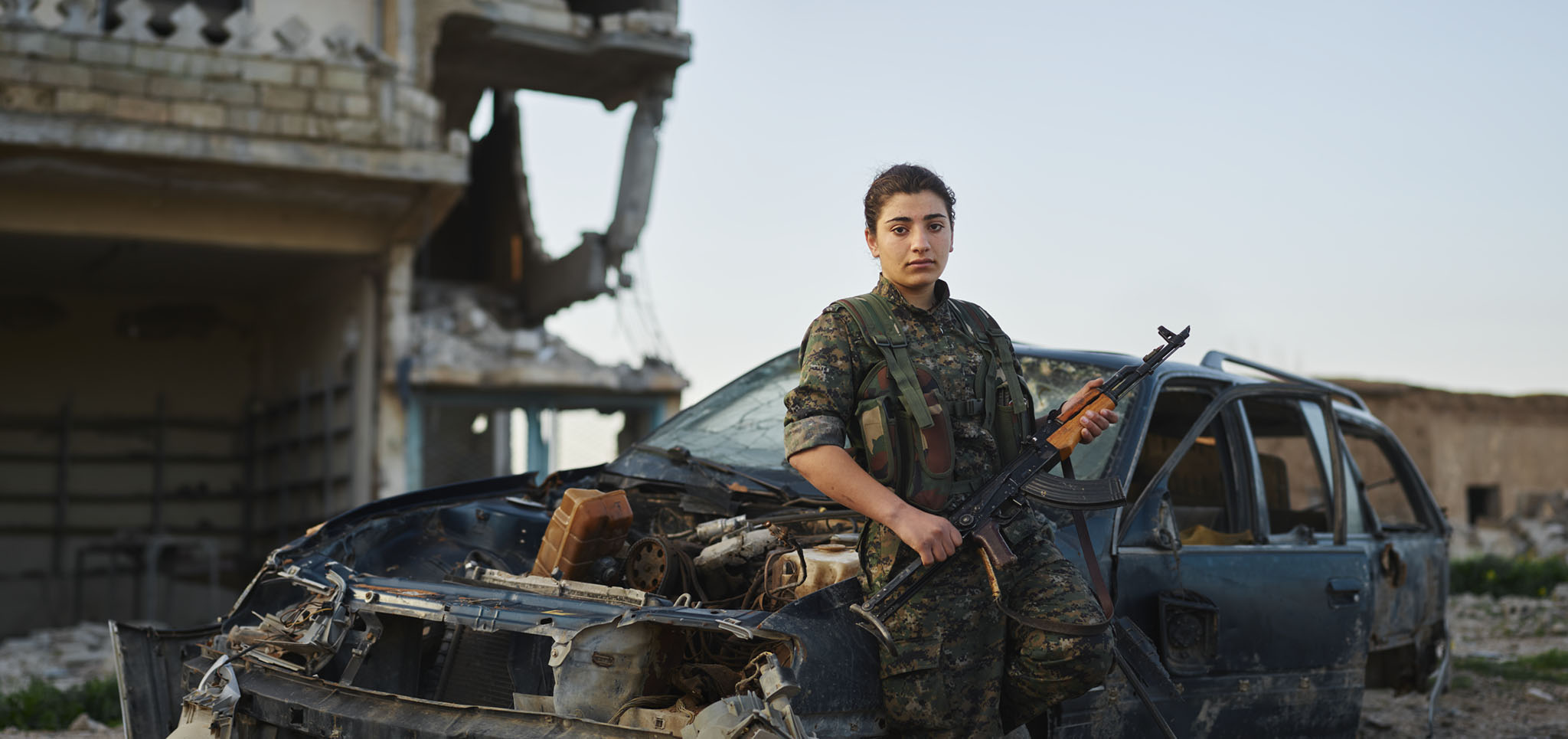
Sorxwin, March 9 2015, Tel Hamis, Syria
Prologue
Every generation seems to grow up with the memory of at least one major war in his or her lifetime. Whether we choose to read the headlines or acknowledge the reality beyond our own everyday lives, the war that is currently underway in Iraq and Syria is one that affects us all. As a Kurdish soldier would tell me later— this conflict has been churning for centuries, but remains hidden from most of our views.
Like the rest of the world, I watched the Syrian Civil War escalate from simple protests to a full blown conflict between the Syrian regime, rebel militias, and jihadist organizations like the Islamic State and Jabat al Nusra. Ignoring the political demarcation of Syria’s borders, militant groups began to redraw their own territorial boundaries further into Iraq. Each heavy-handed stroke brought further destabilization to an already embroiled, war-torn region with deep-rooted sectarian tensions.
Seemingly without warning, Mosul— a densely populated city approximately 350 km north of Iraq’s capital of Baghdad— fell into the hands of the Islamic State, allowing the organization to capture ample amounts of American-made weapons. The militant group used this as an opportune moment to reinforce to their devout followers and Twitter-cheerleaders the rather absurd idea that some divine prophecy was at work— and an ancient Islamic Caliphate was being re-established. Leading up to this moment, the most effective fighting forces against the so-called Islamic State, or ISIS or ISIL as we see it being referred to in the press, were Shia militias with American blood on their hands, and the Peshmerga, a fighting force loyal to the Kurdistan Regional Government (KRG), which is the governing body of the Kurdish region in Northern Iraq.
In this massive game of chess, there was another distinct grassroots movement that caught my attention— Kurdish guerrilla groups known as the Kurdistan Worker’s Party (PKK), People’s Protection Units (YPG), and Women’s Protection Units (YPJ). These seemingly ragtag armies are in fact quite agile, effective and organized.
The Kurdish people number around 40 million— whose homeland is spread across vast swaths of Turkey, Syria, Iraq, and Iran. They are considered to be the largest ethnic group that do not have their own country. This is important to note, because as you’ll find out, they have something, which they believe is worth fighting for— a long-awaited independence and region to call their own.
During my initial research, I couldn’t help but notice that there were many theories as to whom these Kurdish guerrilla groups were. The foreign press often romanticized the females in their ranks as fearless warrior women, while some of my Turkish friends suggested that they were terrorists, operating more as opportunists in a bloody war. I set out to uncover the truth, or at least to better understand the nuances behind the headlines. Portrait photography has a strange way of humanizing even the most distant of situations, and that was my goal with this project.

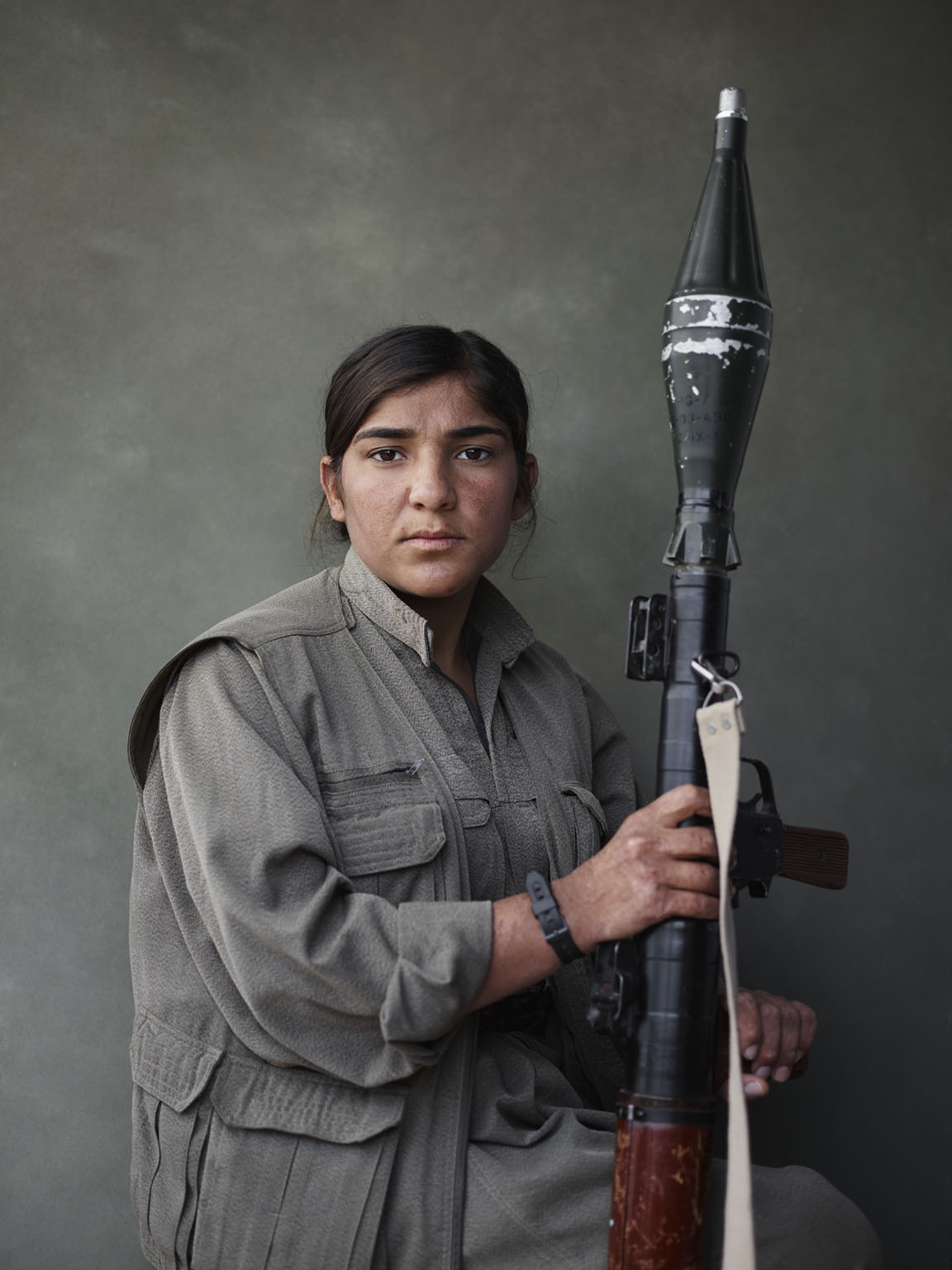
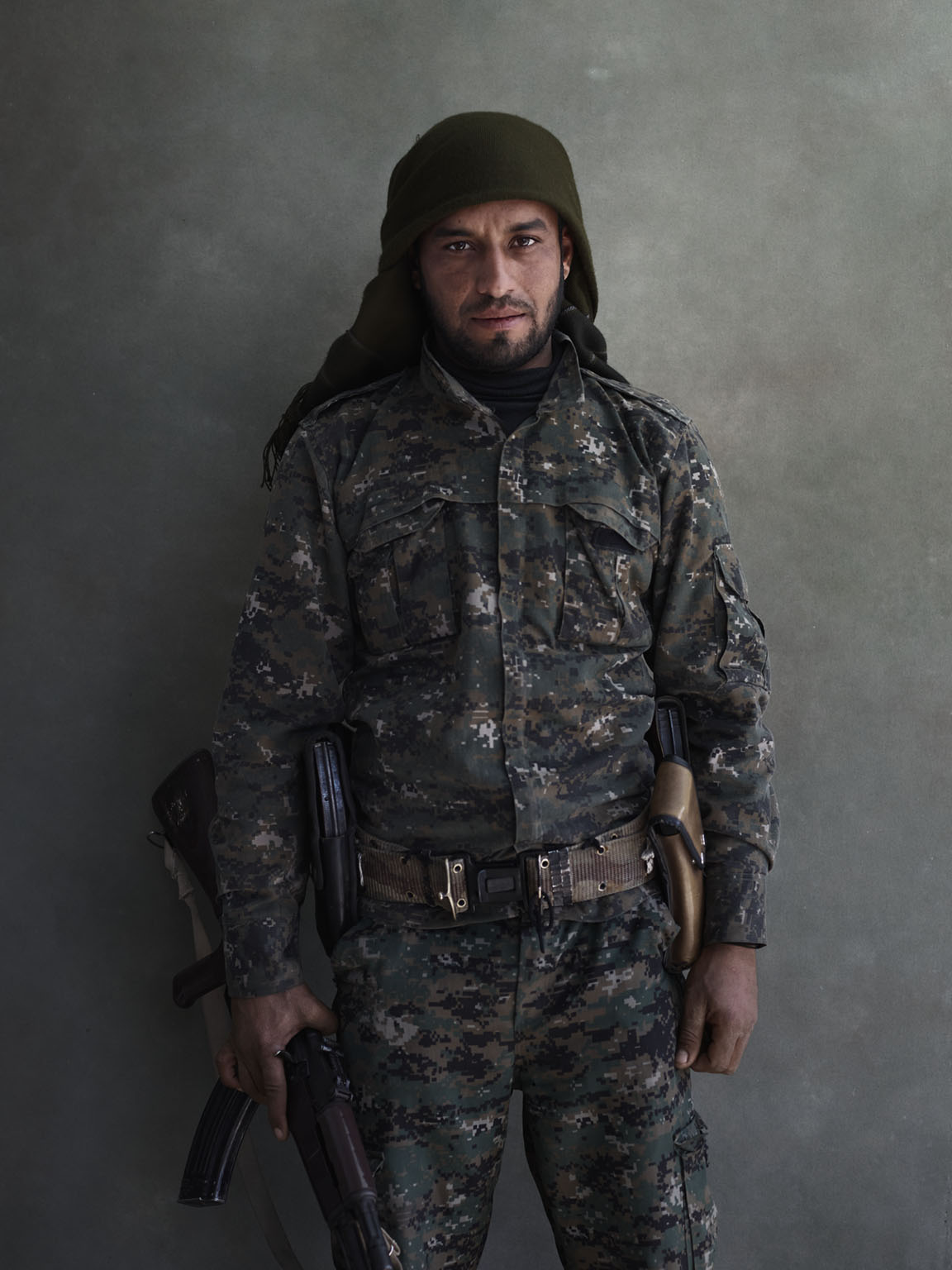
Top & Right: Ugab, YPG, Tel Hamis, Syria –– Left: Sarya with RPG, PKK, Makhmour, Iraq
New York City to Sulaymaniyah
It was already nighttime when the taxi rolled up to the entrance of my studio. My friend and colleague Caleb helped me pack the trunk with all my gear. Camera kit? Check. Flash? Check. GoPro?— A last minute addition: Check. Too much shit as usual. We both hopped into the car. The sound of the doors closing punctuated the stillness of the air. It was quite a few hours before my plane would depart JFK airport, but I wanted to give myself plenty of time to check in; I knew there could be a good potential that I would be questioned as to the motivations behind my itinerary. In just a few hours, I’d be boarding a plane to Sulaymaniyah, Iraq by way of Istanbul.
Upon reaching the airport, Caleb helped me hoist my six cases of well-packed photography equipment to the sidewalk and over to the check-in counters; he departed shortly thereafter. I would be taking this trip alone. As a self-funded, independent project to an area that was war-torn, I felt it was far too dangerous— or quite simply asking too much— to bring the people I normally work with. With that said, I’d be in the careful hands of my local fixers Jan Ezidxelo and his wife Ipek, whose responsibility it would be to keep me out of harm’s way for the duration of my trip.
The check-in counter is where the adventure truly began… After all, I wasn’t exactly headed to Cancun (sorry, mom). As soon as the Turkish Airlines attendant swiped my passport, a paleness spread across her face. She abruptly got up from her position at the counter with my passport without any kind of explanation. I pretended to not know what was going on, but I knew deep down what was happening. About fifteen minutes later she returned with two gentleman. At first glance, you wouldn’t have been able to identify them from any other person at the airport. They wore everyday clothes and their only distinguishing characteristic was the badges they would flash at me from underneath their jackets, identifying them as Homeland Security. My passport was flagged.
They spoke with me candidly, their language personable but tactical. Part of me would have loved to demand my privacy and go full-blown Edward Snowden on them, but the guys were professional, knowledgable and asked all the right questions. “That’s a strange itinerary you have; what are you planning on doing in Iraq? What kind of photography do you do? So no one is sending you? You’re freelance? How does freelance photography work?” These were just some of the things that I was asked.
I knew I had no incriminating evidence to hide, so I leaned against my equipment cart in a relaxed manner. I showed them some of my work on my phone. As I swiped across the screen showcasing everything from my recent shoots with the U.S. Army to National Geographic Channel, I could tell that their fixed gazes were not focused on my work, but more on how my hands appeared— were they shaking? They were looking for any incriminating evidence that would potentially show I was lying about my reasons for going to Iraq. I was let go after thirty minutes of questioning. As a matter of principle, I thanked them for their service and was on my way.
It’s not surprising my itinerary was suspicious. According to International Business Times, it is estimated that 20,000 foreign fighters from across 40 countries have left to join the Islamic State group; and an estimated 3,400 of that 20,000 are reportedly Westerners. I can see how a 25-year old traveling solo via Turkey, (the most common entry point into Syria), whose clothes are mostly black might sound some alarm bells. As Homeland Security walked away, I couldn’t help but wonder if this will become a regular routine every time I travel. Regardless, I finished my check-in with time to spare and would soon be off on my journey that would take me to the bases and the frontline of Kurdish guerrilla forces that were in fact, fighting groups like the Islamic State.
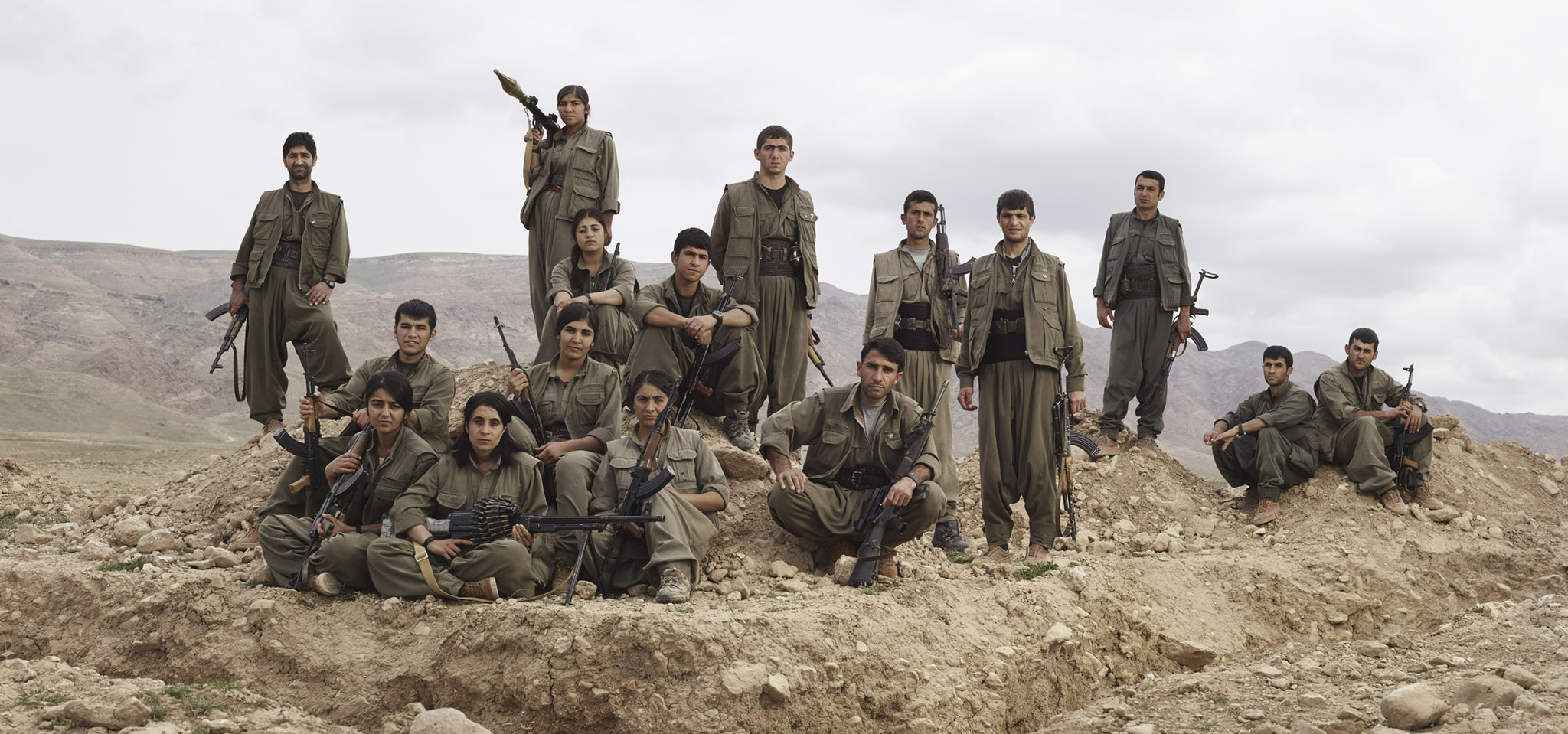
PKK Guerrillas Pose Near Makhmour Trench Position, Makhmour, Iraq
My lonely chair in the sky granted me many hours to ponder my own motivations until I finally arrived into Sulaymaniyah around 4AM. I was greeted by Jan and his journalist friend, both who were initially quiet, observant and very helpful. The airport looked rather modern, but you can tell— due to all the safety precautions— that it is located in a country at war. Firstly, you’re not allowed to drive a vehicle up to the airport gates due to the fear of car bombings, so the three of us took the gear to a little airport bus that would drive us outside the airport boundaries. Once there, we loaded the gear into Jan’s friend’s tiny car. We had to roll down the window to stick one of my cases out and the three of us sat uncomfortably shoulder-to-shoulder with Jan’s friend at the wheel. I needed to break the ice, so I made it clear that I was fully aware the driver’s hand was reaching beneath Jan’s ass every time he shifted a gear. They laughed. I knew I was in good hands.
It was 5AM by the time we reached Jan’s house. The darkness of the night was only broken by the orange sodium vapor lights indicative of the city. The entire area was nestled between vast mountain ranges— Sulimaniyah's very own sentinels, which have inadvertently protected the city in both historic and modern times.
I was absolutely starving, so Jan rolled out a plastic mat and set out plates of Kurdish cheese, flat bread, peppery spices and olive oil. As I soaked up the olive oil with the bread, the two men asked me questions about my photography in Ethiopia. I got the sense from their technical questions that they were trying to draw a conclusion as to how I might portray the Kurdish guerrilla fighters.
The conversation soon turned to mapping out our plans for the next two weeks. “My photography is portrait-driven and although there is a lot of equipment here, I take simple pictures,” I said, still chewing on the bread. “I want to take portraits that visually portray the conflict, but they don’t necessarily have to show fighting on the front lines. What else is there that may give visual clues of war?”
“You can find flags, bombed out buildings, destroyed cars,” Jan responded in a hushed tone so as not to awake his sleeping wife. “If we go to Kirkuk, you’ll see ISIS’s black flags still hanging. One thing I would like to show you,” he continued, “is the evidence of the genocide against the Yezidi.”
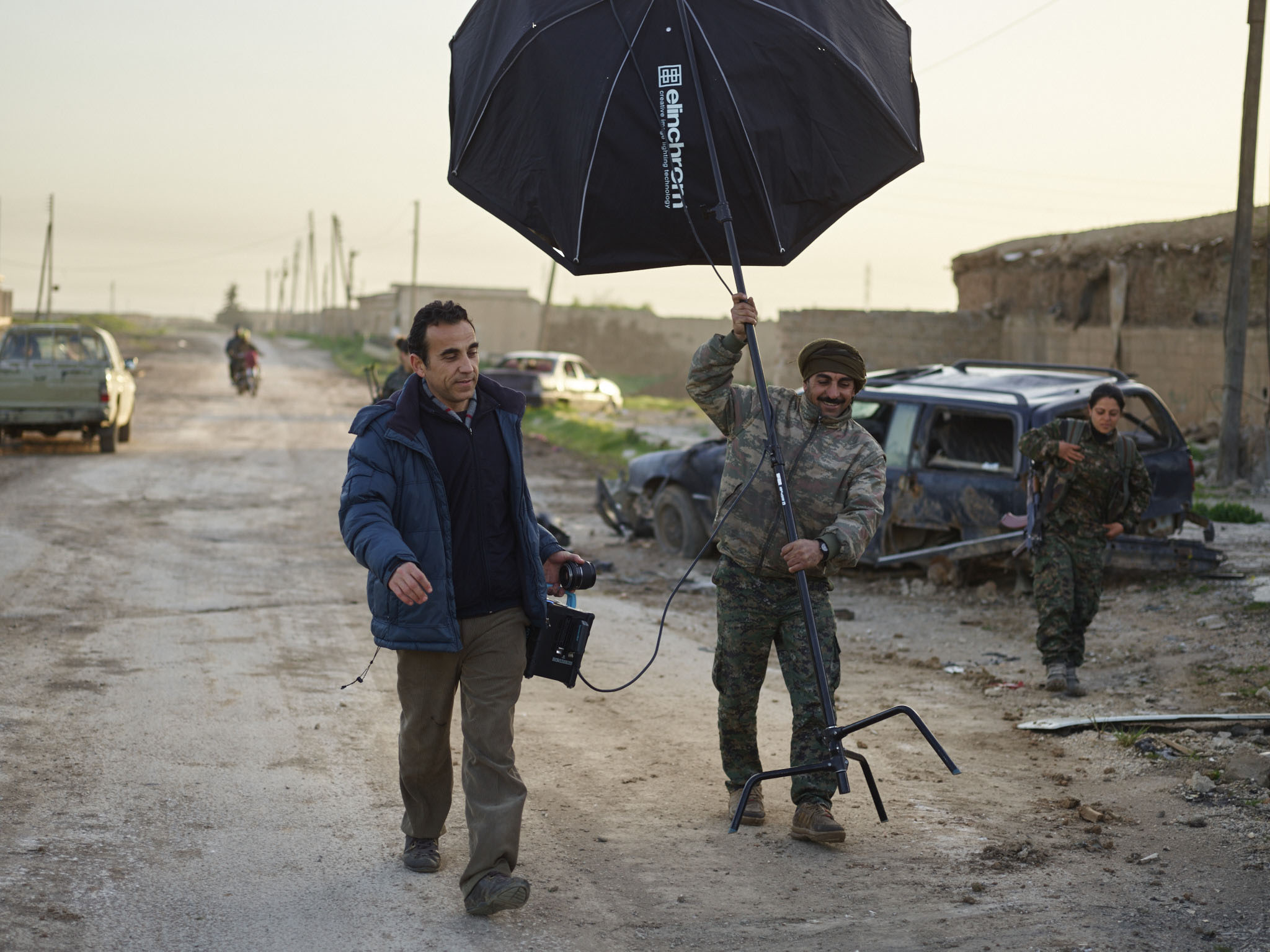
Jan Ezidxelo and Mehmud of the YPG assist me in Tel Hamis, Syria
With a plan in place, we went to get some sleep for a few hours, but admittedly I was far too excited to get any shut eye. I lay on my side watching House of Cards on my laptop, but couldn’t keep my focus. Instead, my mind raced with the thought of going to visit a PKK base in Makmour— our first destination on the journey. Sometimes when you have to perform well on assignment, you want to get a good night’s rest, but here I was with no way in hell that I could sleep— kept up by my own rush of adrenaline. However, I had a lot of time, and I knew one sleepless night wouldn’t change anything.
It was 9AM when everyone awoke to start the day. After a short breakfast, Jan rolled out the map and we reiterated an itinerary that we had first started discussing a month before. We would leave west from Sulaymaniyah towards Kirkuk, hook northward to Erbil and descend back down eastward to Makhmour. After spending some time there, we would horseshoe around the northern parts of Iraq via Duhok and Zakho to avoid ISIS-controlled regions as much as possible. Then, we would enter Syria via a river crossing. Areas with frequent clashes like Tel Tamir were ideal but to be determined, as the situation can change day by day. Afterwards, we would head south and enter the city of Sinjar by the mountain range of the same name. If this seems confusing, it is. A simple Google Maps itinerary would lead you on the quickest route: directly through Mosul and into an Islamic State checkpoint. Unfortunately Google Maps doesn’t have an “avoid ISIS” button, as it does for traffic and tolls. This is why anyone working in this area needs well vetted local fixers. Jan would travel with me while Ipek stayed behind and co-ordinated with their contacts within the guerrilla groups.
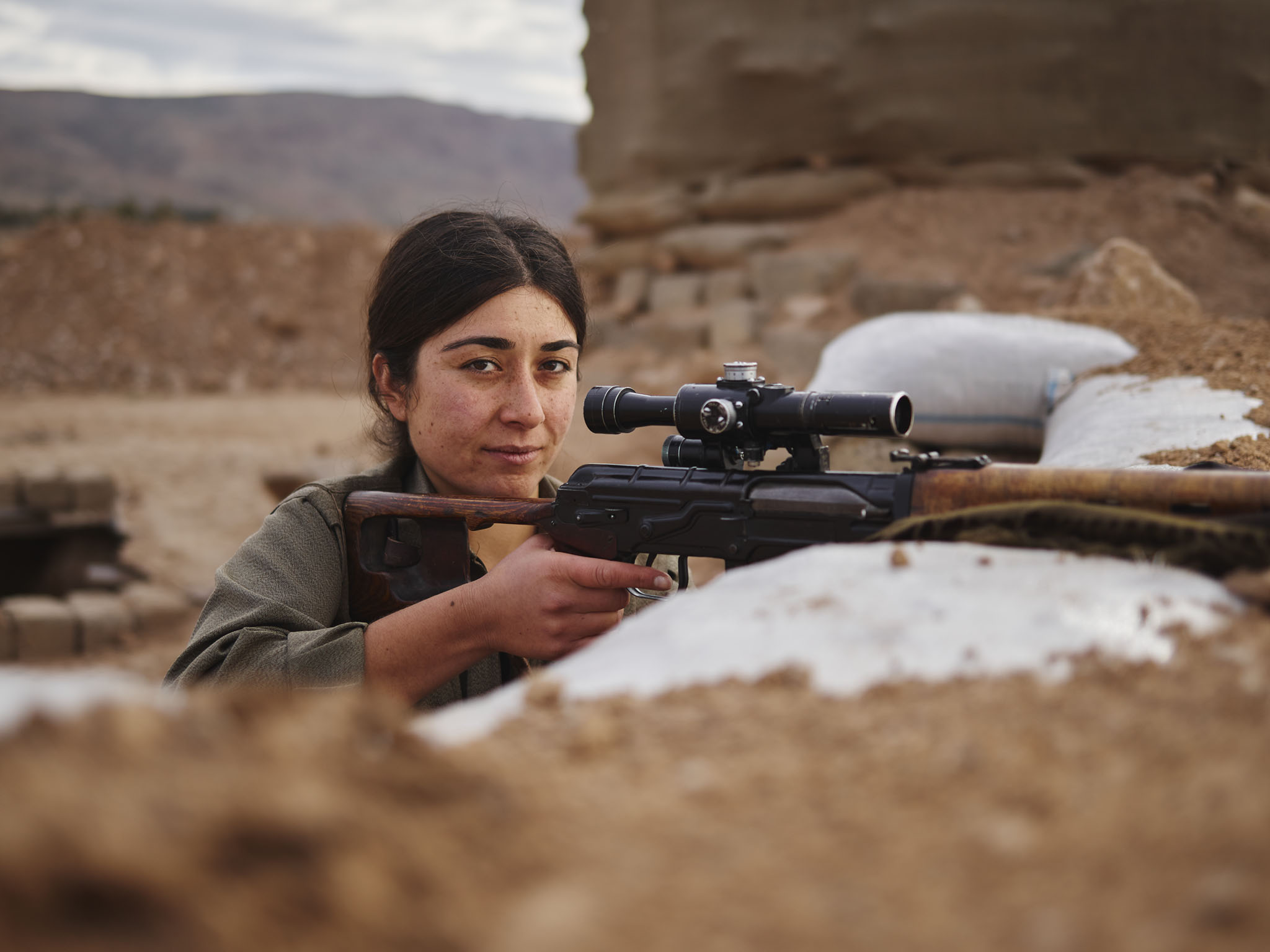
Tekoshin, PKK Sniper, Makhmour, Iraq
Makhmour, Iraqi Kurdistan
Even though we set off early from Sulaymaniyah, we didn’t roll into Makhmour until nightfall. Every 20 minutes there was a security checkpoint, though you’d be a fool to argue their importance. In larger cities like Erbil, the Peshmerga patrolling the checkpoints would insist on inspecting everything, and since I had more than a few suspicious-looking cases, it would take quite a while before we could pass. “You’re from Canada?” Asked a Peshmerga guard, “Tell your government to send us better weapons.”
Eventually, we reached our destination- a PKK base near the front lines of Makhmour.
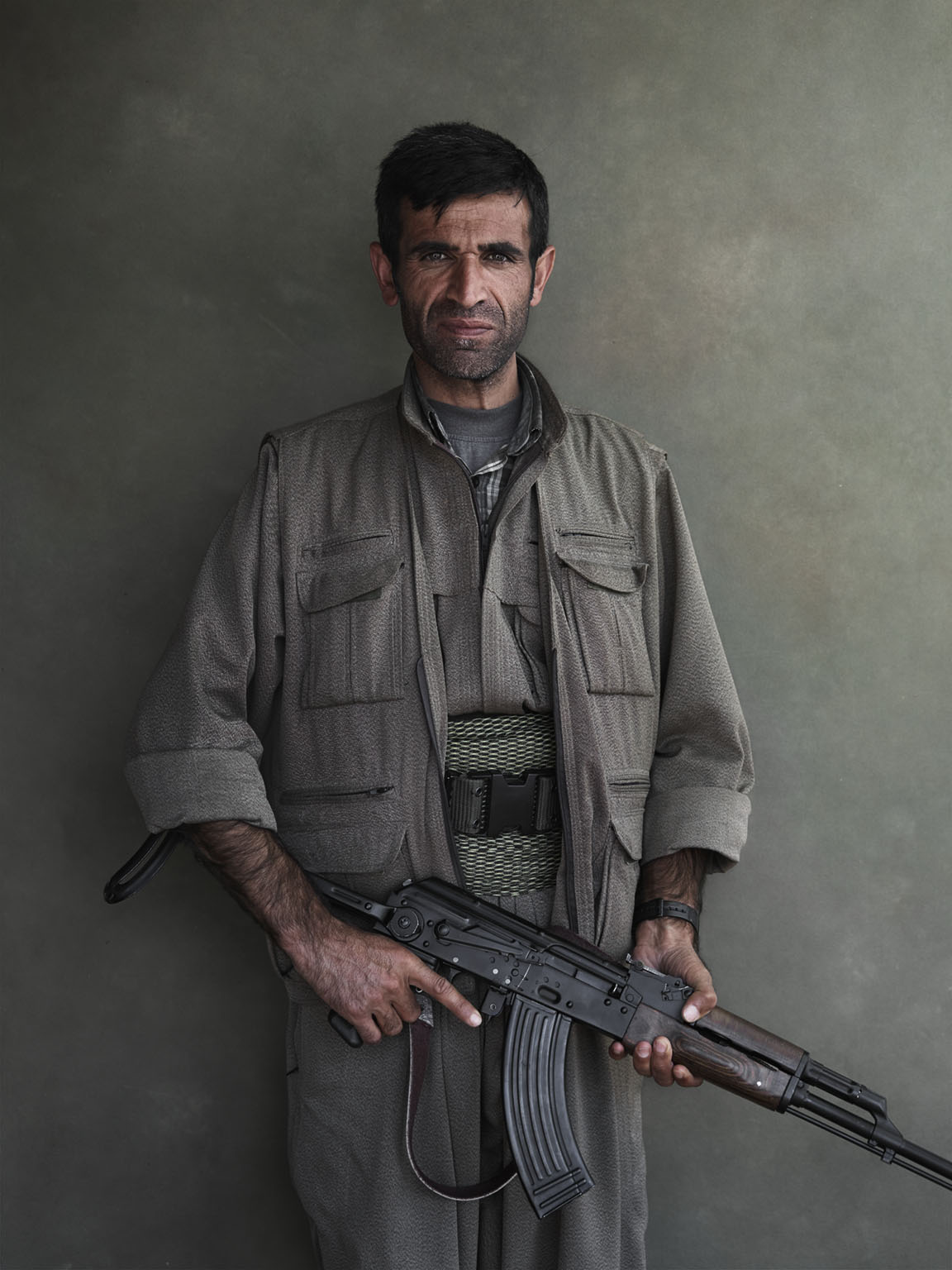
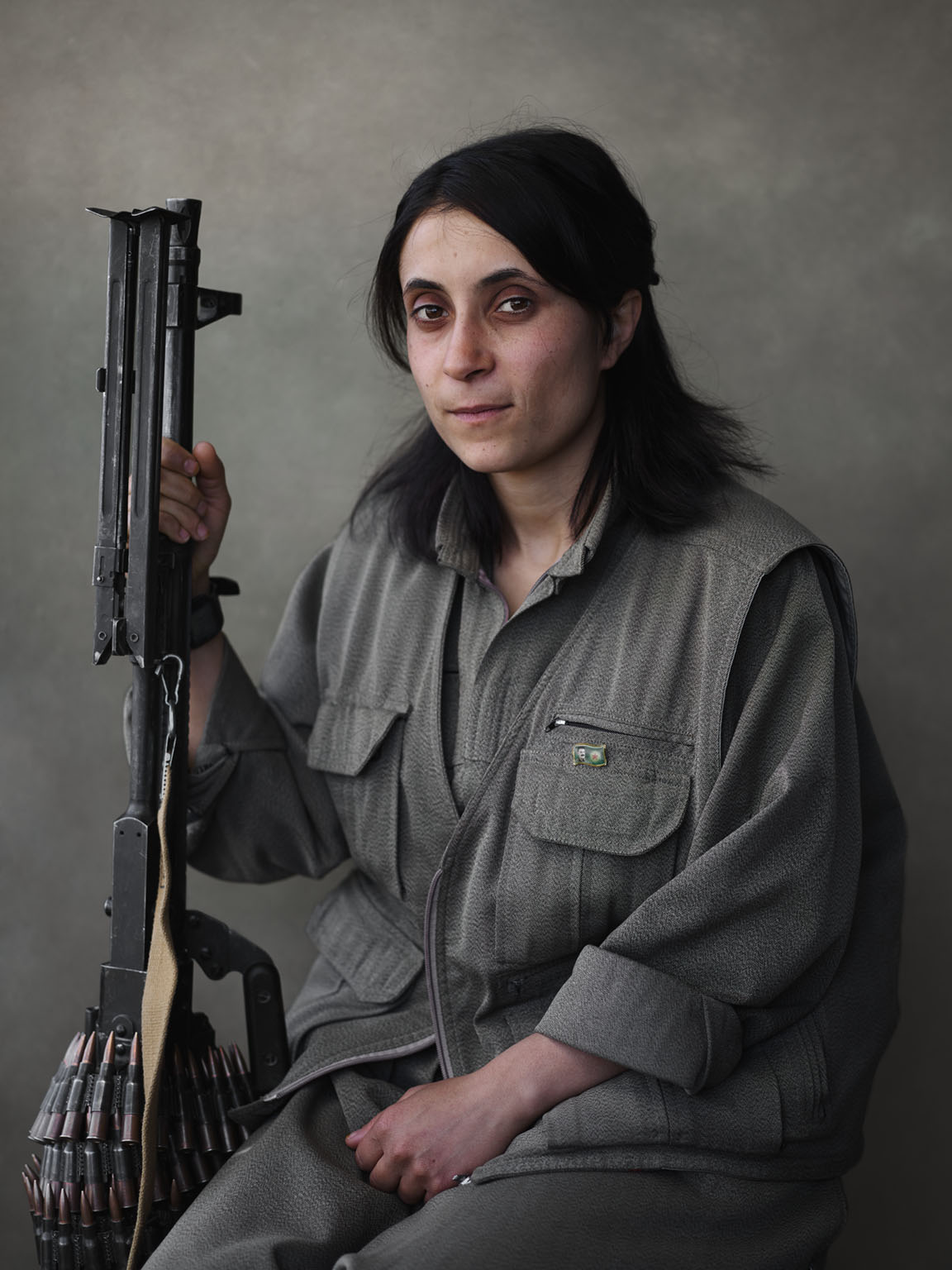
Members of the PKK Rukal (left) and Ruken (right)
My first morning was met with a great calm. I immediately felt safe among the men and women of the PKK. Working in between their training sessions, I walked with guerrilla fighters single-file to a hilly outcrop to capture some portraits. The women may be diminutive but are actually formidable. Some carry the signs of a hard-fought war: chemical burns, chapped hands and scars. All the women are treated as equals to their male counterparts, but it is the men who will readily admit that a woman can fight better because she is a natural creator of the world, so she therefore has more to lose— and therefore more to fight for.
The countryside of Makhmour doesn’t strike you as a typical battlefield. As we traversed up to a high outcrop, you could see endless stretches of rocky, rolling hills generously cloaked with violet flowers. I snapped a few shots of the PKK fighters emerging over a purpled hill in the distance. The earthy-tones of their traditional Kurdish outfits seemed to emerge from the landscape, while their braids swayed as they walked with Kalishnakovs slung over their shoulders.
However deceiving the idyllic landscape can be, Makhmour is the site of fierce clashes between Islamic State militants and Kurdish forces. At the time of my visit, the Islamic State had lost the city and was 15-20 km away, defeated for the time being and spread thin over multiple fronts. A couple weeks after my visit, the Islamic State would regroup and launch a barrage of assaults and suicide attacks.
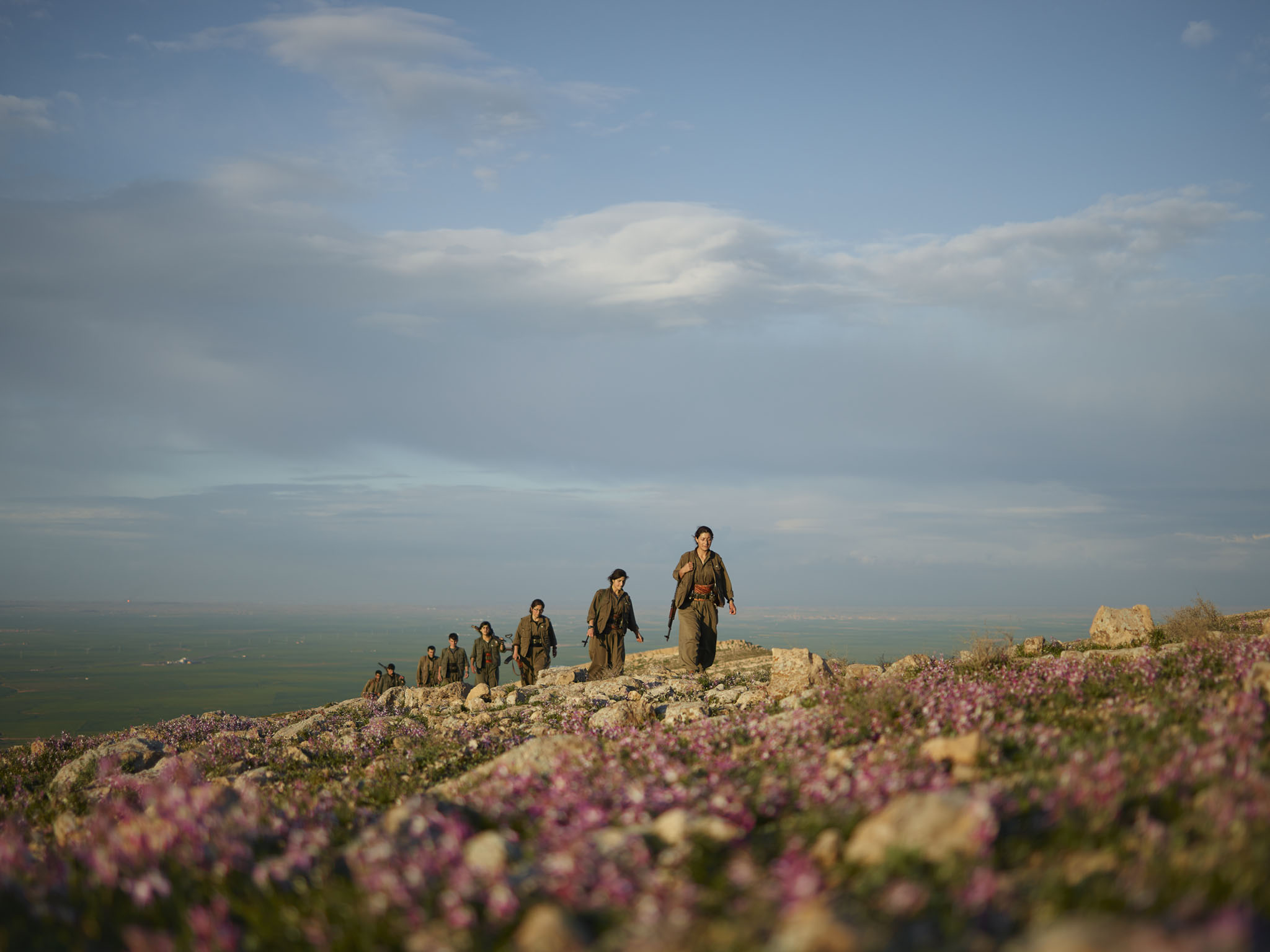
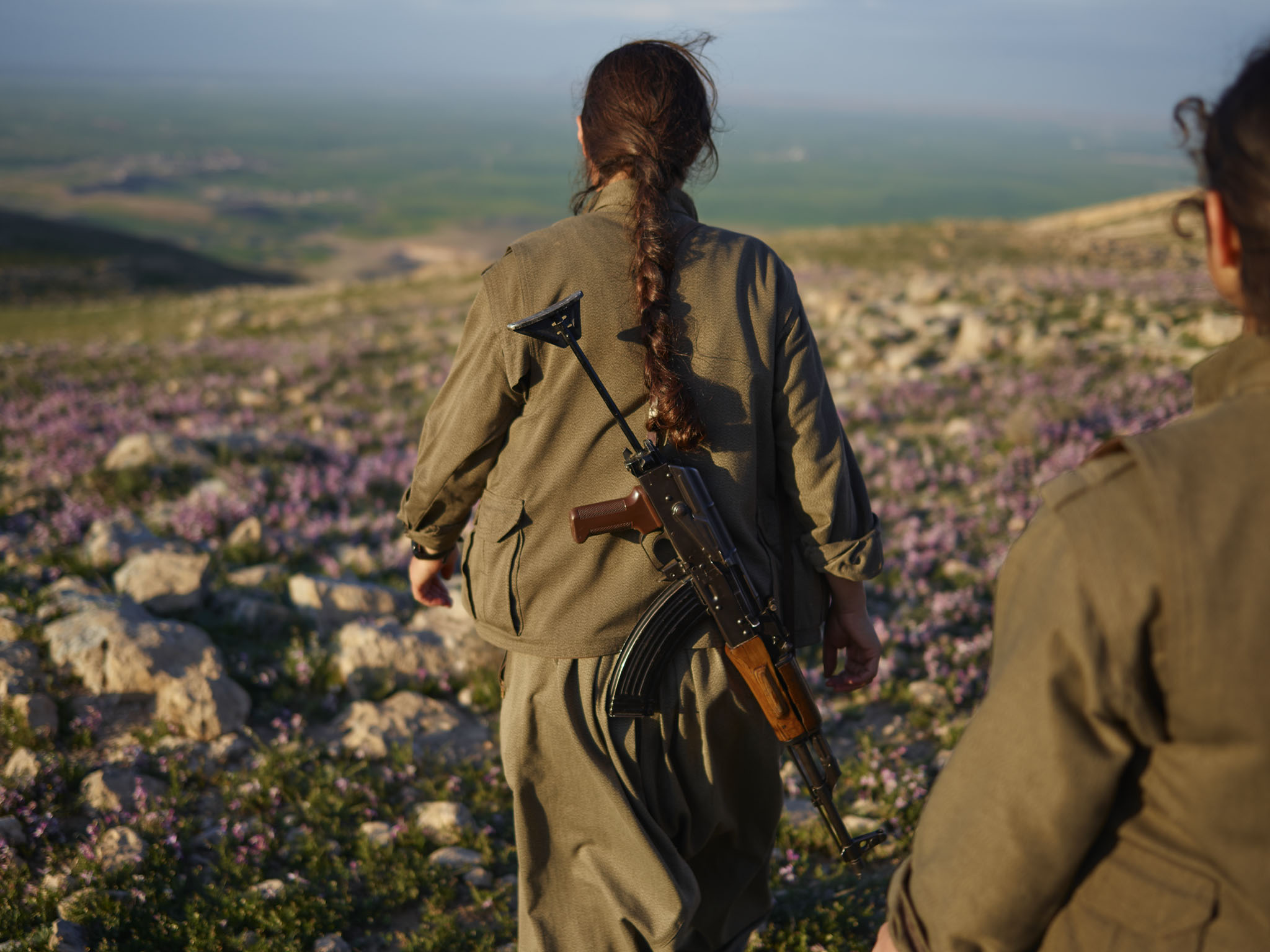
Kurdistan Workers' Party (PKK) Guerrillas Patrol Makhmour Countryside, Iraq
The official military of the Kurdistan Regional Government, the Peshmerga, get a lot of attention in the press, and rightfully so. They have proven integral and highly effective in strategic battles, including the fight against ISIS for Mosul Dam. However, most residents and refugees will also tell you that guerrilla groups like the PKK play extremely decisive roles in battles against ISIS. To many, they are local heroes.
An important distinction must be made, however, between guerrilla organizations like PKK and the Peshmerga. The Peshmerga are financed by the KDP and PUK— the two official governments of Kurdistan. As a result, they have access to some better weapons and vehicles, and collaborate more with coalition forces. The guerrillas, on the other hand, fight with light weapons, and are often overlooked by the outside world as a viable force. This has less to do with their fighting skills and more to do with a problematic and convoluted history.
The PKK is internationally listed as a terrorist organization— a label that has existed for the past thirty years or so, and one that has proven difficult to peel off. Within six years of PKK’s formation in 1978, they turned militant against the Turkish government. They vehemently assert that their stance has evolved since then from a separatist movement fighting against Kurdish oppression— to more of an ideological, internal struggle for democratic values throughout the entire region. This “coming clean” has proven effective to a certain extent. Even though the PKK is considered a terrorist organization by the United States and is on the same list as ISIS, ironically here in Makhmour they’re supported by coalition airstrikes.
Studying the ideology of their leader Abdullah Öcalan, the PKK leave behind their families and material possessions to begin a lifelong dedication to the Kurdish resistance. Abdullah Öcalan (“Apo”), their revered leader and father of the movement, updates the ideology from a prison cell in Turkey, where he is viewed as a terrorist leader. If you look up just about any article posted online about the PKK, you can find a heated cyberwar in the comments section between Kurds and Turks. To say the issue is a sensitive one is an understatement. And though Apo is behind lock and key in Turkey, in Kurdistan his visage flies freely, emblazoned on flags, framed portraits, wall clocks, necklaces, and iPhone cases. The list goes on. With the conflict with Turkey simmering down, perhaps fighting a new enemy like the Islamic State has given the PKK credibility on the world’s stage.
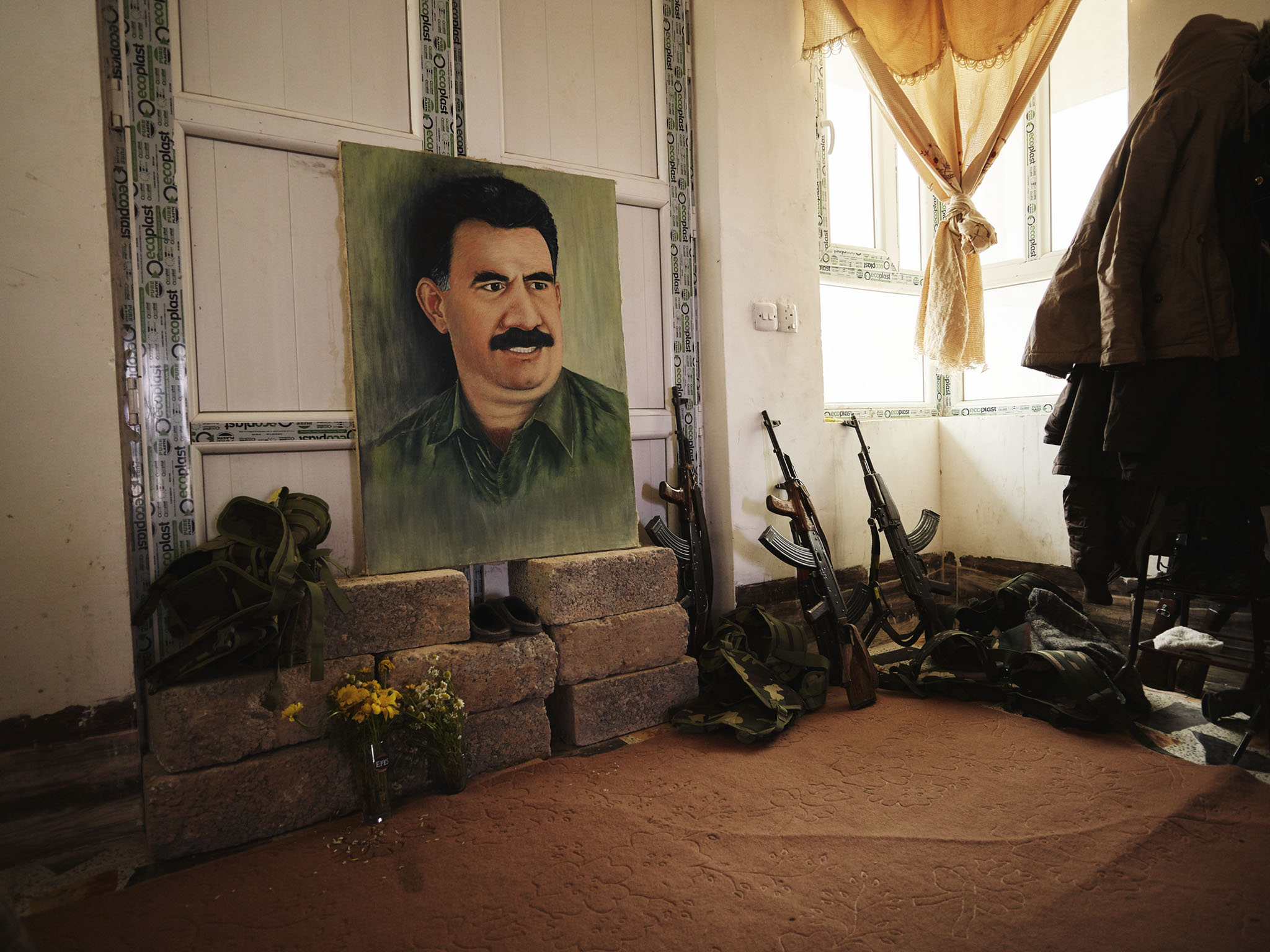
Painted Portrait of Abdullah Öcalan
Admittedly, my first personal encounter with the PKK took me by surprise. I was not quite prepared for the hospitality I was shown when staying at their base for four days. They insisted that I never carry my own bags, I was always offered tea first, and the conversations were lighthearted yet inquisitive. Their reputation as feared fighters against entire armies of jihadists seems to vanish after spending just a few hours with them.
The waning moments before twilight over the valleys cast a rich golden hue over the landscape. Yet, due to the nature of the surrounding sandy mountains and pitted, rocky outcrops, a good portion of the terrain falls captive to night’s shadows. As it grew darker, the small specular highlights of embers started to form in the distance, marking the presence of oil fields— a telltale sign that this area will be hard-fought for other reasons as well. My focus shifted for a moment to what I had before me: a few of the female guerrilla fighters were sitting down, chatting and taking in the scenery. I snapped a shot— a smile captured amidst the murky blue twilight.
Many of the PKK's dwellings are hidden in the landscape, tucked into a mountain corridor or carved out of the land with uncanny precision. At first pass, you may not think that humans live there, but as I would soon find out— they are everywhere— in every crook and crevice. Traveling along a nearby road, I stared up at the tree canopies and noticed strange large “nests” hidden among the leaves. “What birds create those nests?” I asked Jan motioning my head over to a row nearby. “Not for birds,” he said smiling.
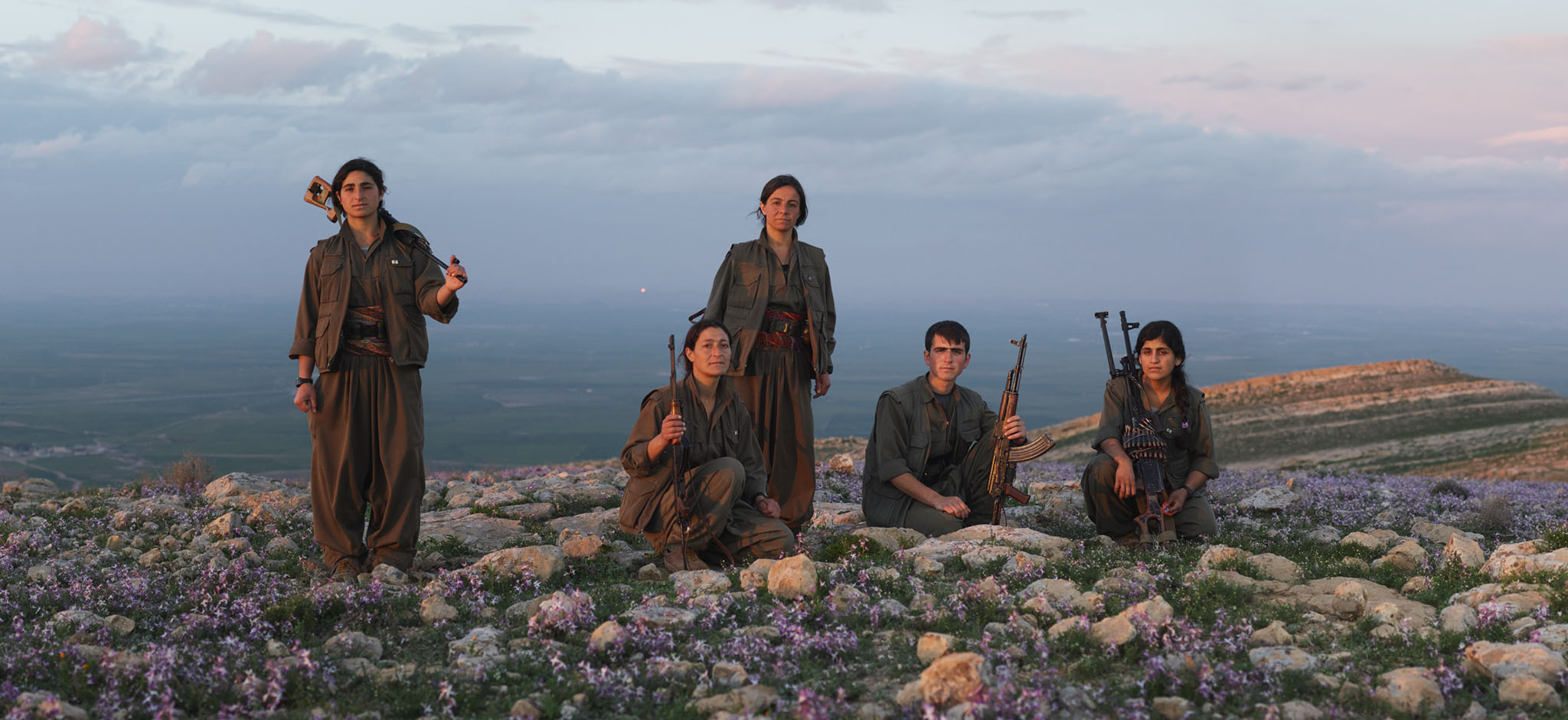
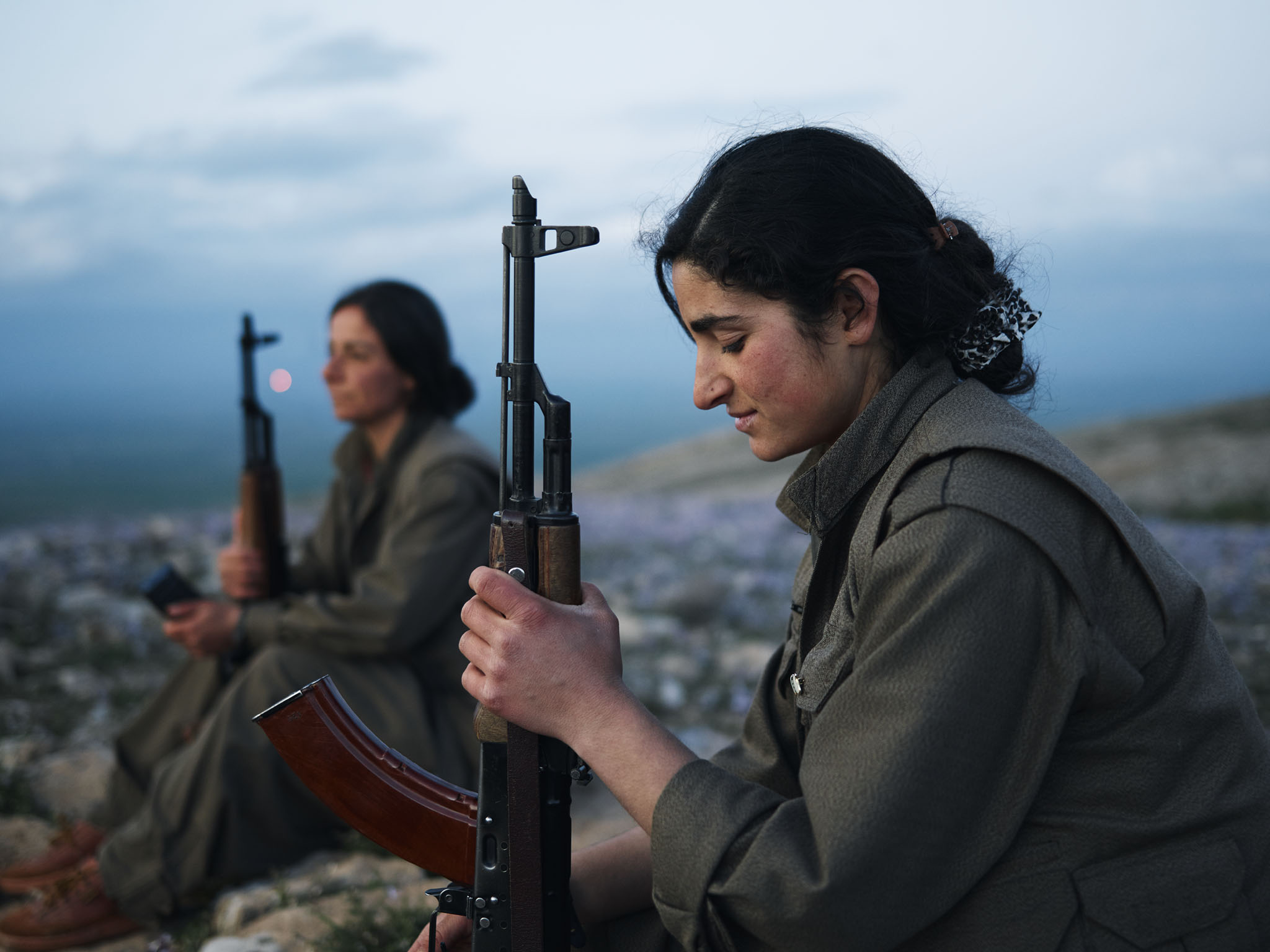
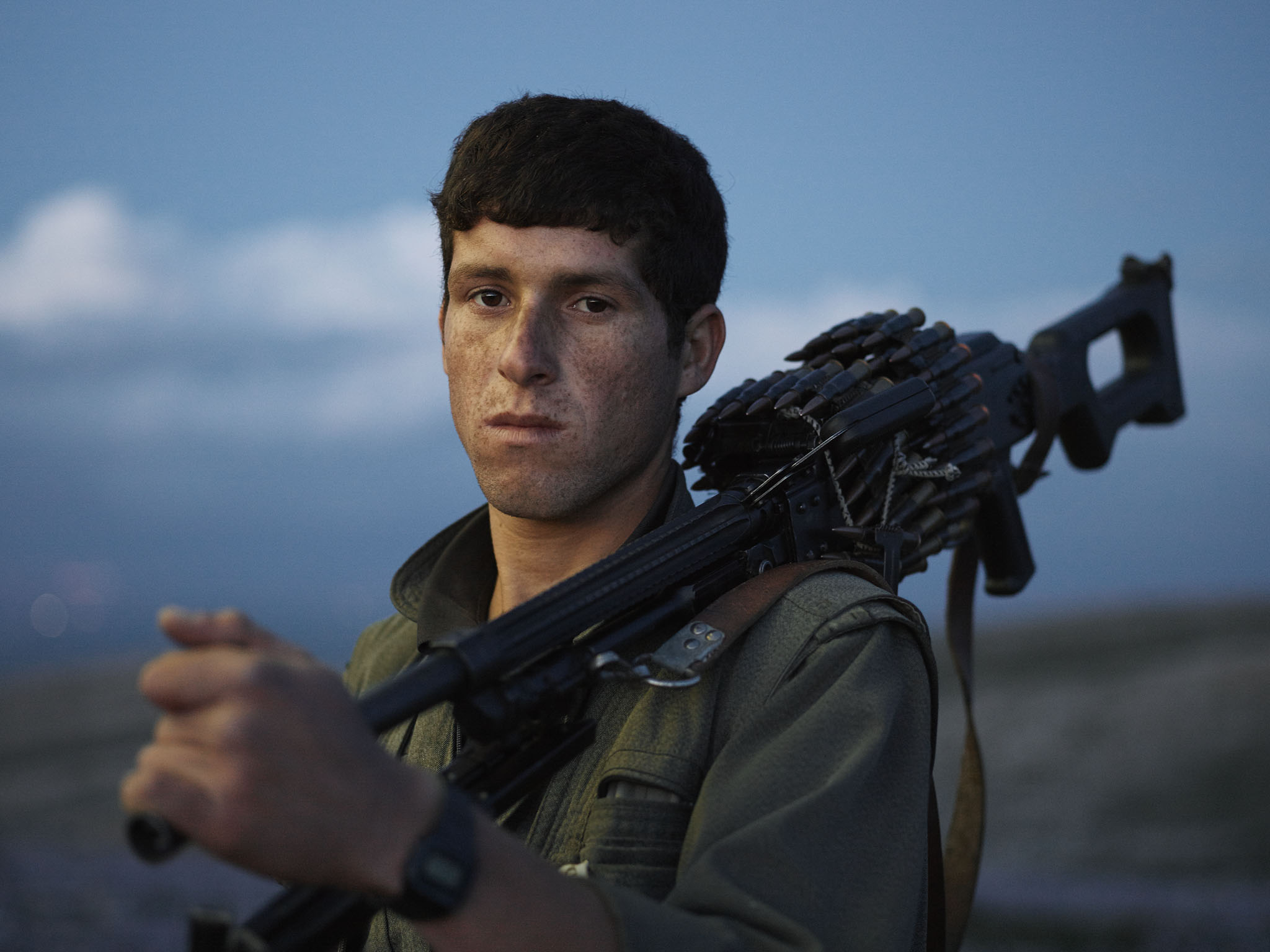
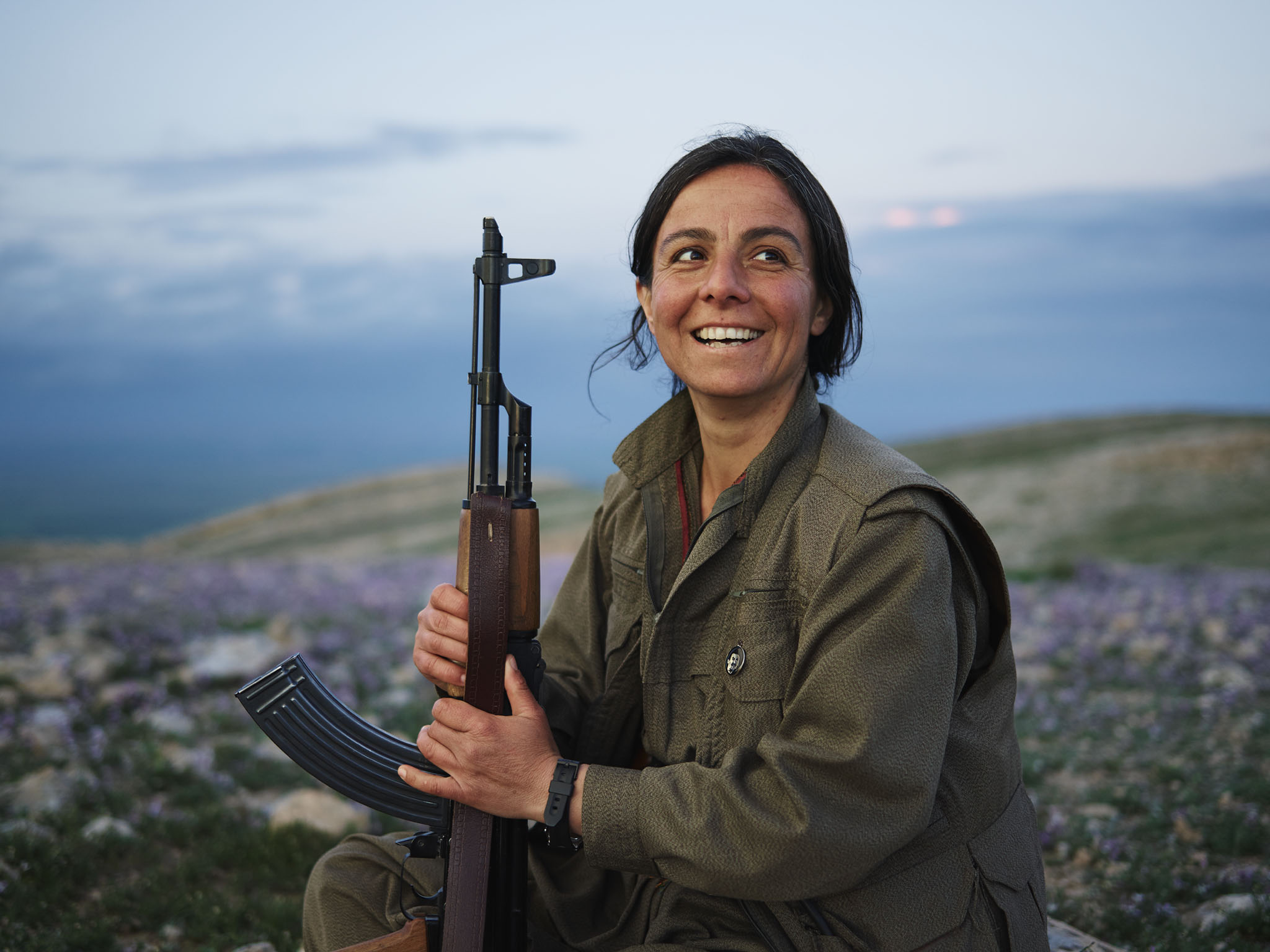
Berivan, PKK Commander, Makhmour, Iraq
It was late in the evening when we made our way back to basecamp. I was invited for a meal and tea so I followed my hosts into one of their concrete cinderblock buildings. Its interior was lit by a single fluorescent light in the center of the room. The housing was simple and contained only the basic necessities you would expect to find in a monk’s ashram. The few sleeping mats and pillows were kept to one side and were always clean and neatly folded. For a few hours at night, electricity pulsed with an audible buzz from a small gas generator. The only entertainment was a television set constantly updating us with news from the war’s frontline. A sole bookshelf, rich in reading material, stood out from the other humble belongings. After all, the PKK do not consider their ideology just a military movement for warriors, but also one for well-read intellectuals. It is common to see PKK members from all backgrounds— university students, teachers, farmers, as well as youth who didn’t feel they belonged in mainstream society and sought an alternative clique. After the PKK’s weapons were hung on a makeshift wooden rack by the door, we sat together on the floor around the food and spoke in a sort of strange cultural exchange.
“So does your country really think we are terrorists?” Berivan, their photogenic commander, asked, half-jokingly, half-serious.
During curious rounds of questioning on both sides, the chatter in the PKK camp came to an abrupt halt as the TV began to broadcast portraits of guerrilla fighters who had died fighting the Islamic State in the countryside of Kobani, where ISIS had retreated and continued to launch assaults after losing the city by the same name. An uncomfortable silence fell over the room. Even though the PKK doesn’t publicly disclose the numbers within their ranks, all members consider themselves brothers and sisters and know each other from sharing various bases, battles or ideological summits. Although the guerrillas were still on the offensive— it had been a brutal day.
Rojava, Syrian Kurdistan
There are no longer official Iraq or Syrian border crossings that are controlled by those governments. At this point, all official and unofficial border crossings between the two countries are in the hands of the Kurds and The Islamic State. To show how quickly this war changes, a few days into writing this, the crossing of Al-Tanf on the Syrian border in the Homs Province was seized by the Islamic State shortly after they took over the historic city of Palmyra. In the Kurdish areas towards the north, there is one principle “informal” crossing, which is the one I would take to get into Syria. After a few hours of waiting, we boarded a rickety wooden boat, which typically brings displaced peoples back and forth between the two regions.
If there is one thing that both Kurdish guerrilla groups and the Islamic State can agree on, it is a strong rejection of the Sykes-Picot agreement of 1916. This clandestine agreement— largely led by the United Kingdom and France— partitioned the areas of the Middle East during World War I, should the Ottoman Empire fall. These colonialist borders form the countries we know today, without any consideration for ethnic or cultural lines. Even the term “Middle East” is a colonialist term, referring to Western Asia’s location when viewed from Europe. It is this same agreement that put many of the royal families and lineages of dictators we know today into power, and many argue has ultimately contributed to the mass instability in the region. When the borders were drawn and lands distributed between colonial powers and rulers in Turkey, Iraq and Syria, the “Land of the Kurds” was knowingly omitted.

YPG Patrol Truck, Tel Hamis, Syria
After the escalation of the Syrian Civil War, dictator Bashar Al Assad’s loyalists lost control of a corner of Northeastern Syria. Without the presence of the Syrian military, the Kurds were organized enough to quickly take advantage of this rare moment in history and declare the region as “Rojava,” a de facto autonomous region of Syria. Meaning “West”, Rojava is viewed by many as “Western Kurdistan.”
It was quite auspicious to be traveling through Rojava during International Women’s Day. It’s a festival that has much meaning, particularly in war time. Even from a distance, you could hear the music and see colorful flags waving in the breeze. Women and men linked arm-in-arm were dancing. Festival-goers were dressed in both traditional dress and colorful ceremonial pieces. Apo flags were on display, women held framed pictures of their sons and daughters who had been martyred in war, traditional dancers took the stage, and motivational talks were shouted from inspirational leaders. It was here where the revolution for democracy and gender equality manifested itself in all-out celebratory reverie.
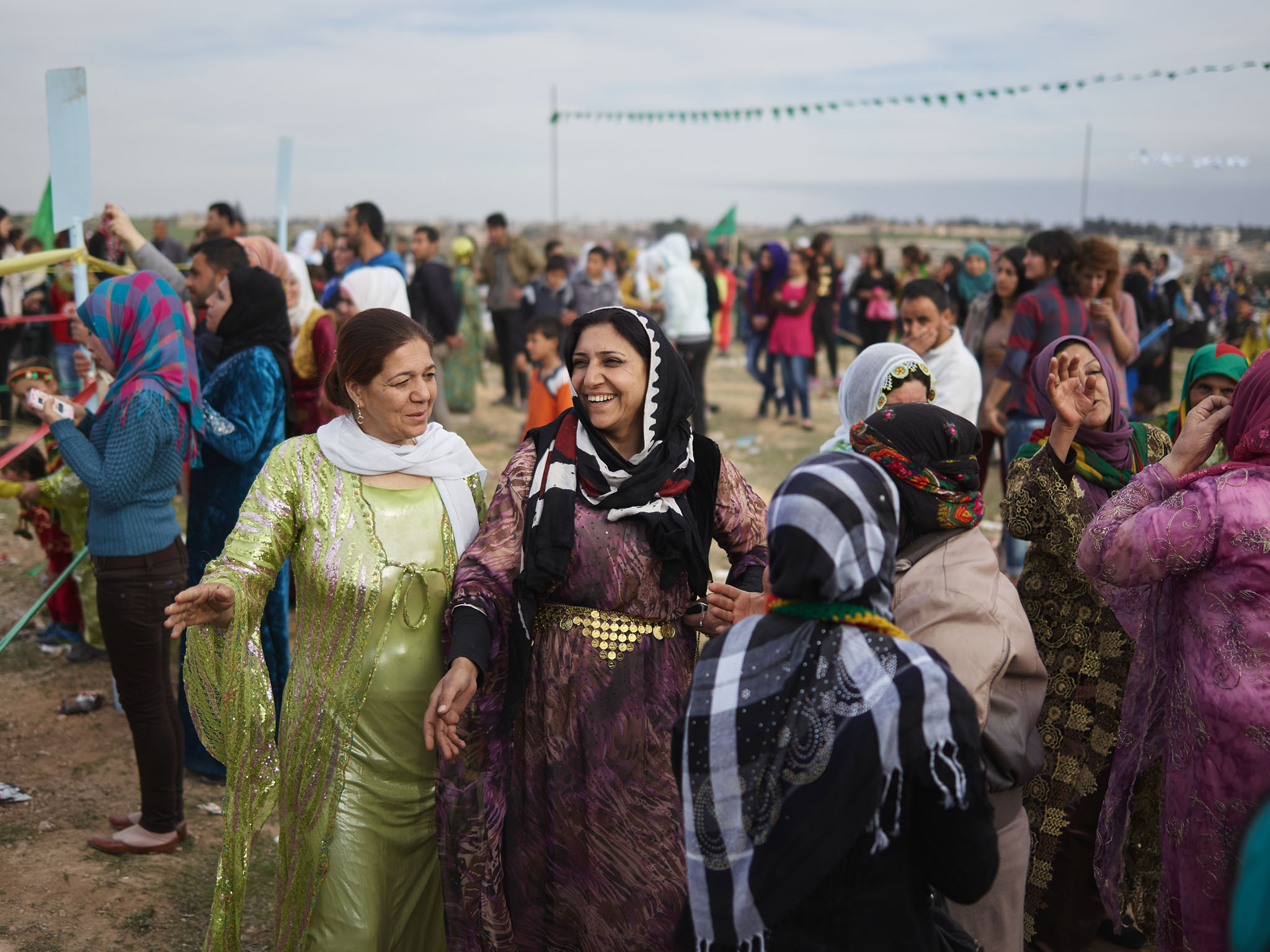
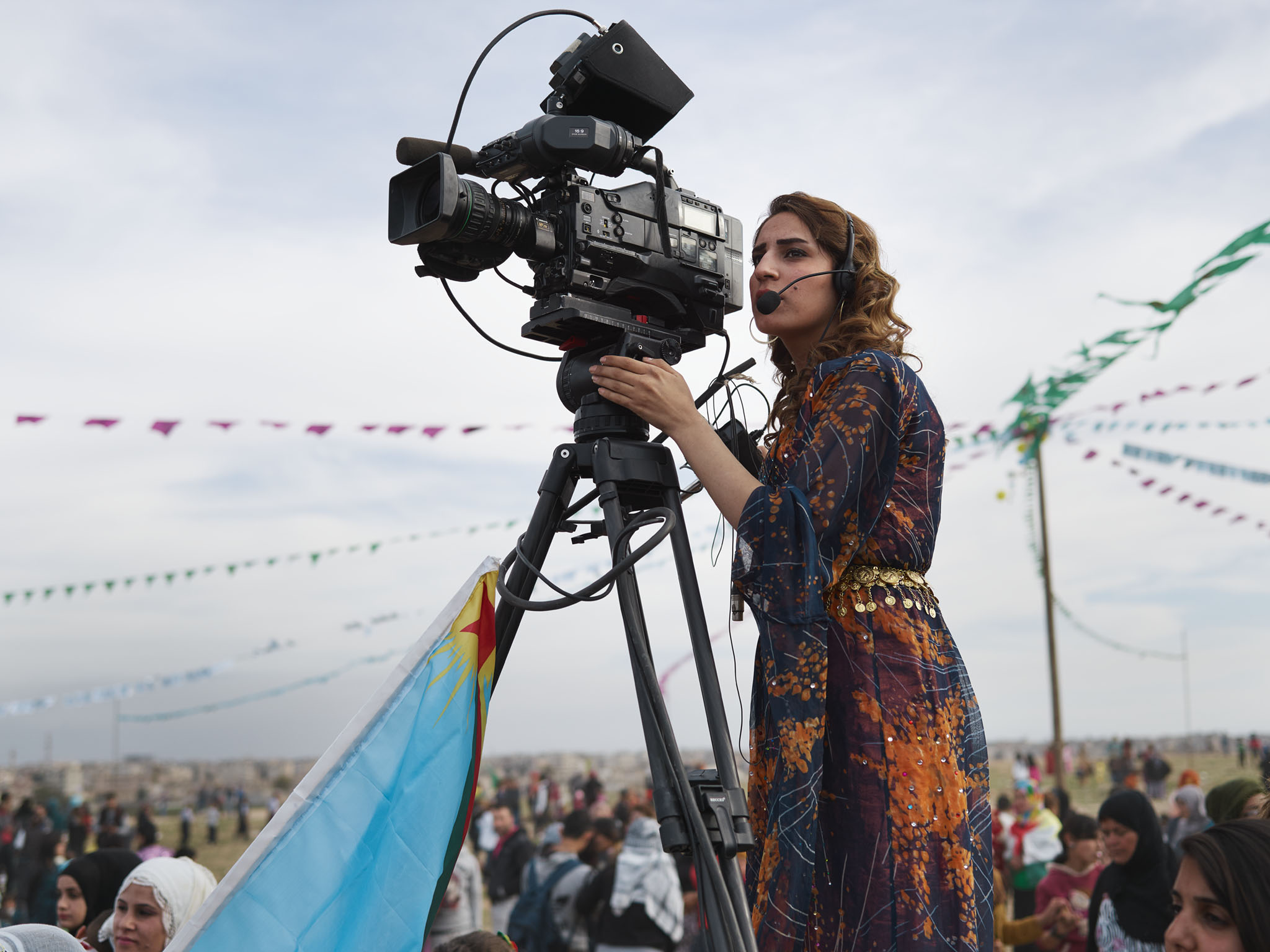
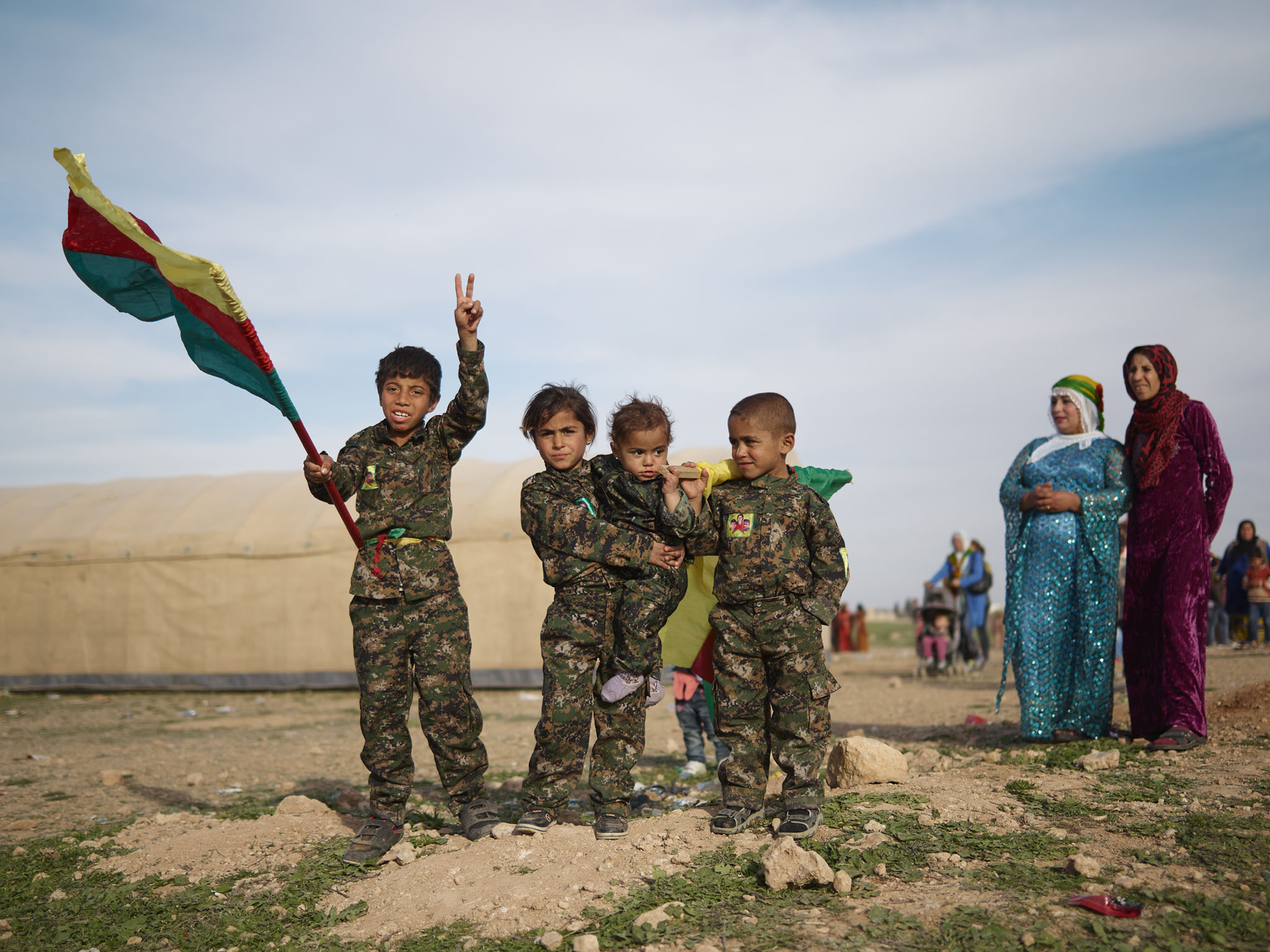
International Women’s Day Celebration, Qamishlo, Rojava, Syrian Kurdistan
Any place in this hostile of a region needs an armed military, and this is where the YPG come into play. Like the PKK, the YPG is a guerrilla force of men and women fighting alongside one another and who are influenced by the teachings of Abdullah Öcalan. There is also a branch called the Women’s Protection Units (YPJ), which is an all-female wing that focuses on women’s issues. With the Islamic State’s reputation for mass female enslavement and rape, both YPJ and YPG often collaborate in battles and prove to be formidable.
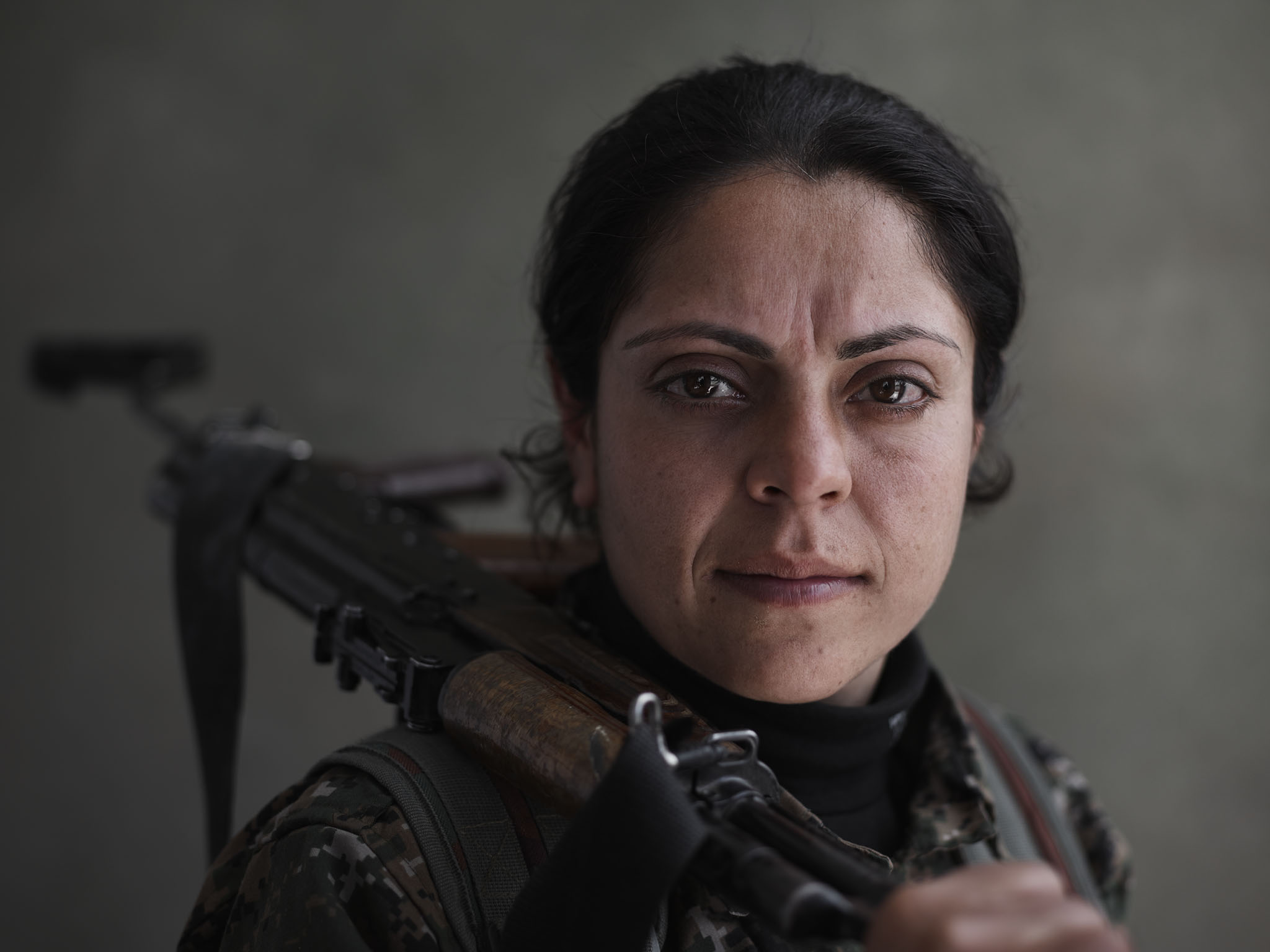
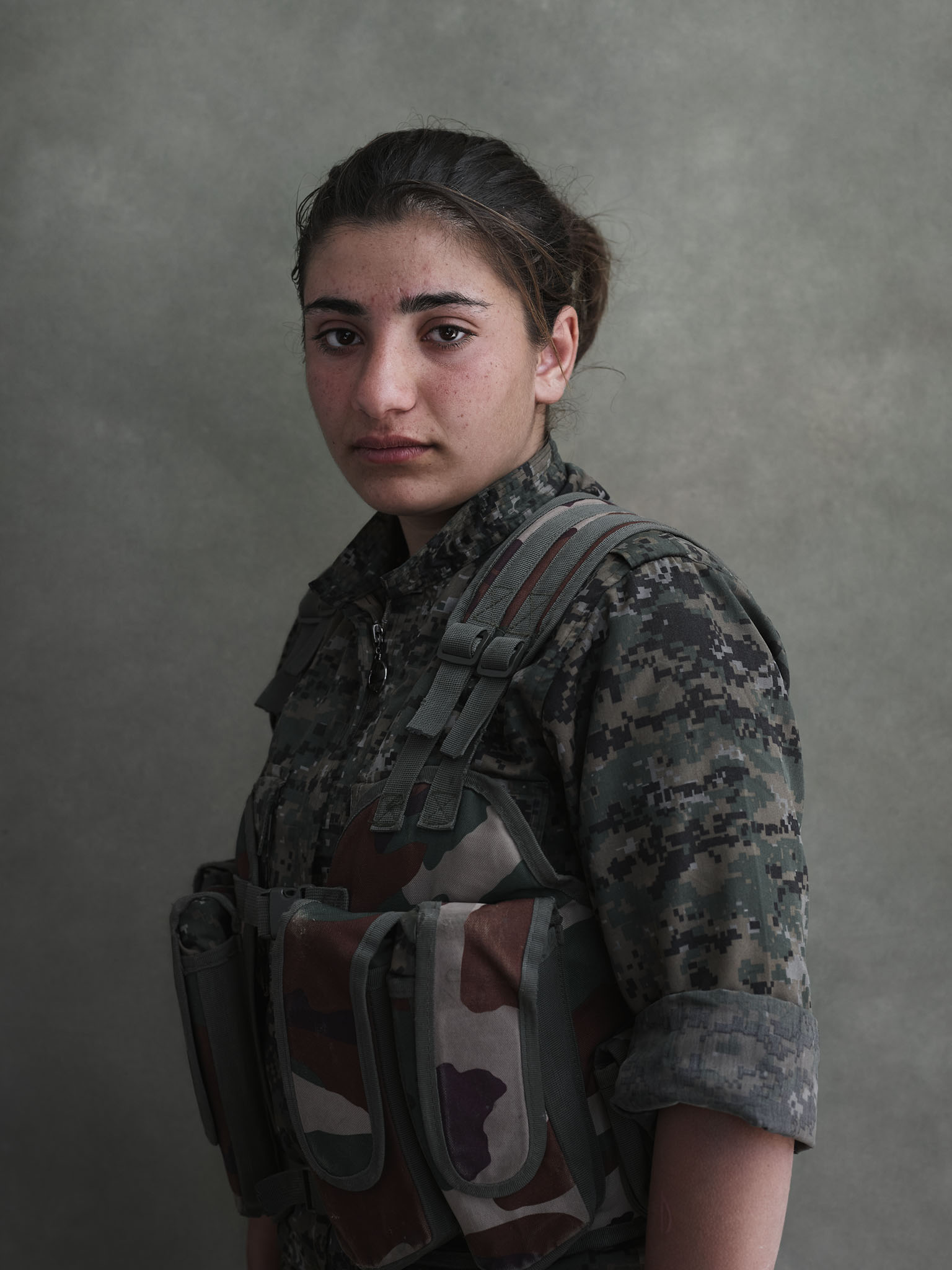

Women of the YPJ: Didar (top), Sorxwin (left), Dilan (right)
Although there are many similarities between PKK and YPG, there are doctrinal differences. For example, YPG fighters are able to marry, although it remains uncommon until after their service. A young fighter who was recently married was encouraged by his comrades to stay away from the frontline. “Go home, spend time with your wife,” they chorused.
Due to the dire situation, six months of involvement in a local security service is currently mandatory for all residents of Rojava between 18-30 years of age, but YPG/J remains a volunteer movement. I met many volunteer fighters who traveled from all corners of Kurdistan to join the fight- Turkey, Iraq and Iran. The YPG is also well known for having Western volunteers amongst their ranks— British, American, German, Canadian— the list of nations goes on.
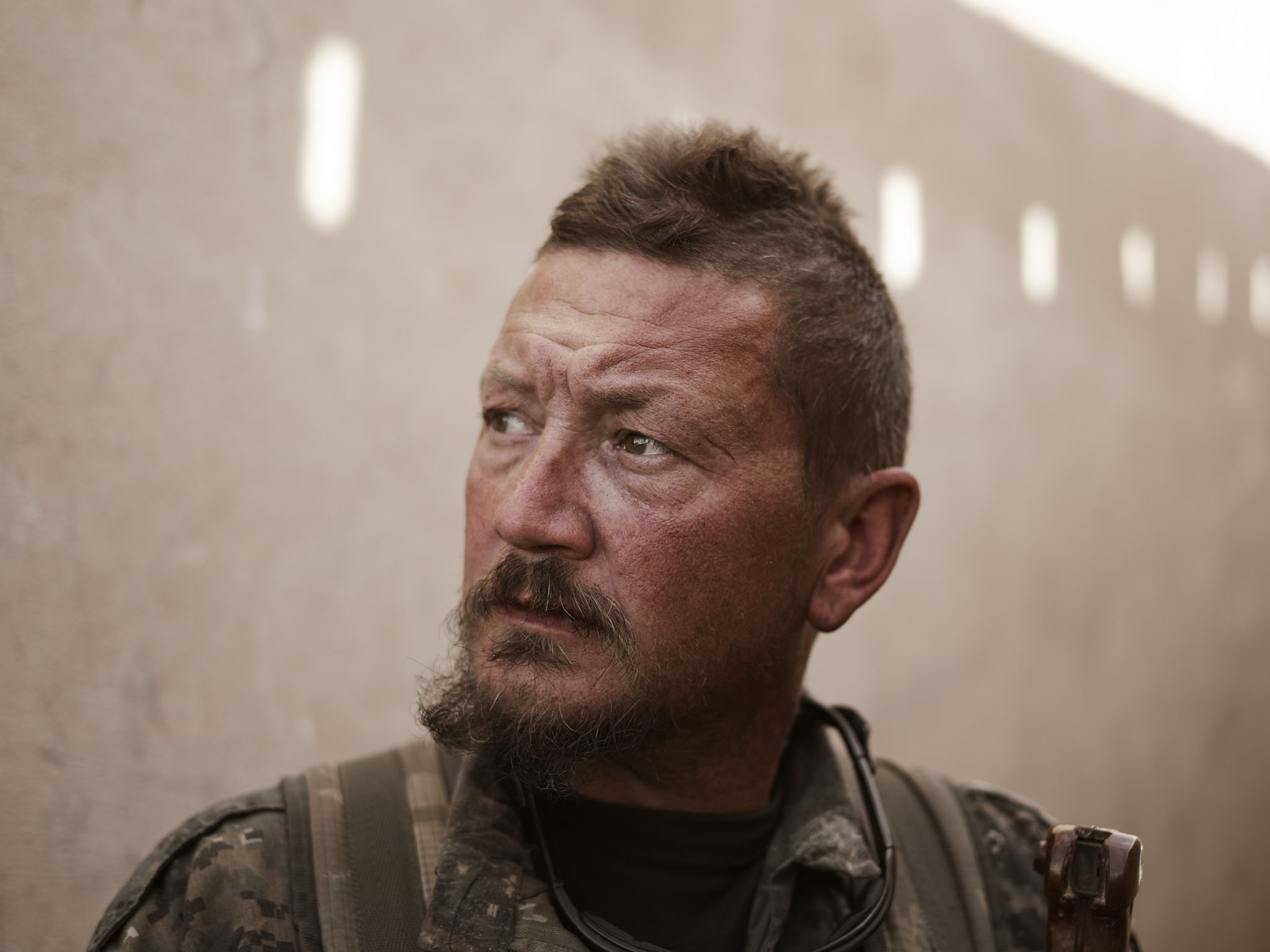
“Fat Jack”, American YPG Volunteer Fighter, Tel Tamir, Syria
In Al-Qamishli (Qamishlo), the capital of Rojava, there is still a Syrian regime base loyal to dictator Bashar al Assad. It is this same checkpoint that a Swedish journalist was held against his will until the YPG intervened, allegedly negotiating his release with another Assad-loyalist prisoner as leverage. I didn’t expect to be within such proximity to the checkpoint, but here we were driving nearby— and way too close for my comfort. Jan motioned to put my camera away. I fidgeted in my seat. In my peripheral view, I could see the faces of the Syrian soldiers. I felt my palms start to sweat and my heart pound in my chest. A statue of Assad’s father, Hafez Al-Assad, stood watch in the center of a roundabout and a sole Syrian flag ominously writhed in the air. The flag alone instilled a sense of fear in me; it is a symbol of all the atrocities that have been imposed on Syrians, Kurds and foreign journalists. And because I was atop what was once considered Syrian soil without a Syrian visa, they would view my presence as illegal. It was only when we were a few hundred meters or more away from the area that I felt the blood rush back to my face. I could breathe normally again.
A common criticism of the YPG is not taking a firmer stance against the Assad regime. After all, to many, Assad and his army is viewed as a worse enemy than ISIS— guilty of launching merciless chemical attacks on civilians. There is also overwhelming video evidence online of regime troops indiscriminately dropping barrel bombs from helicopters and planes on residential neighborhoods. Although there have been many clashes between YPG and the Assad regime, it seems they are no longer open enemies, and instead have their resources tied up in a greater common enemy. War is complex, war is dirty, and as it was explained to me, the Kurds in Rojava are taking a longterm strategy. They don’t have the weapons or technology to fight Assad’s Air Force, the Islamic State, and Jabat Al Nusra simultaneously. With Rojava gravitating further and further away from the political grasp of Syria, only time will tell what the future holds.
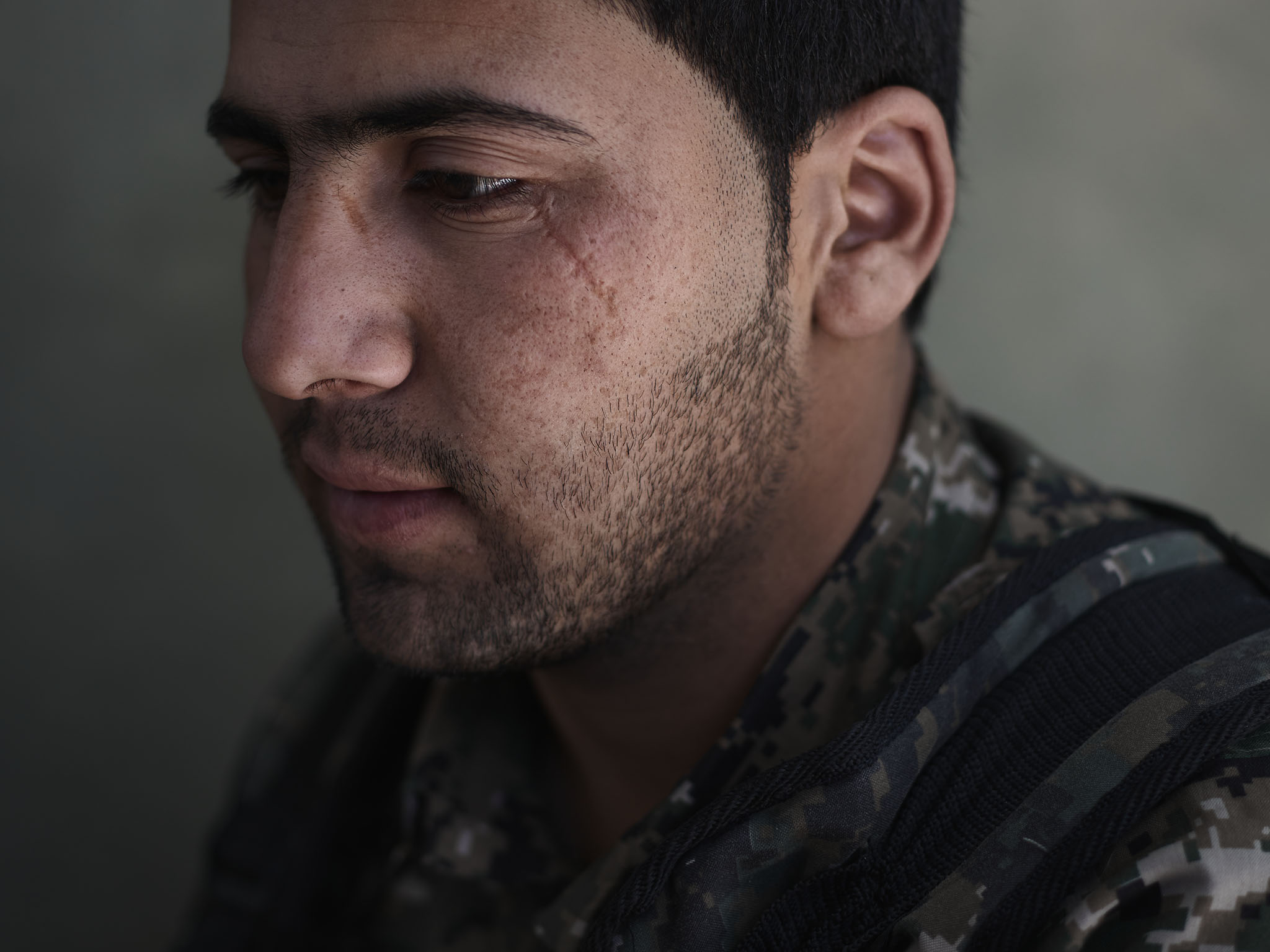
Portrait of Mexlum, YPG, Tel Hamis, Syria
Tel Tamir
If you want to photograph portraits of fighters, you have to go to where the fighting is. As we made our way from Qamishlo to Tel Tamir, I began to sense a strange vibe. I couldn’t tell whether we were driving head on into danger or whether we were out of harms way. My imagination played out numerous scenarios, and none of them are pretty. Just as my mind began to wander, we approached a small town. I never thought the day would come when I would be so thankful to see an N’Sync poster, but there it was in all its glory, hung in a makeshift CD shop. The boy band’s infidel smiles glistening in the sun and frosted tips allayed any of my concerns that ISIS may be lurking around the corner.
That being said, when we reached the area of Tel Tamir, my original sense of danger proved to be true. The YPG soldier driving us in his vehicle tipped us off to a clash that happened in the countryside between ISIS and the YPG just that morning. “Do you want to see some Daesh [ISIS] bodies?” he asked me, uncertain as to how I would respond. I said I would.
When we arrived to the site, it was early afternoon and the sun was high in the sky. The air was hot and still. A farmhouse was nearby and as we walked, I felt the presence of dead bodies. I chose not to look at them directly until I shook the hands of the men and women of YPG/J fighters standing around the scene first. Only then did I turn to examine the ISIS members. Fourteen men lay lifeless in a row, all of whom had been killed just four or five hours before. On one side were the men, on the other side were all their captured weapons. I realized this was probably arranged more for propaganda purposes. The YPG/J wanted to show the foreign photographer that they were only killing ISIS members and made it a point that they were not wrecking havoc upon local civilians.

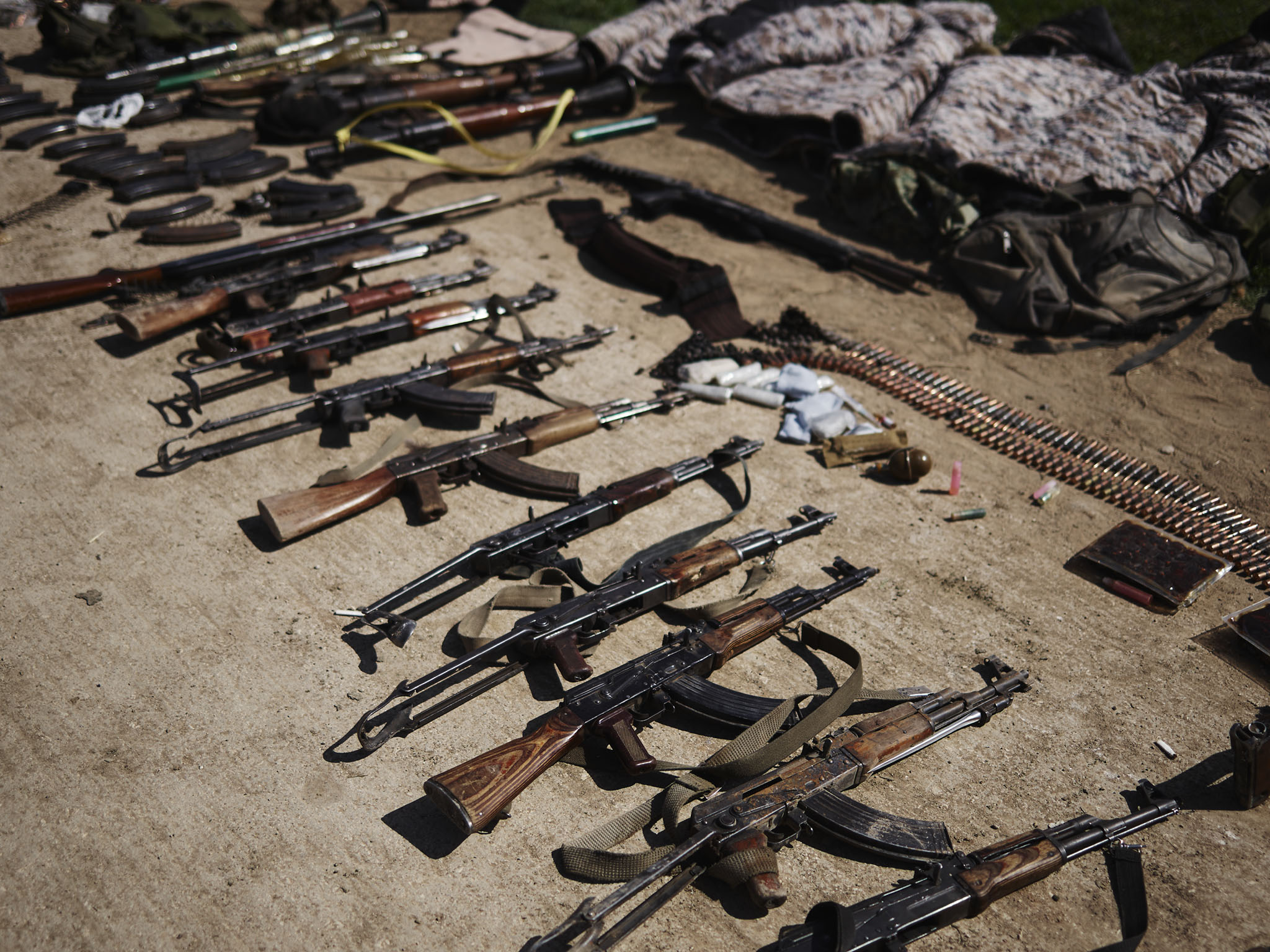
(Top) Hand of Deceased Islamic State Soldier –– (Above) Captured Weapons –– Tel Tamir, Syria
“Here the fighting took place between houses,” one of the YPG soldiers said pointing. “Here, there were civilians,” he assured me. “They locked their doors. Daesh [ISIS] told them if they don’t open the doors, they will kill them, but the civilians refused to help them because of their [ISIS’s] inhumanity.”
The soldier walked me through the phases of the battle and how they were able to surround the jihadists. Since I wasn’t a witness to the battle itself, I could only take their word for it. What was evidential were these bodies before me. The majority of the men were in their late twenties or early thirties, with well-fed bellies and grizzled beards. All but one of the men had their shirts pulled up to their chest, which was a way to inspect whether there was a suicide belt strapped underneath that may have not detonated. The last corpse was of a much younger man who ignited his explosive belt. The cadaver looked more like charcoal up to the mid-portion of his face. His rib cage was hollow— an empty shell from the bomb completely eviscerating him. One thing was certain— he must have had a genuine belief in paradise afterwards, however skewed it was.
I am not an apologist for the Islamic State. I believe that as soldiers, these men were accountable for their actions. With that said, for a moment I was actually very surprised to feel a bout of sympathy for the men lying on the ground. I couldn't help but wonder who they were and what misguided passions may have lead them here. Did they come to Syria with intentions of overthrowing the dictator Bashar al Assad, only to end up being used as pawns against the Kurds? Or were they from a powerless group of Sunnis that believed this was a way to establish some kind of ideological forcefield against Shia militias? Then, I remembered the ISIS propaganda videos, and thought about what these same men would have done to me had they realized I was camping not far away. Suddenly, my sympathies were cut short.
It has been shown that the overarching leadership of the Islamic State and some of their top military strategists actually come from the Baath Party, formerly under Saddam Hussein. Despite the ISIS propaganda videos we see showing them as a prophesied, unstoppable conquering force, here they lay like anyone else, lifeless on the battlefields of Syria.
Our driver honked the truck’s horn. “We should go,” uttered Jan. This was not a place to linger– adjacent farms within sight were under the control of ISIS, and another attack could come at any time. We headed back to the city of Tel Tamir. The city, however, felt far more dangerous than the countryside. From our view on a hilltop, rising plumes of dark smoke in the distance revealed an advance of Islamic State soldiers. Gunshots from afar whizzed closer and closer over the course of a couple hours. As terrifying as this may seem, battles in cities like Tel Tamir aren’t like the movies— most clashes are slow moving, and soldiers fight house to house, street to street, neighborhood to neighborhood in bitter stalemates until an upper hand is gained. But it can still be incredibly dangerous— here one must watch out for indiscriminate mortar strikes, especially the improvised cluster bombs made from scrap materials. These sound different from factory-made shells. They seem to tear through the sky with a faint whistle and as they approach they sound more akin to a metallic saw waving…woobbb, wobbb, wobbb, wobbb, wobbb and then CRACK! Shrapnel and smoke plumes simultaneously emerge from the wreckage.

Ammunition Captured from the Islamic State, Makhmour, Iraq
I kept asking myself, where are the guerrilla fighters’ helmets and bullet proof vests? Even though they’ve captured many from the Islamic State’s treasure trove of weapons, most will tell you they don’t want to use them. Their tactics rely on speed and stealth, and remaining fluid on a constantly changing battlefield. It’s these same guerrilla tactics that led to major successes against their adversaries. Sure ISIS has tanks, heat seeking missiles, and night vision technology, but even with these technological advantages, the jihadist group can still struggle against a force like YPG/J.
With mortar strikes getting closer and closer and the Islamic State advancing, it was too dangerous for us to linger around Tel Tamir. This first experience with shelling in the city got the better of me; I remembered the promises I made to my friends back home to stay out of harm’s way. To Jan, this was another day at the office, but as a portrait photographer with not much experience in war, I gladly observed my role.
Tel Hamis
I would spend the next four days nearby in Tel Hamis, an area that was liberated from the Islamic State 10 days before my arrival. Signs of the clashes were everywhere— destroyed buildings, exploded cars, and no residents; the place was a ghost town. Tel Hamis had changed hands many times before YPG/J’s victory here. Previously, Jabhat al Nusra and Ahrar ash-Sham also fought for authority of the area.
The compound that I slept in sat at the foot of a giant concrete grain storage facility, previously a barrack for Islamic State soldiers. It’s rotund, mammoth gray silos added to the Orwellian feeling of the place. In order to reach my sleeping quarters, I needed to walk up several flights of stairs where every inch of wall was marked with jihadist graffiti in both Arabic and Kurdish dialects. It was here where I would make a temporary home and photo studio for the next few days. Generators ran all night and the YPG/J were rotating patrols to constantly remain on the lookout.
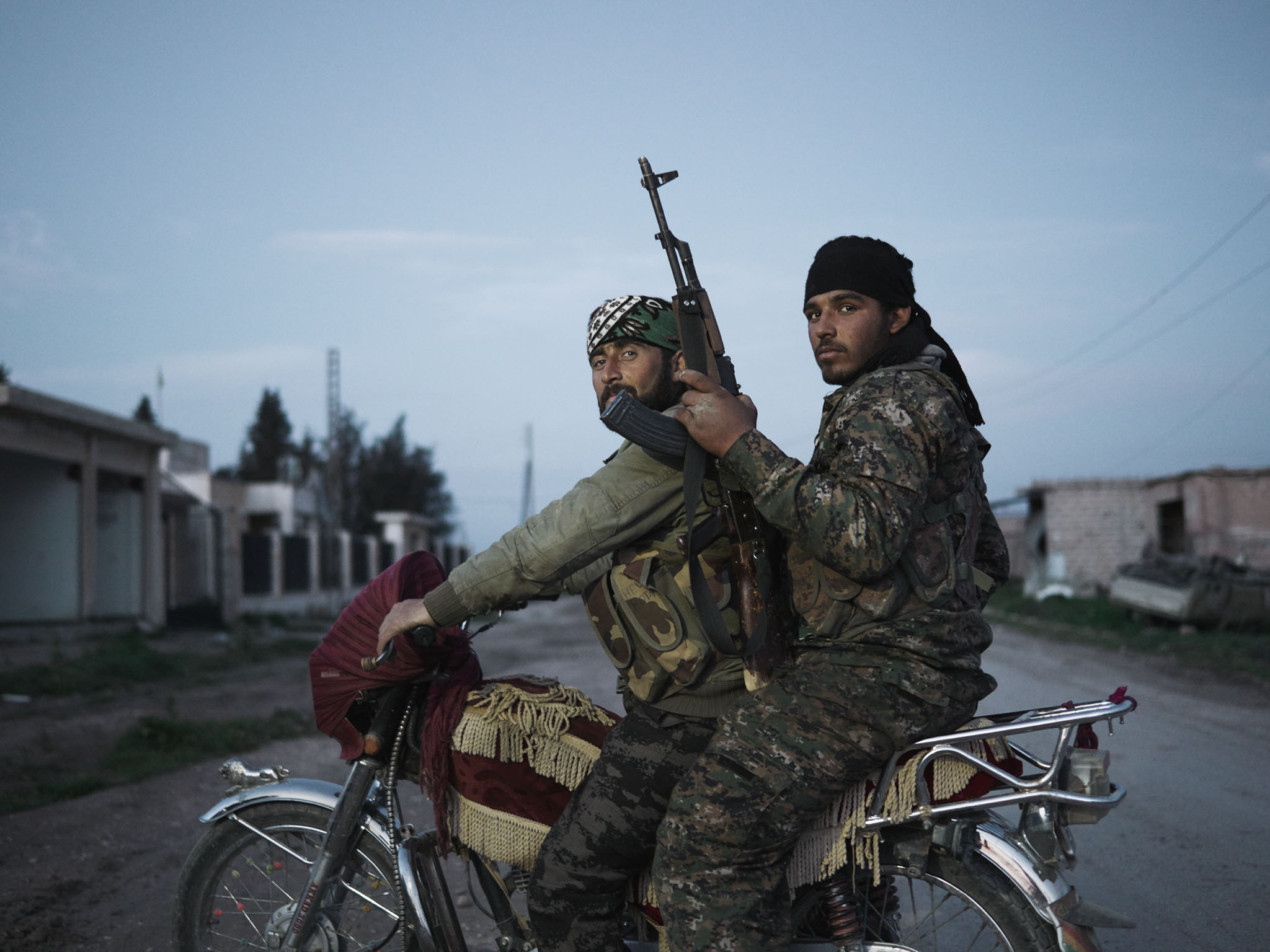
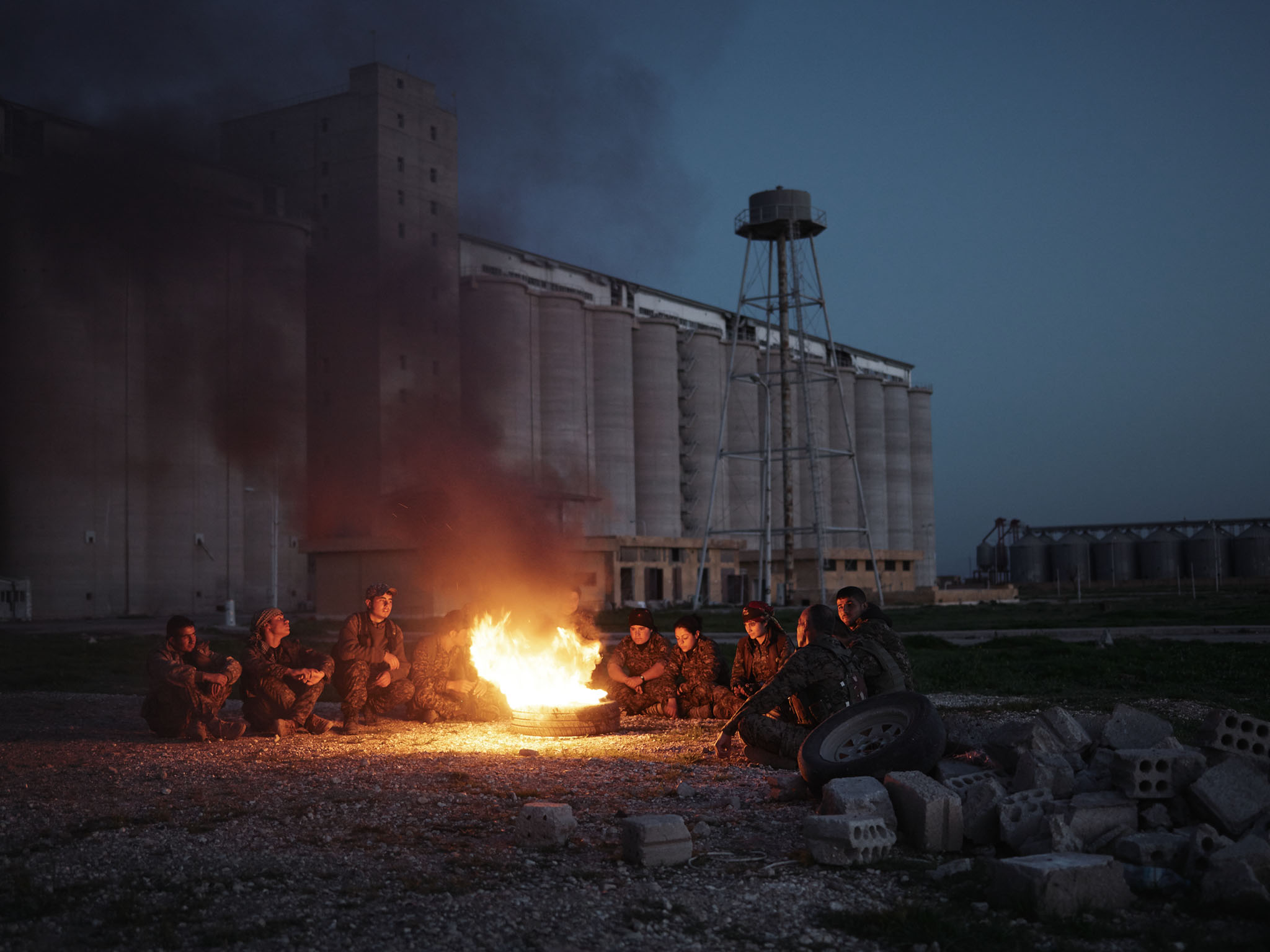
(Top) Tel Hamis Nightly Patrol, YPG –– (Above) "Em ji agir hatine u derin agir", Tel Hamis, Syria
The following afternoon I had the opportunity to explore some of the buildings. Given the cavernous structure of the grain silos, every step produces an audible echo. It was dank and musty throughout. An occasional but perceptible chill swept through one of the many holes in the thick, concrete wall— created from the constant bombardment of artillery exchanged between militant squatters.
I was warned by the YPG/J to not disturb the ground or open anything with a door; the Islamic State is well known for booby-trapping areas they retreat from with explosives. I used my iPhone as a flashlight to uncover an underworld of many curiosities: medical supplies for treating wounded soldiers, stolen ID cards of massacred Iraqi Security Forces, bullet holes from target practice. In one of the rooms lay a black flag of Tawhid. The previous owner’s intention was to fly this flag as a symbolic proclamation of monotheism to Allah and his messenger, Mohammed. Yet with the jihadists forced into retreat, here it was, dusty and disheveled among the ruins.
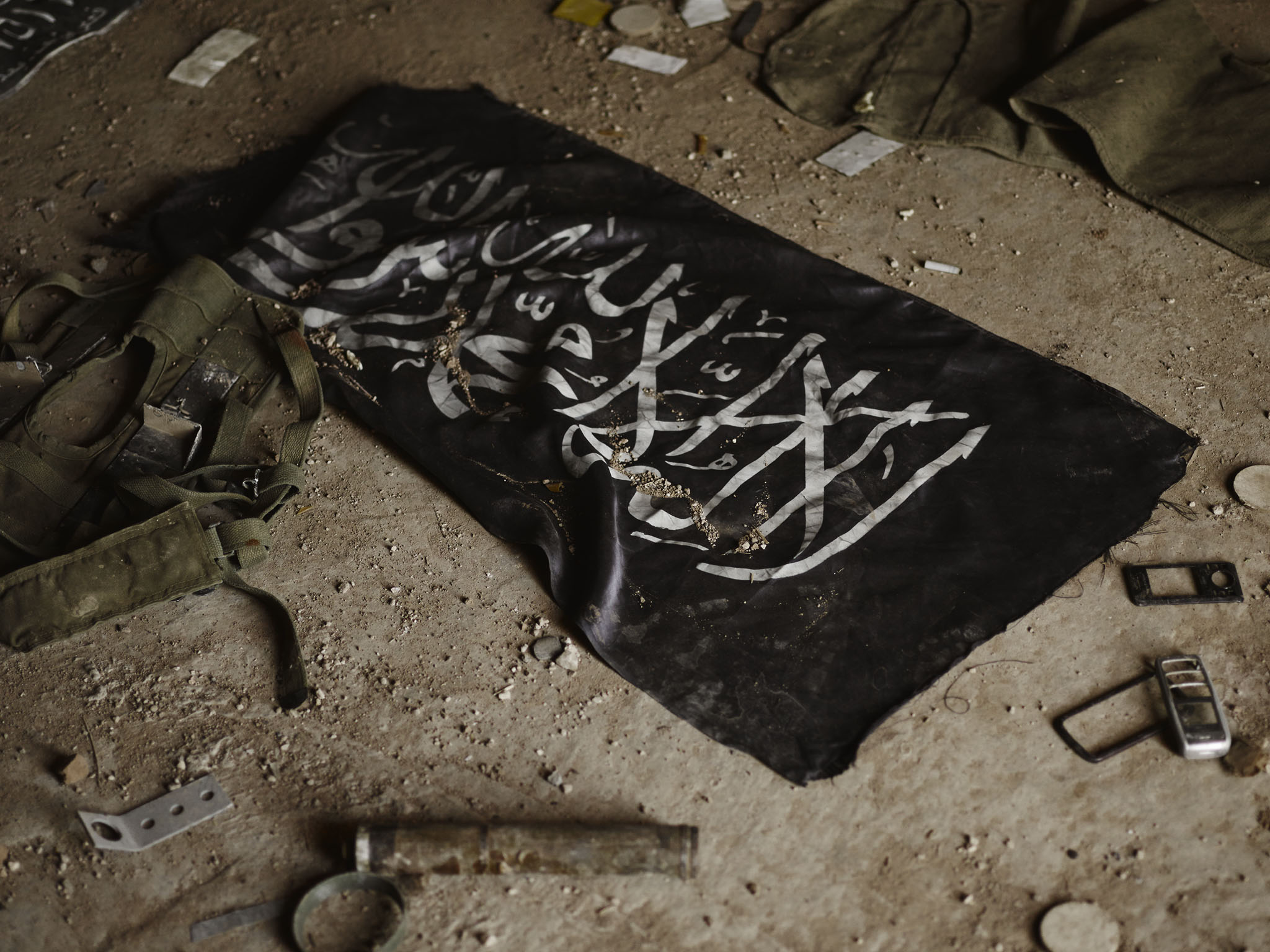

(Top) Black Flag of Tawhid, –– (Above) ID Cards of Massacred Soldiers, –– Abandoned ISIS Base, Tel Hamis, Syria
That evening, a number of the guerrilla fighters were sitting around a fire at the foot of the grain silo complex, which cast a rich, orange glow across their faces. I sat down and spoke to Didar, a YPJ commander. She asked where I had come from previously and I explained we had left after the assault in Tel Tamir. She explained that many of the fighters were originally from the countryside, and were once skittish like me, but have since grown accustomed to the sounds of gunshots and mortars.
It was during my time in Tel Hamis that I got to know several of the YPG/J fighters really well, including Didar. Those who spent the most time with me also felt the most comfortable poking fun at my fear of being kidnapped by ISIS. Before his commander thwarted his plan, one soldier told me he had considered bursting into my room at night dressed in black and armed with a knife. Like any group of soldiers, a good sense of humor is a necessary defense mechanism to bring lightness into a world swallowed by shadow.

The YPG/J and I, Tel Hamis, Syria
Sinjar (Shingal)
The road into the city of Sinjar, or Shingal, as the Kurds call it, feels dystopian and otherworldly. The path is scattered with flame-scorched abandoned vehicles. Clothes are strewn across the road. According to a United Nations report, it was here where ISIS killed over 5,000 Yezidi Kurds, enslaved 7000 women and children, and displaced 200,000 others from the region. Yezidis are a distinct religious minority in Iraq whose spiritual beliefs are influenced by Zoroastrianism and a range of other ancient faiths. When the Islamic State entered their cities and villages, they became a target for mass atrocities and genocide.
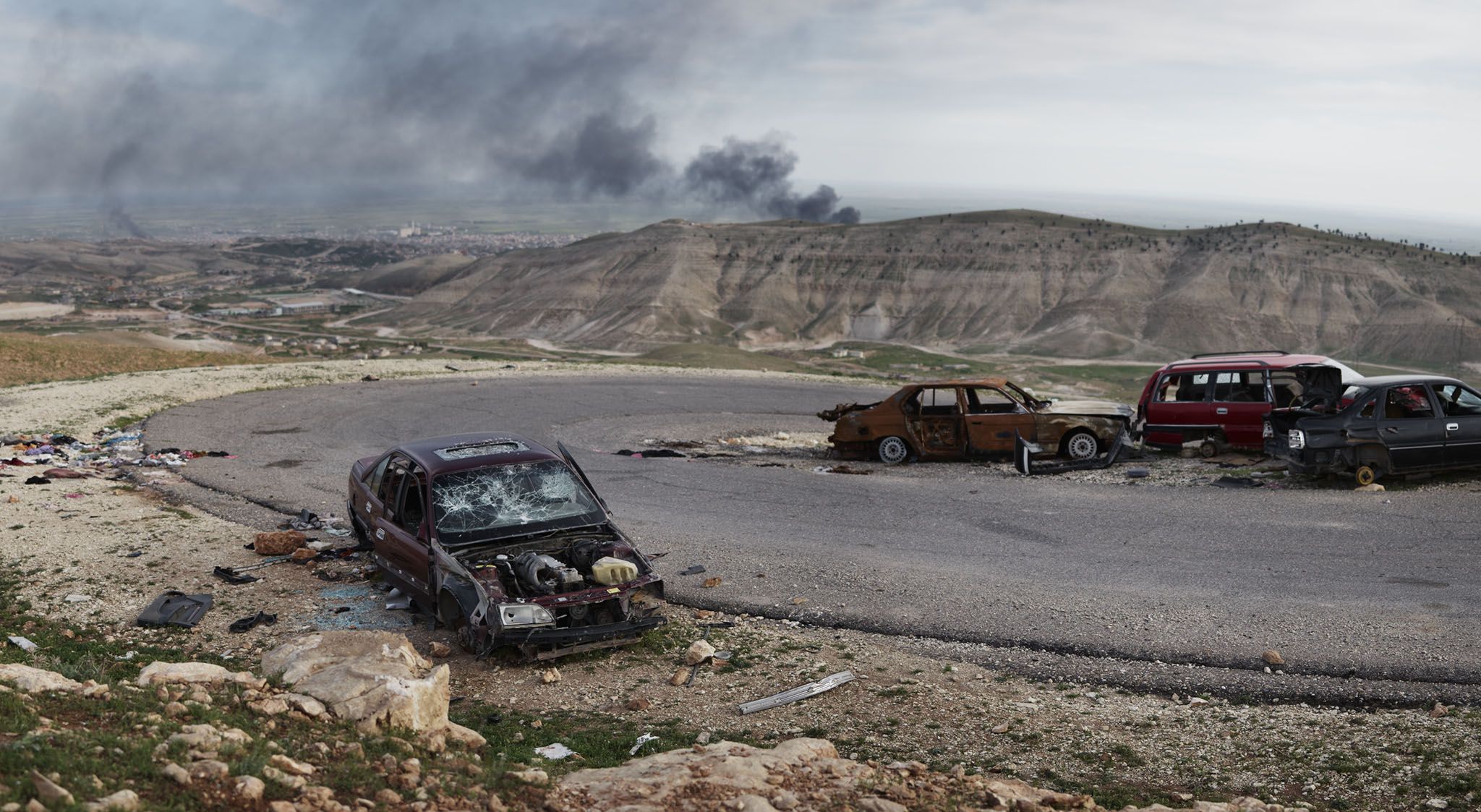
Besieged City of Sinjar, Iraq
Though the Yezidi bodies have been removed from the scene and given proper burial, one doesn’t need to see the death to imagine what the chaos could have been like. It’s this scene that has become imprinted in my mind, as it’s far too easy to put yourself in their place: It’s dawn. Your family is fleeing the city. You tell your wife and kids to pack their bags. You scramble into the car and head over the mountain, but this is where the true chaos ensues. The people ahead of you are running from their cars, screaming, fleeing by foot. In the distance, there’s a blockade of militants slaughtering anyone trying to escape. You turn around and tell your family to gather whatever they need and to run as fast as they can into the arid landscape. Your life is now at the mercy of the mountain.
There are many conflicting accounts and theories about how ISIS was able to reach the Yezidis without warning. What is clear is that on August 3rd, 2014, the Peshmerga were somehow forced to withdraw from their checkpoints, leaving a clear path for the Islamic State to enter and destroy Shingal. It’s important to note that the Islamic State didn’t enter the area to control its Sunni citizens like it did in nearby Mosul; it strictly came to massacre the men and enslave the women. According to the Islamic State’s ideology, the world’s nonbelievers should be eradicated and doing so is not a sin. The group claims that Christians and Jews may be permitted to be ruled over and pay the “jizyah” tax, but religious minorities like the Yezidis have absolutely no status in the alleged Caliphate.
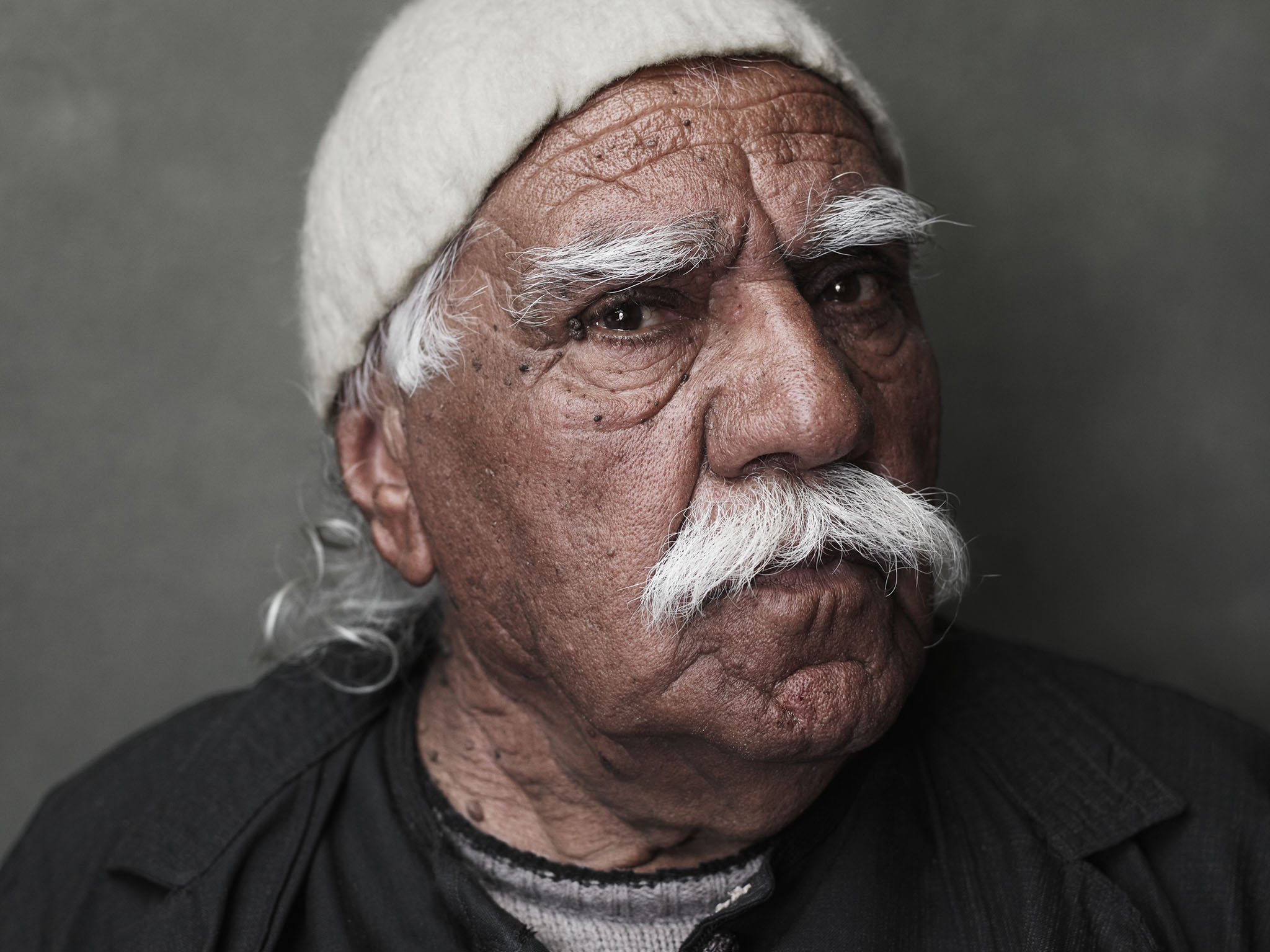
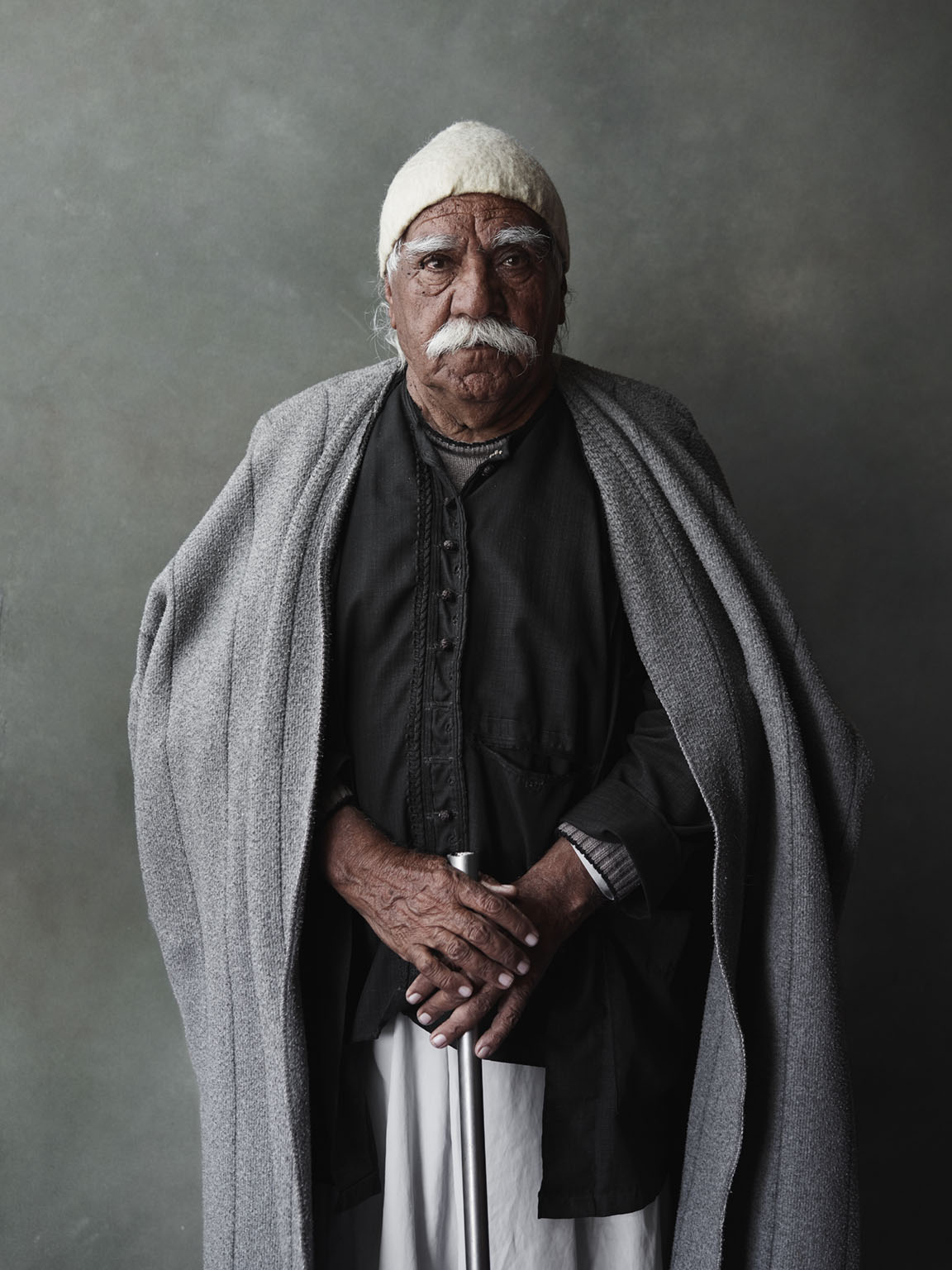
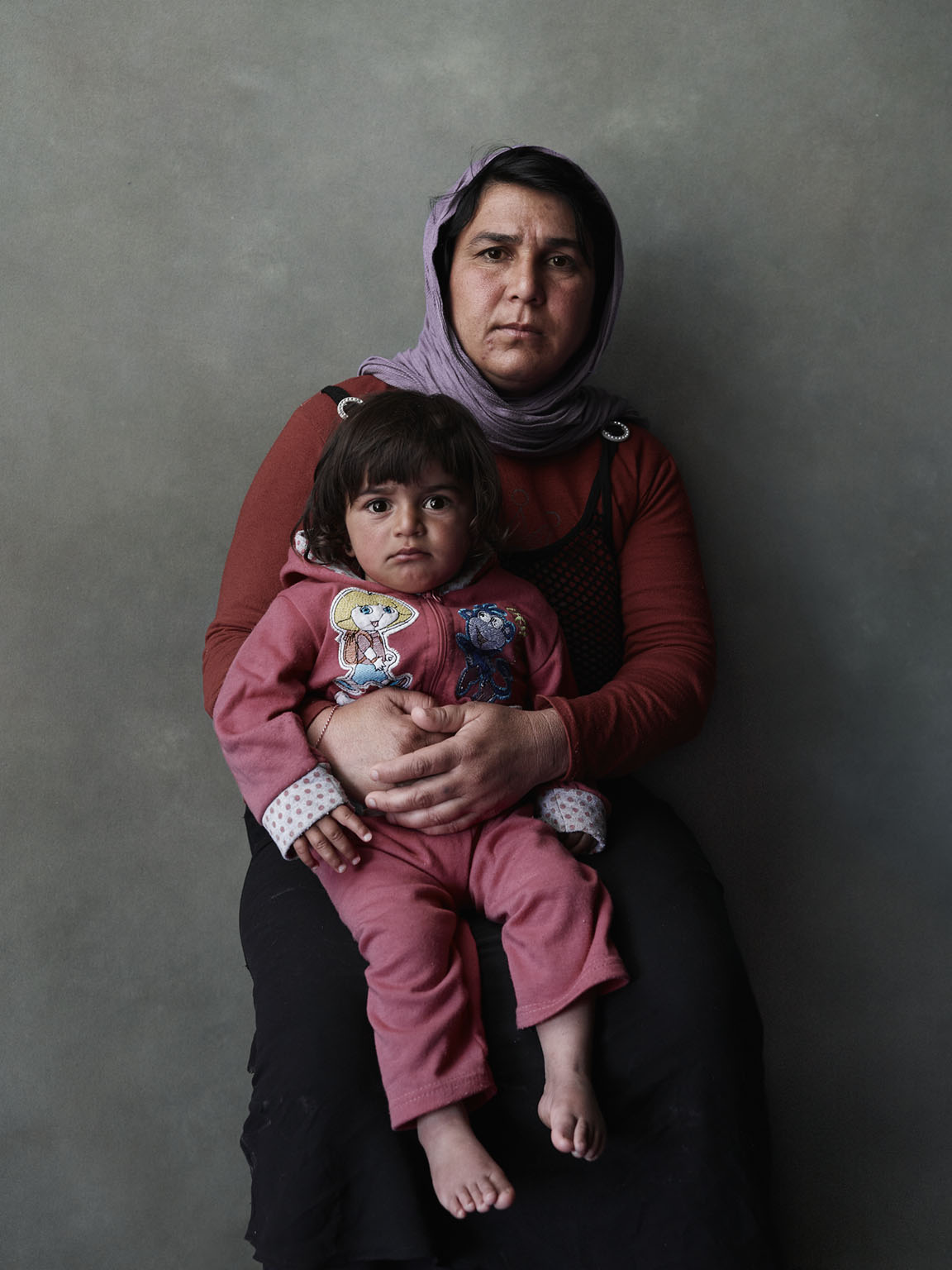
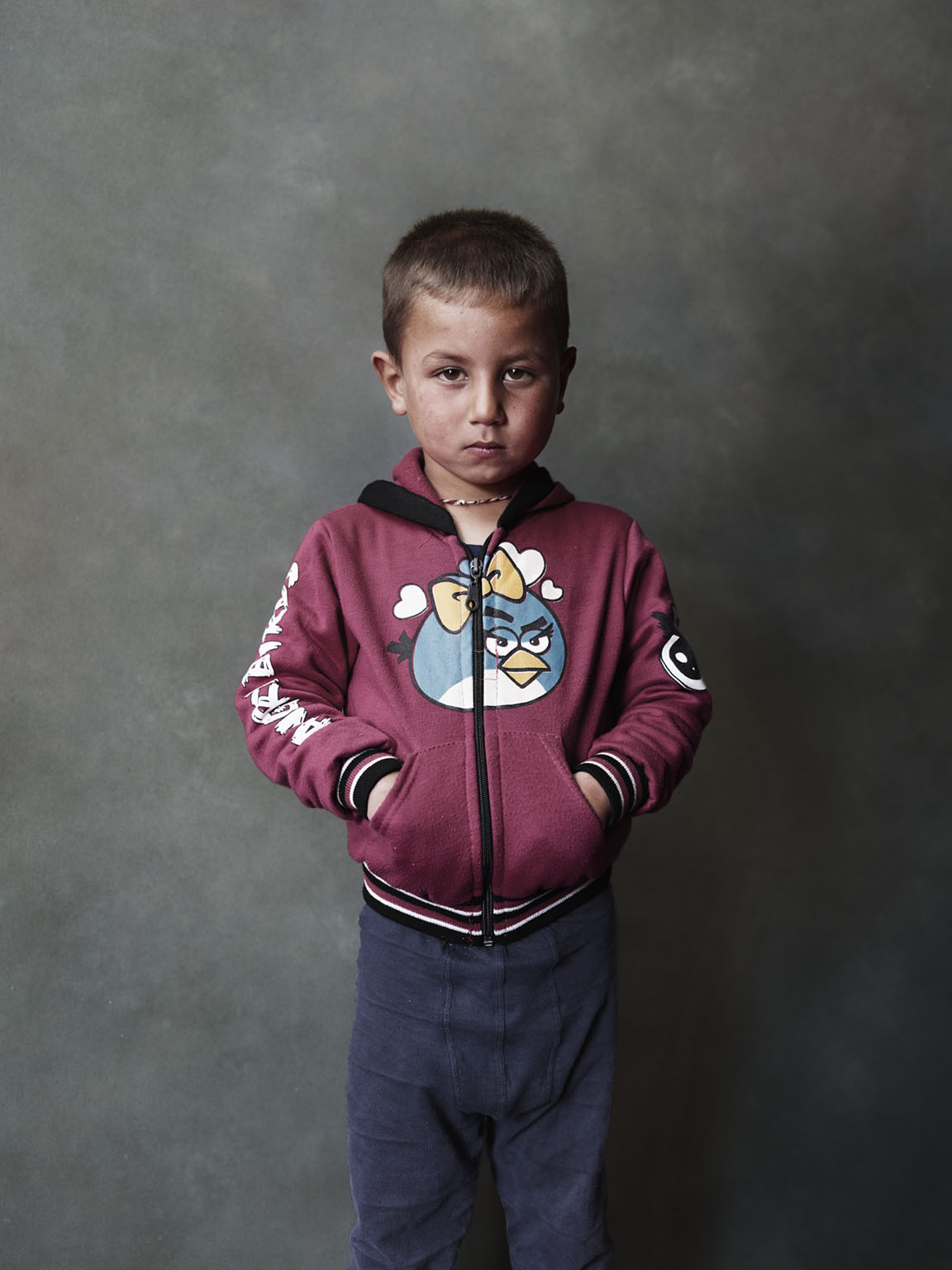
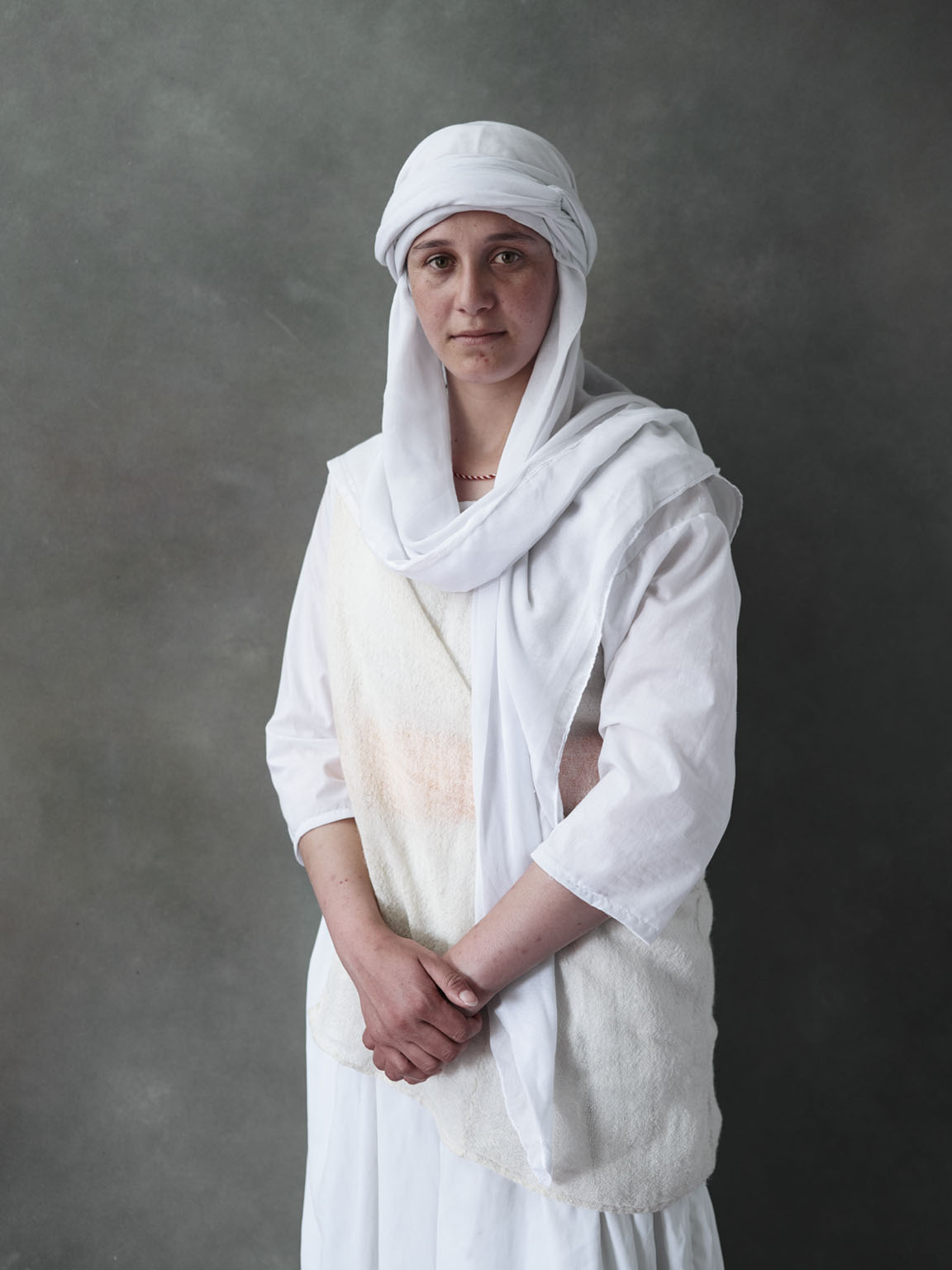
Yezidi refugees displaced from the Sinjar region. Photographed in Newroz Camp, Derik, Rojava: Sehdo Xelef, Cihan, Shelan, and Xewle
Upon my arrival, it was claimed that ISIS still held 70 percent of the city and Kurds 30 percent. I spent a few days on a PKK resistance line, observing the battle unfolding in the city.
We camped in a large abandoned house of a family who fled the city. In a strange turn of events, what might have once been considered a mansion in the area, now housed dozens of guerrilla fighters sleeping on the floor, sniper nests perched on the rooftop, and cupboards converted to ammunition storage. A fighter gestured up towards a spiral staircase and explained “Don’t go up there, you’ll become target practice.”
At night, a generator provided light and electricity. We watched a Turkish-dubbed version of The Matrix together on an old flickering TV in the living room. After a scene in which the main character Neo finishes up a fierce gun battle, the sounds of gunshots continued over the dialogue. I realized these weren’t from the film at all, but from DShK machine gun rounds firing not far away outside.
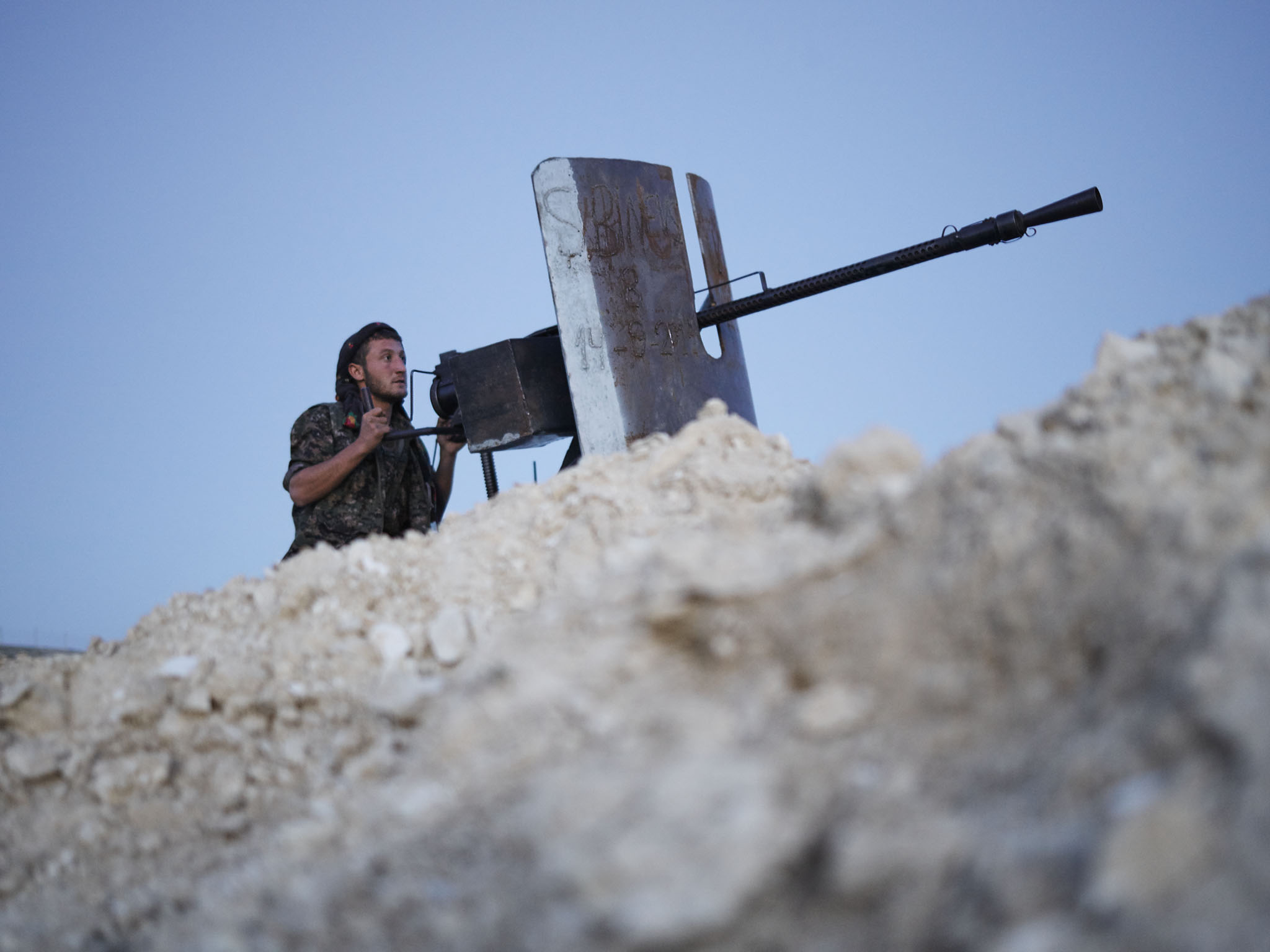
YPG Position on Sinjar Mountain, Iraq
The next morning, I witnessed the Islamic State unleash a violent attack which began with a suicide bomber igniting a car packed with explosives (VBIED / Vehicle Born Improvised Explosive Device). This is seen a lot more clearly in my behind-the-scenes video of Guerrilla Fighters of Kurdistan, and my GoPro happened to be rolling when the explosion ignited behind me on a hill, approximately a kilometer away. Even though the attack was far in the distance, you could feel a slight shock wave pulse through your body and then hear the actual explosion half a second later. My natural instinct was to duck and cover my head from shrapnel. “Shit!” I yelled, but as soon as I looked up, I was met with Jan’s calm gaze. “It’s okay,” he said. “Let’s just prepare all your stuff in case we have to leave quickly.” Before Jan even finished his sentence, the fighters had already grabbed their Kalishnakov rifles and ran for the trucks parked outside the base. Jan explained that those fighters will go out to support those on the frontline and be prepared to drive any wounded back to the base.
I watched intently as the PKK commander monitored the scene from our position. He stayed in touch with his comrades on the frontline with one walkie talkie, but used another to closely monitor another radio channel— the one ISIS uses. The radio picked up voices of Islamic State fighters speaking local Turkmen and Arabic dialects from nearby Tel Afar:
- Mr. Ali, 10 of us are coming to you, God willing.
- Unbelievers will come from behind you, my brother
- We prayed to Allah for this fight. I swear we will fight them fiercely
- Wait for backup…
- Waleed, where are you now?
- Run, Ali!
- The belt is empty now
- Run in front of me!
Although a suicide attack may seem like disorganized chaos— there is actually a method to ISIS’s madness. Though their tactics they use can seem bizarre to us, the Islamic State should be considered masterminds on the battlefield. Employing the use of suicide bombers can either be a devastating blow to an enemy’s position— allowing foot soldiers to make a rapid advance— or it could merely be a distraction for a flank attack from another unanticipated position.
After a couple hours of fighting, the attack was repelled by a union of guerrilla forces and Peshmerga. Although the jihadists gained no ground on this particular occasion, the following day we learned a guerrilla had died in the clash. There was a military style funeral for the fallen fighter. As a foreign photographer, I was encouraged to go and witness the burial so the world outside the battle zone could see what was happening in Shingal.
When I arrived at the funeral, the wind had picked up considerably, whipping sand particles against the exposed faces and necks of the mourners. A gray fog had enshrouded the landscape. If you looked off in the distance, there was no separation between earth and sky. The entire community of about 200 people gathered for the ceremony: singing, crying and taking pictures on their cell phones. Suddenly, the people parted and the casket arrived, hoisted on the shoulders of the martyr’s fellow soldiers. Bullets were fired into the bleak heavens. The family led the procession, wailing and chanting, “Martyrs never die!”
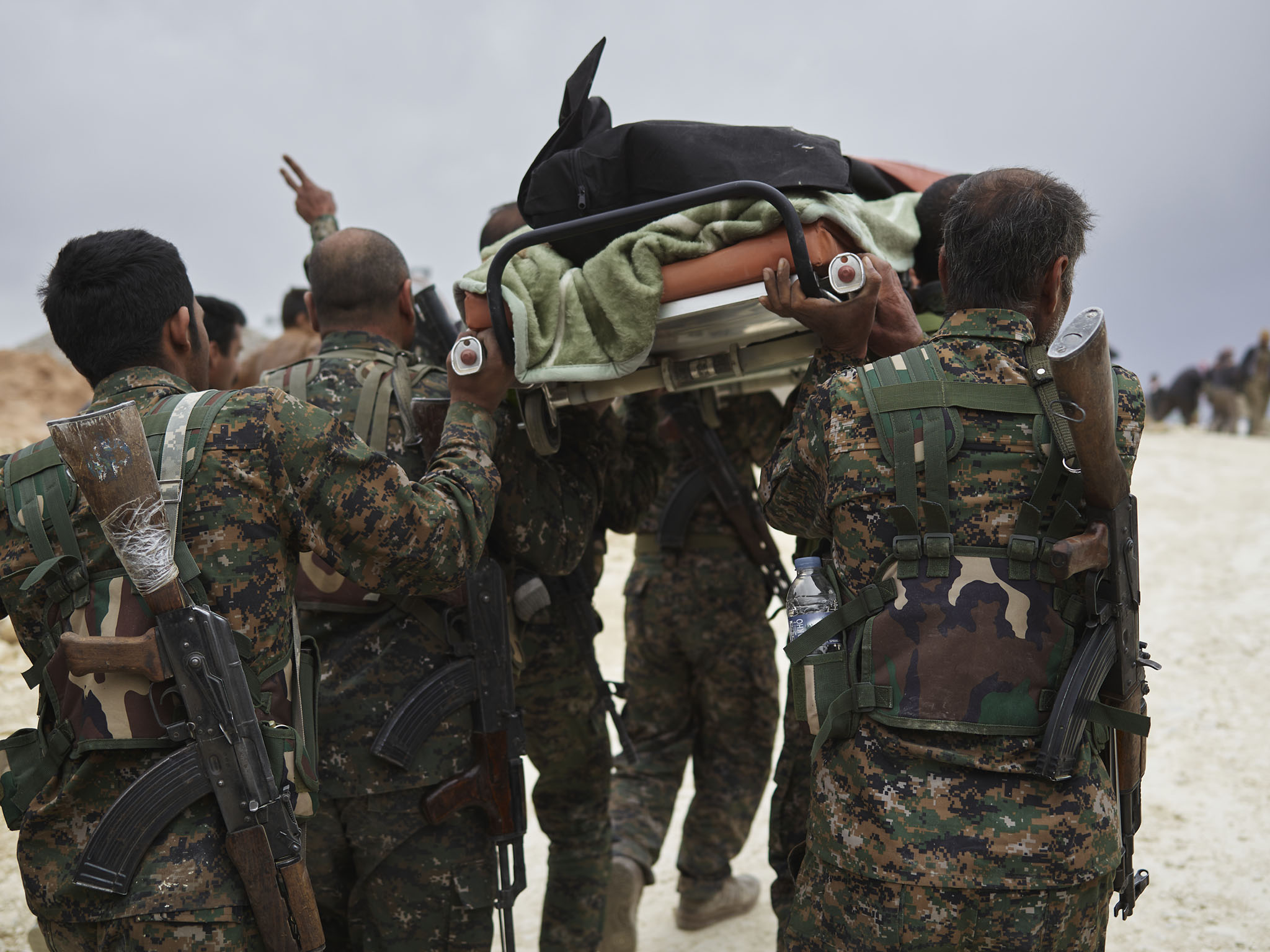
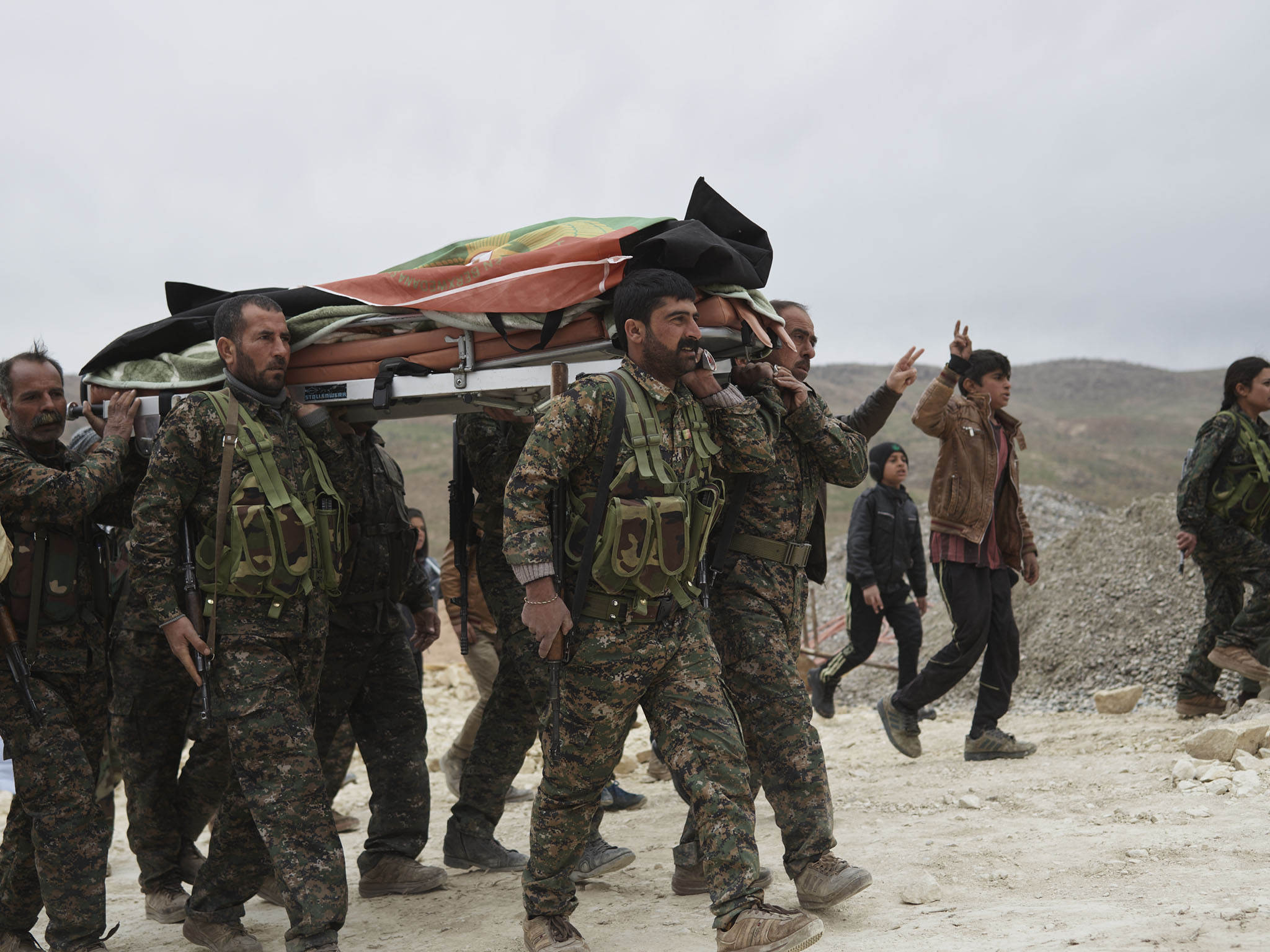
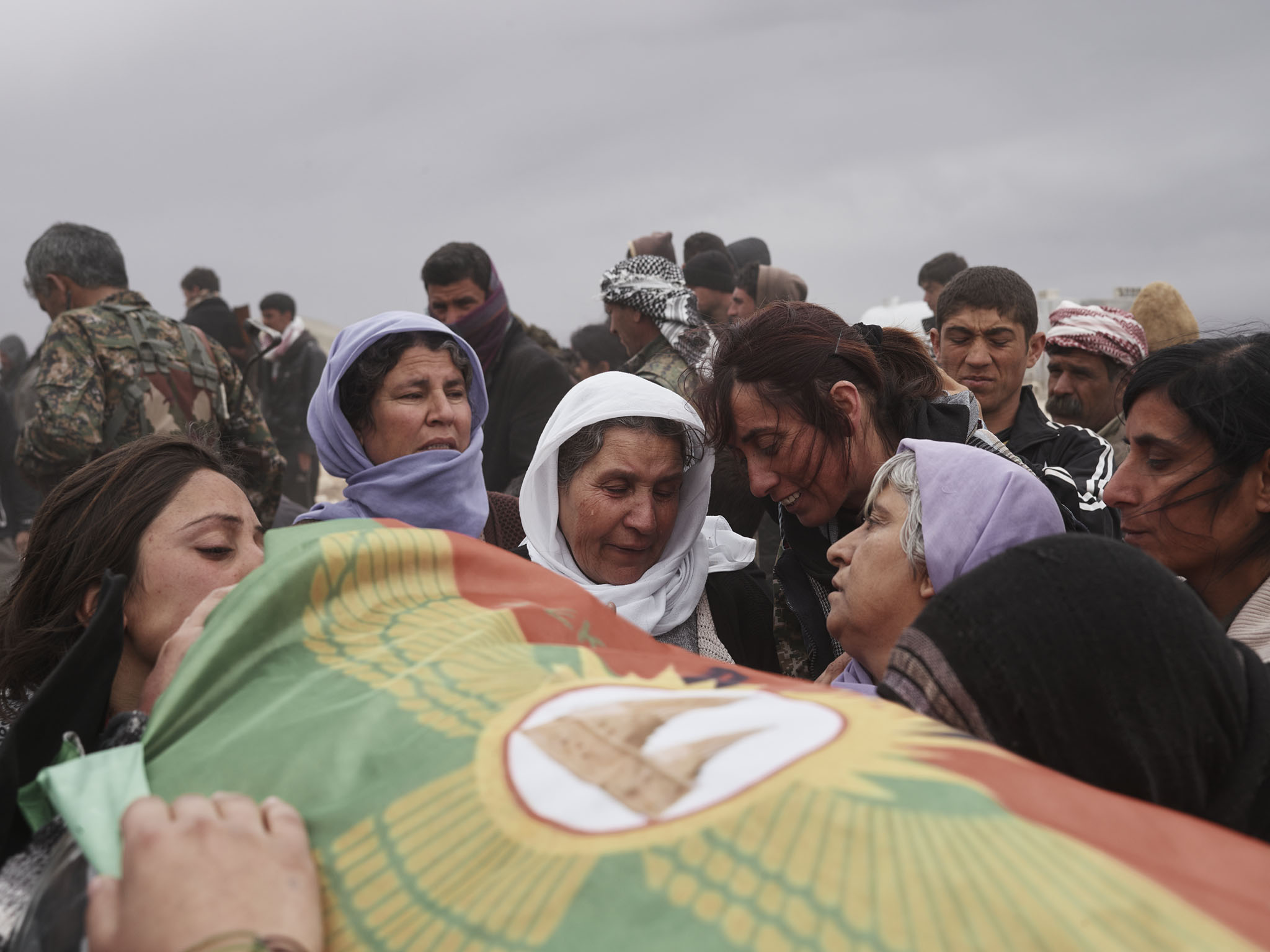
The Martyr— one who has died protecting the people of Kurdistan— is one of the guerrilla group’s most respected titles. Never has someone simply “died”. To become a martyr is to transcend a meaningless death and become a legend of Kurdish freedom. Understandably, guerrilla groups and their local supporters have been accused of being part of a so-called martyr’s cult. However, the way it was explained to me was more of a nonreligious context; when one dies protecting their people, his or her sacrifice lives on through those they have protected.
Newroz Refugee Camp
After bearing witness to the scenes in Shingal, I thought it was important to include portraits of Yezidi Kurds whom had been displaced by the Islamic State. We headed far north of Shingal, across the former Syrian border into Rojava to Newroz, a guerrilla-protected refugee camp. Many of the Yezidi people at the camp were saved by a narrow, treacherous, zigzagging corridor created by guerrilla forces, who beat back the Islamic State on both sides, using the rugged terrain to their advantage.
It was in Newroz where I met a young Yezidi boy of about 11 or 12 years old who shared a poem he wrote. It wasn’t until I got home that I had a friend translate his spoken word. As I read the words one night from the comfort of my home, I couldn’t help but choke up over the stark reality this boy had witnessed, and the strength of spirit that he had to share:
“Rise up, rise up and open your eyes from your slumber…
It is true that we are all injured, half dead and half burning…
Who but this mountain, YPG and God have freed us?
Mountain of Shingal, my mother, blood is dripping from your plums…
We have not yet escaped our last massacre, today we are victims of a white massacre…
Again we are fighting like wolves…
Go to Shingal’s mountain, go to the roofs, shout to God “Rise up, Rise up”
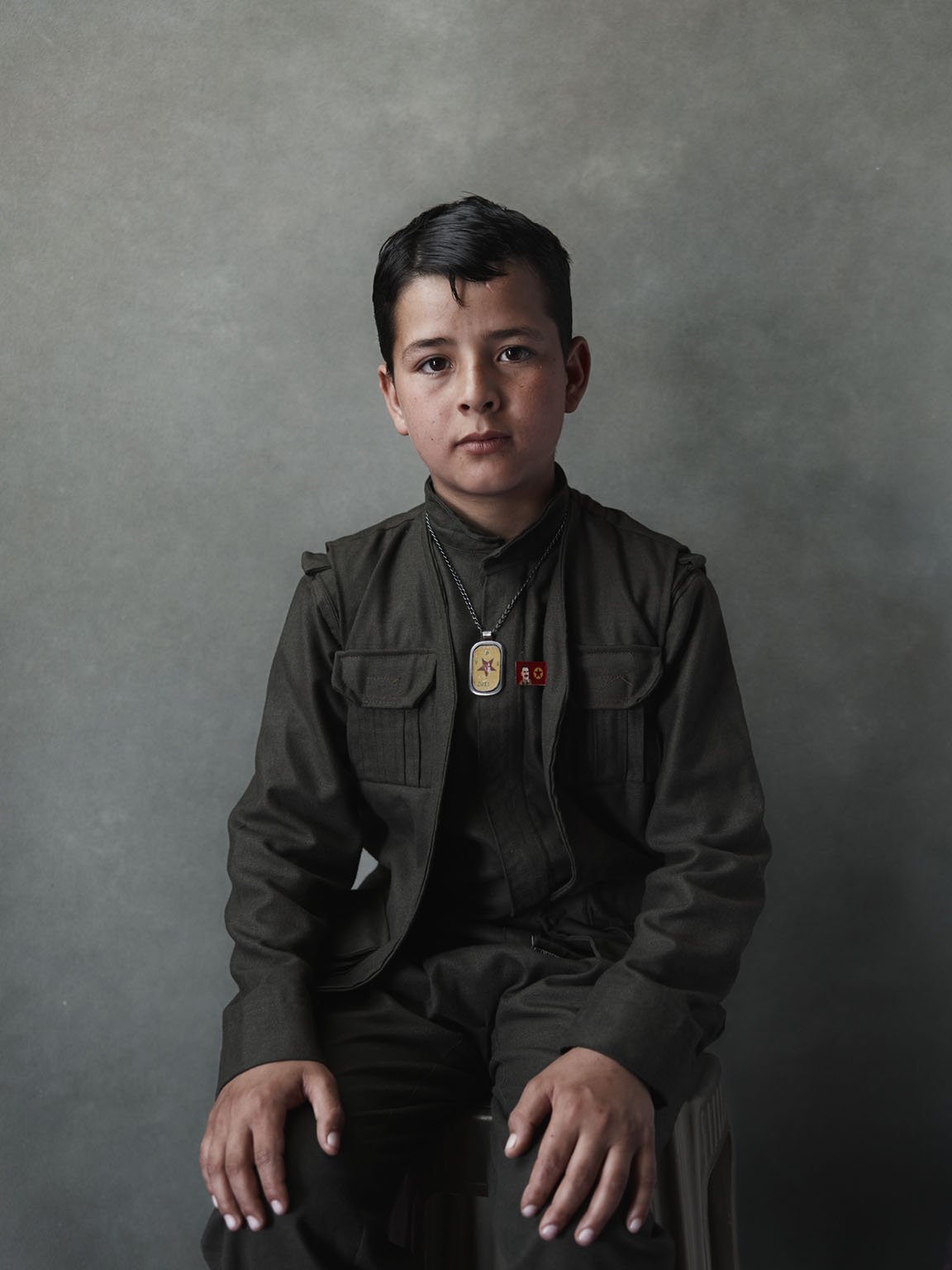
It’s through stories where much of life is revealed. When I asked a young PKK member earlier on about Yezidi folktales through Jan, the fighter began to tell me about a bloody war between leaders of Turks and Kurds. I stopped to further explain myself, fearing my question was lost through the broken telephone game of translation. “I mean a folktale,” I reiterated, “which is more like a tale rooted in history from long ago.”
“Yes, those are both our folktales, as well as living history today,” he replied dryly, staring off into space. Unfortunately, history has not always been kind to the Kurds. They have tragically been on the receiving end of countless genocides and other atrocities that are hard to reconcile.
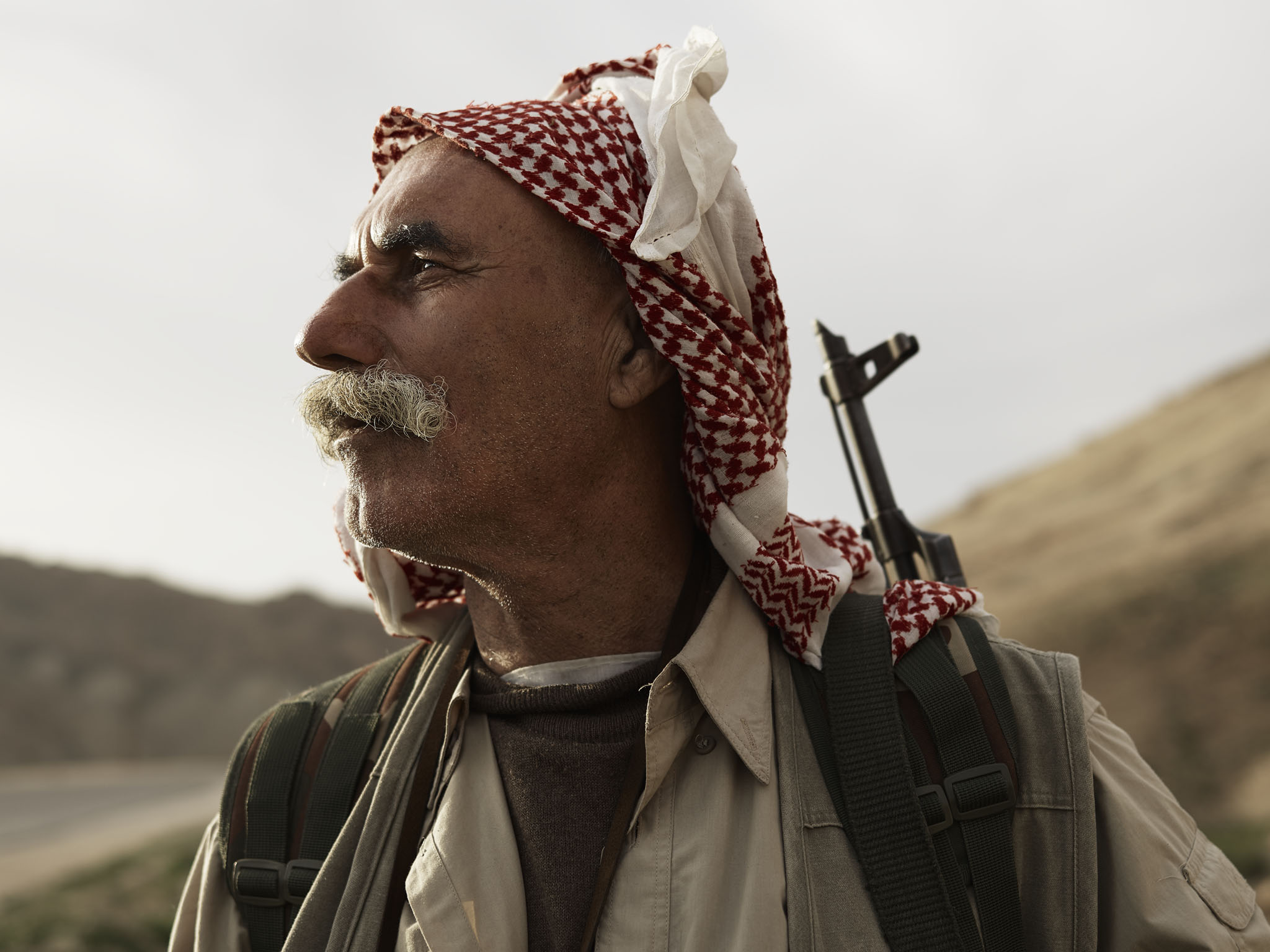
Yezidi Volunteer Fighter, Sinjar Mountain, Iraq
Ewrêşê Evdî and Edûlê is a folktale about forbidden love between two Kurds— a Yezidi man and a Muslim woman. Edûlê's father, an influential tribal leader, had his lands fall under the control of Turkish forces. The father proclaimed: "He who can free us from the Turks can have my daughter's hand in marriage.” No man succeeded, but Evdî who had been in love with Edûlê made a heroic attempt. Like a great Shakespearean tragedy, Evdî was injured and as he lay dying, Edûlê came to him and sang until he passed.
Reading the news today and seeing the extent of the war, one can only assume that there are many modern day Evdîs and Edûlês, perhaps fighting against the Islamic State in Sinjar Mountain— a hostile land of inspiration for both great poets and modern day warriors.
Not all Yezidi Kurds await liberation in refugee camps. Many are active as community leaders or are being trained to take up arms themselves against the Islamic State, or future threats. In the mountains of Shingal, I met and photographed portraits of brave young women on a base who had joined the newly formed Shingal Resistance Units. After training, they will join the guerrillas in the fight. Their commander told me that the biggest challenge they face had nothing to do with the training, but was more a psychological challenge. Even after the war is long over, one can only imagine the internal, irreparable damage done to an entire generation on every side of the conflict.
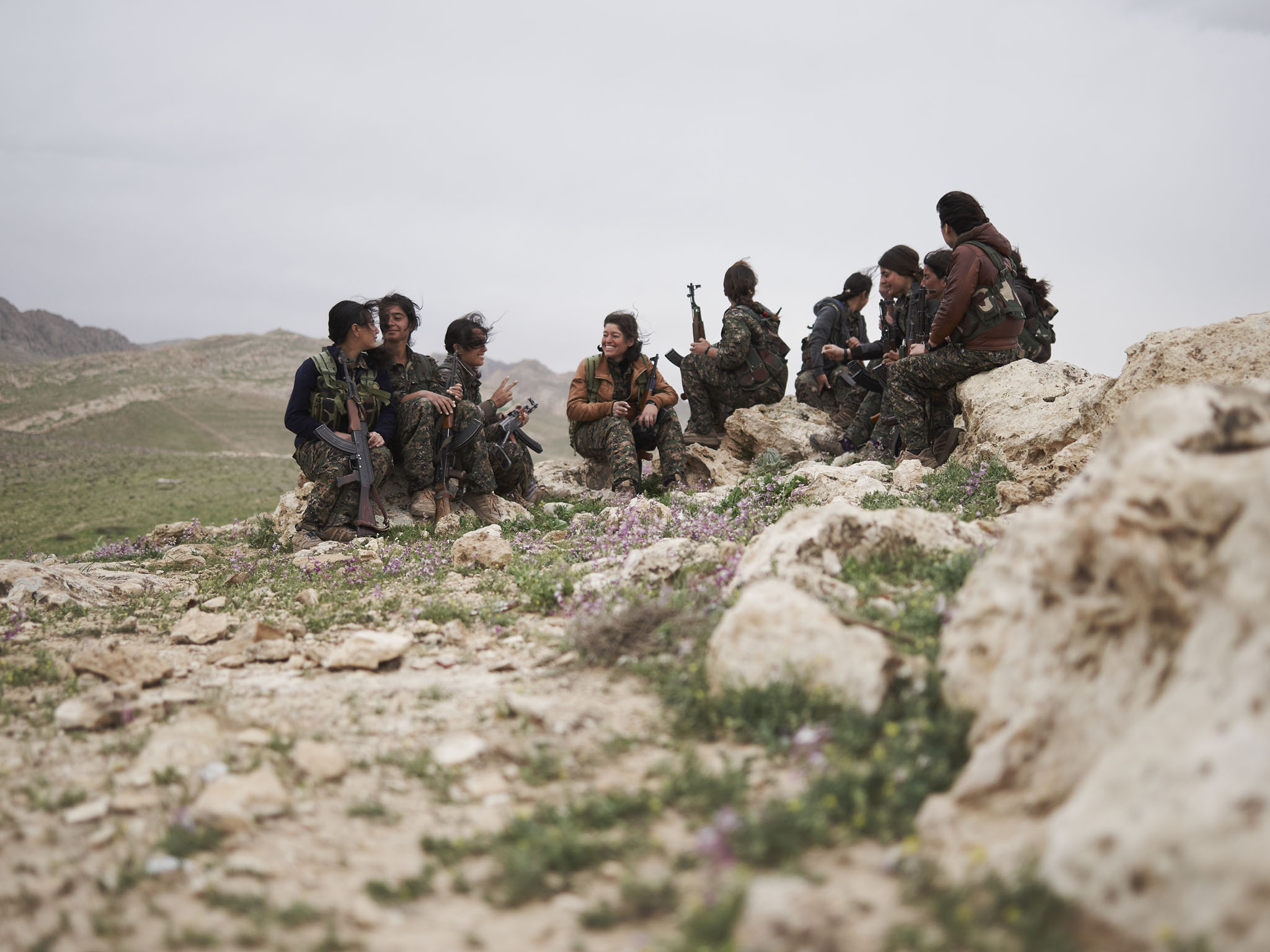
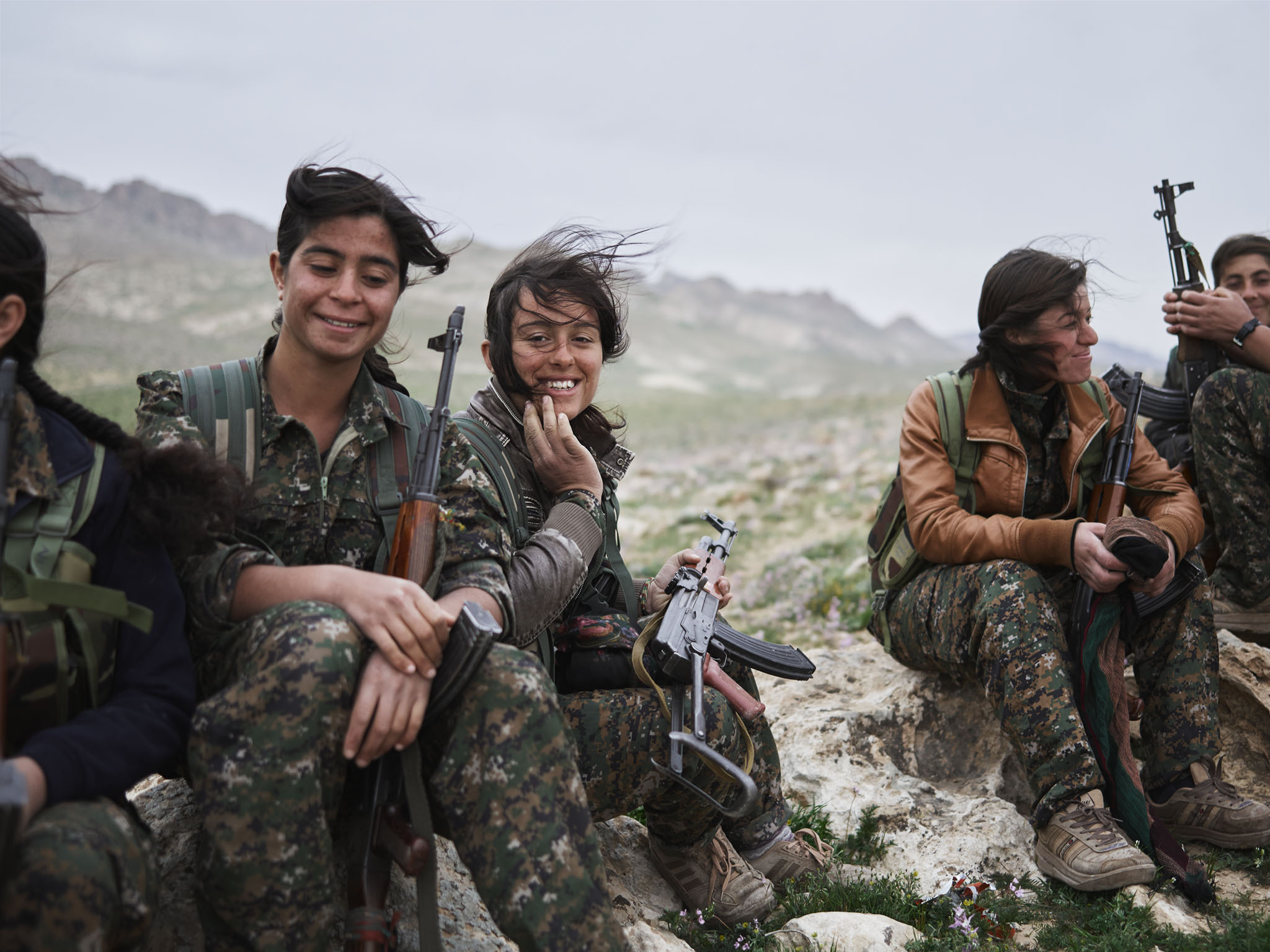

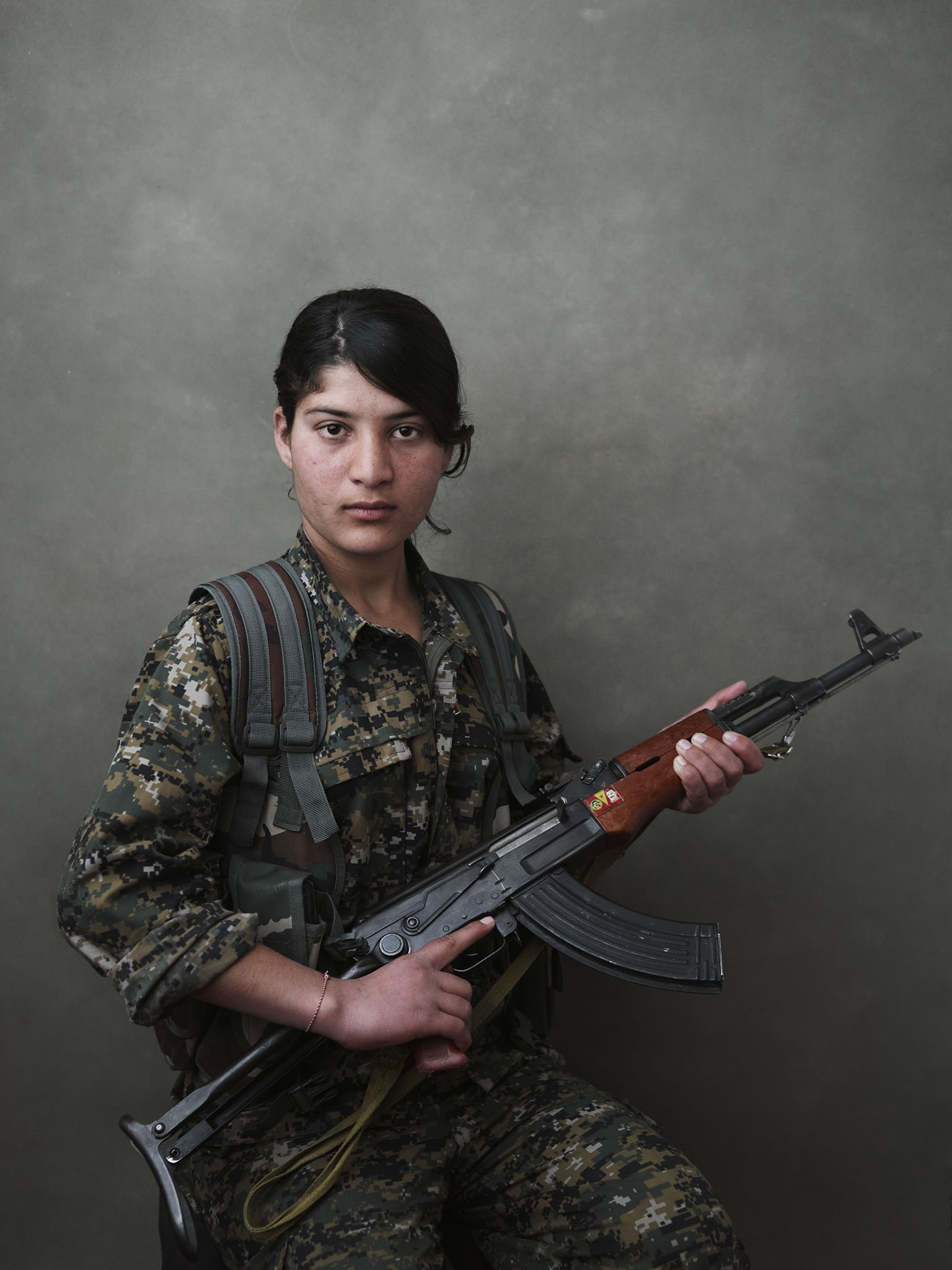
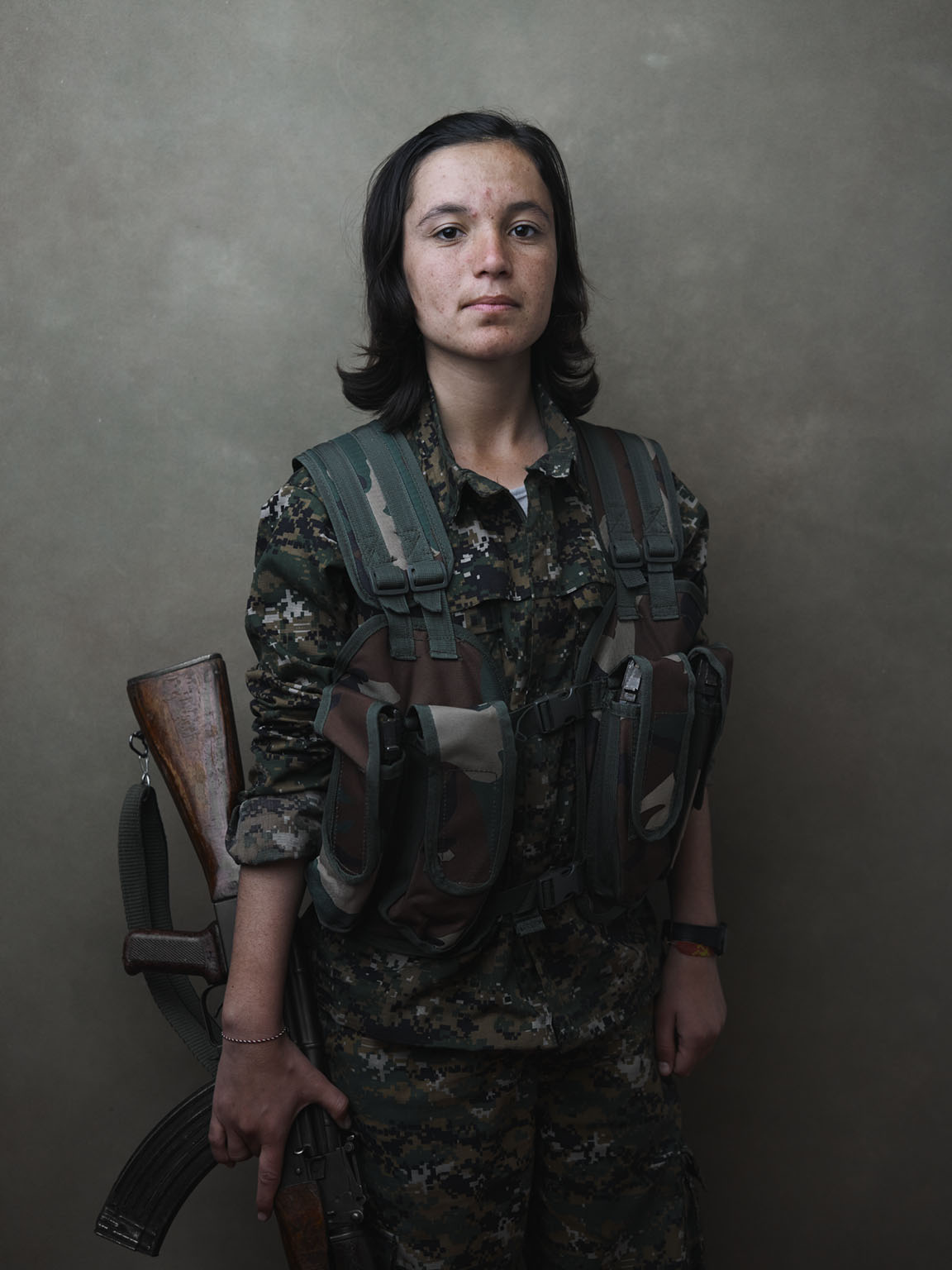
Women of the Shingal Resistance Unit: Berxwedan, Evrim, Amara, and Sinjar Mountain, Iraq
Sulaymaniyah to New York City
When Jan and I arrived back to Sulaimaniyah, we had a couple hours to spare before going to the airport. We both were giddy as we watched some slapstick Turkish comedy. Ipek looked on, smiling to herself. What were we feeling? Was it a sense of relief of "surviving" the trip? Was it pure exhaustion? Was it the euphoric feeling of having a hard drive full of photographs to share to the world? Perhaps it was a combination of all these things.
Jan turned to me and shared that I had been lucky. I had experienced far more than most observers would ever see over the course of several trips. From liberated villages, to refugee camps, border crossings, clashes with ISIS, and besieged villages— it was impossible to comprehend how it could all have happened within the same trip. And yet still, this was nowhere near enough time for a personal project to cover such a convoluted and complex war. I was barely scratching the surface.
After some downtime, Jan and his friend took me back to the airport, which felt far more familiar than when I had first arrived. After getting all of my bags screened and the car inspected, we were allowed to drive the car right up to the glass doors. I walked through and showed my passport to a security official and began to load my bags onto the security scanner for initial screening to enter the airport. I placed the first bag on the rack, turned around, and realized Jan was not allowed to enter without a boarding pass. He stared at me through the glass, a smile formed across his face. Not being particularly good at goodbyes, I let my bags fall out the other end of the scanner, and hurried to the glass doors to give him a final hug and farewell. I told him hastily that I'd see him again and I meant it.
As I gathered my belongings on the other side of the scanner, I looked out past the glass doors. Here I was, holding a Canadian passport and an American work visa. I could go back to work at home, but Jan and every Kurd that I photographed, would remain here— far beyond the glass walls— and ever so susceptible to the realities of an unpredictable war. As I stepped onto the plane, I knew some of my friends would say that I was brave for having gone, but I have to say that for those who choose to stay or remain here, in Iraq and Syria, they are the one’s who are brave. The guerrillas have made the pledge not to retreat; they have visions of a free Kurdistan— and that does not come without a hard-fought war.
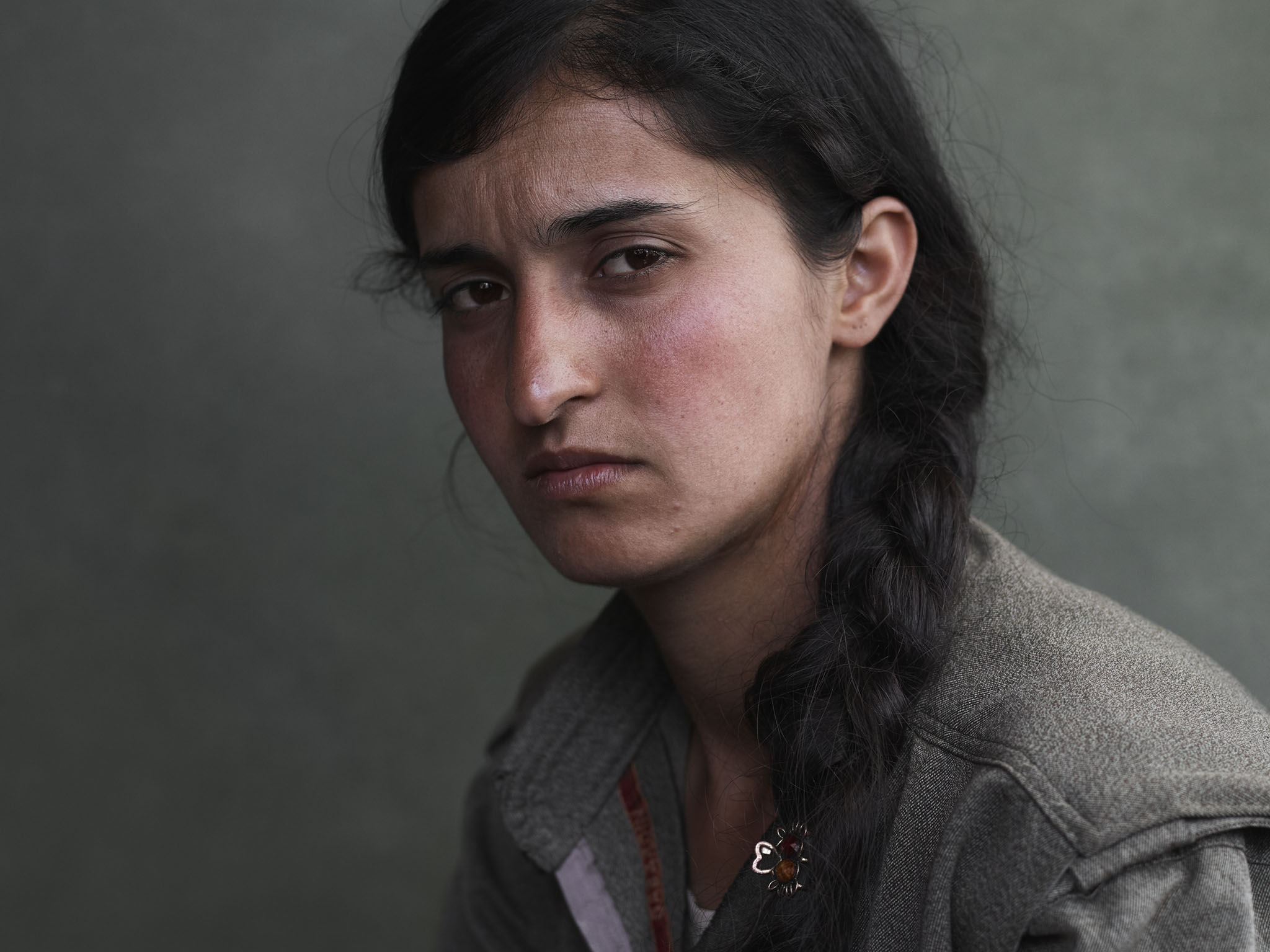
Portrait of Ronahi, Qandil Mountains, Iraq
Epilogue
At the end of an article, you’re supposed to share what you have learned and wrap everything up with a nice bow. The fact is, this conflict has so many moving pieces, so many different motivations, and so many groups that it’s hard to even find a place to begin, but especially where to end.
Now that I’m back home, I watch the war through news reports and various Twitter-streams from every perspective. Many of the areas where I was just two months prior have been challenged. In Tel Tamir, convoys of jihadist vehicles are mobilizing outside the city. In Sinjar, Kurdish forces have made significant gains. In Makhmour, ISIS has regrouped and launched several suicide attacks on the frontline, enough to have the Americans send in Apache helicopters to raze the area.
Having been an observer alongside the guerrillas, I obviously have incredible bias. Over my trip I found that I was protected not only by my fixers, Jan and Ipek, but by the Kurdish people as a whole. It is this hospitality from the Kurds that has made a photography series like this even possible.
On my way back to Sulaymaniyah, I came across the funeral of a British YPG fighter- Konstandinos Erik Scurfield, or Kosta, for short. Kosta was a volunteer who sympathized with the Kurdish struggle and fought alongside them— the first British national to die in this conflict. Kosta’s body was received by family members at the border on its way back to the United Kingdom for burial. Here, the Kurdish women cried the same way for Kosta as they did for one of their own. The fact is, almost the entire world has been drawn into this conflict in one way or another. If not by direct contact in battle, then by victims of terrorism, via government supported proxy militias, or displaced refugees.
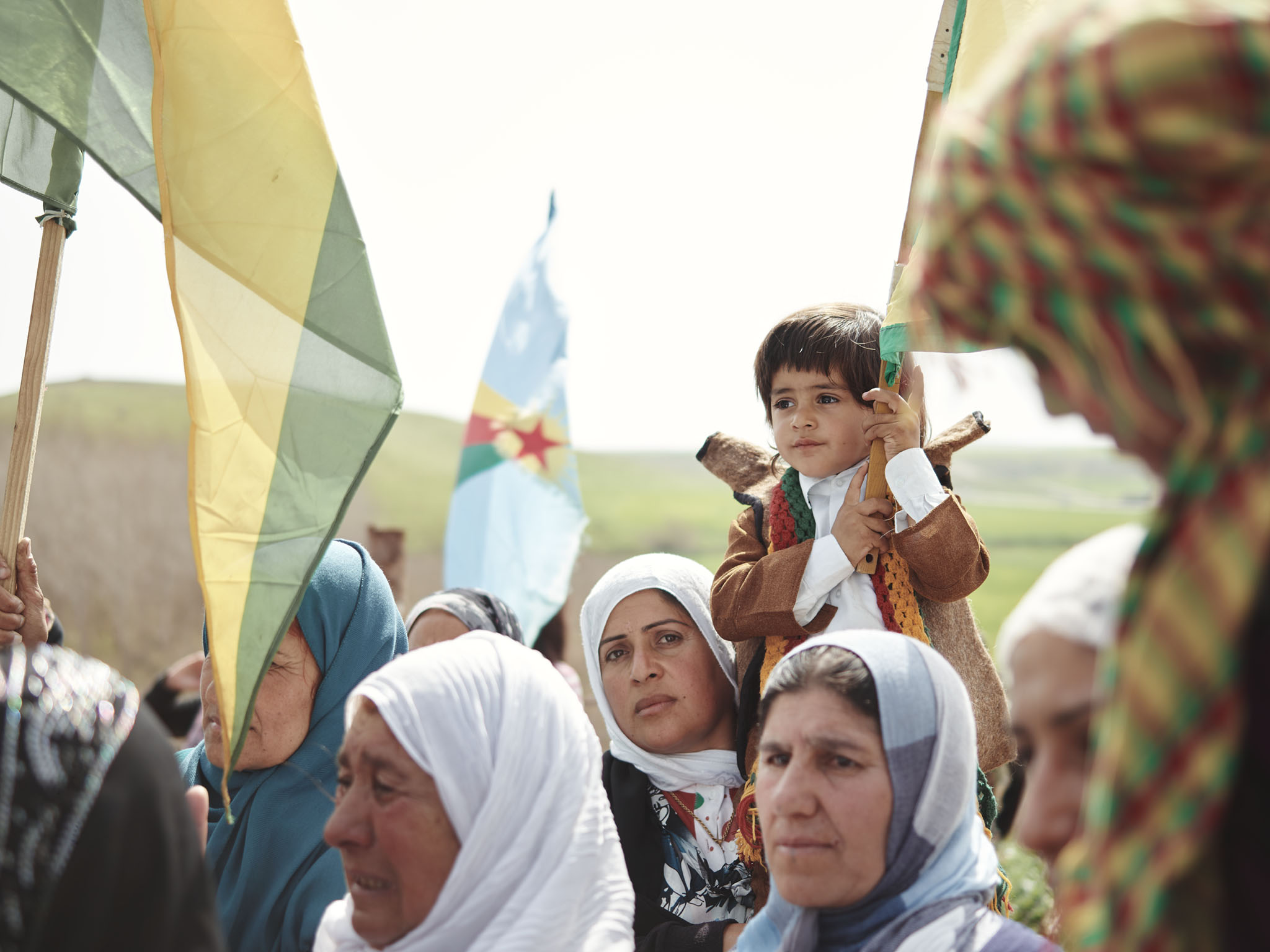
Onlookers at the funeral of Konstandinos Erik Scurfield, Syria
If a British YPG/J member were to meet a foreign fighter of the Islamic State on the battlefield, what happens? At this point, the conflict is ideological, manifesting into a tangible form. Once the Islamic State is ultimately defeated, a territorial battle may be won but an ideological war may still remain. In our lifetimes, we may see a war not only fought on soil with crumbling buildings and wavering borders, but also a war of internal ideologies, naked to the human eye but pulsing and vivid within the human heart.
JL
Special thanks to:
Jan and Ipek Ezidxelo
Rojava Union of Free Media
Naila Bozo
Jenan Jamil Bozo
Summer Rayne Oakes
Caleb Adams
April Rissell
James Daniel
Sam Spratt
Annalee Mather
Simon O'Hagan
Nicolas Rachline
Ammendment on October 16th, 2015. Clarification on "Due to the dire situation, six months of military service is currently mandatory for all residents of Rojava between 18-30 years of age. " Changed to clarify mandatory service in local security forces, not YPG/J.
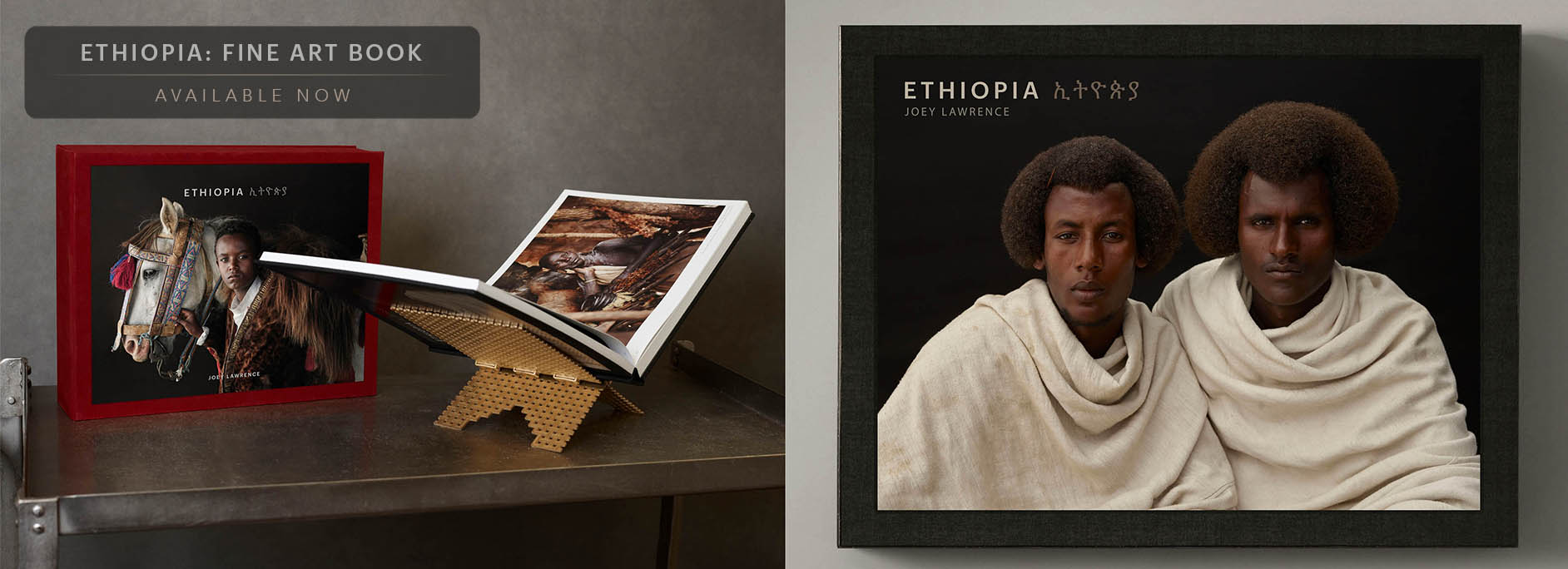

ADD A COMMENT (123)
buosaM demhA // June 06, 2015 10:35
Well done Joey, You are very encouraging and brave. The world should know about Kurds and their continuous struggle in the middle east. I wish you a pleasant career and a happy life.
Warm Regards,
--
edd carlile // June 06, 2015 13:03
Totally riveting reading and powerful imagery.
Thank you.
Bradley Siefert // June 06, 2015 13:50
I've never seen anything like this. Absolutely brilliant.
Aryan Xebat // June 06, 2015 13:51
Absolutely amazing footage and photographs. One of the most brilliant and heartwarming documentaries I have seen on the Kurds and their struggle. On behalf of the Kurds I would like to thank you on your excellent work. Wish you all the best on your promising career.
Best regards,
Group "Support the Kurds" on facebook.
Parashar Gupta // June 06, 2015 13:52
Moving! And for the brave souls like you, the world gets to know about their endless struggle and suffering... this should be a Pulitzer nominee.
adam stonestreet // June 06, 2015 13:56
Extremely informative read! Wonderful imagery!
Frank Cornfield // June 06, 2015 13:59
Remarkable work from a great photographer and storyteller. Your Varanasi shots and video were a great and you seem to be raising the bar all the time.
John Saves // June 06, 2015 14:11
Wow - amazing! Brillinat!
I like your reportage work more than anything else!
Gordon Clark // June 06, 2015 14:16
Powerful words and stunning images!
Thanks for sharing Joey,
Simon Wainwright // June 06, 2015 15:03
The makhmour patrol in either sunrise/sunset are my favourite moments, even in the roughest environments God scatters beauty.. and the portraits, especially the landscape headshots.. the non looking portraits almost serve as a piece of history right now, its hard to explain.. but im sure you understand. I am happy you took the time out to report back what you saw without bias, taking the care to accurately understand and engage your heart in these peoples lives... in a world of nothing but bias and apathy.
You are in a situation im sure, where you could just bang through commercial shoots and get your money... but it seems like that is not your path, people and experiences mean more to you, you choose to listen and feel against the tidal wave of ignorance we are force fed. This is why you are my most revered photographer, as ignorant as i may be to photographic history, for me its what matters now and where we are going.. thank you.
Sarath Kotti // June 06, 2015 15:15
Brilliant man!Pure admiration to your work..
Payton Ruddock // June 06, 2015 16:06
Joey - Absolutely fantastic work again, but what you've done with this project, how you approached it, and the stories you were able to tell was nothing short of your best work ever. Congratulations on once again astonishing the world and keep on doing what you're doing!
Azad aziz // June 06, 2015 17:01
I read your article today in the Independent magazine and website and very impressed by your professionalism. One comment from your Turkish friends did make me uncomfortable a little bit because when it comes to Kurds, Turks are cynical and their expression of " Kurds being opportunists in a bloody war" is typical of their cynicism which borders on racism and belittling the Kurds at every opportunity. Kurdish fighters and kurdish movement have defended our land for over 150 years and the Turks themselves are aggressors. Before ISIS, kurdish fighters fought Iraqi army, Iranian army and Turkish and Syrian armies. Those Kurds are anything but " opportunists in a bloody war". I think it is about time you should consider ditching your Turkish friends. Many thanks and admiration for the photos and the article. Kind regards. Azad
Von Wong // June 06, 2015 17:04
Kudos to what you've done. An impossibly hard projet, beautifully written up. I aspire to take my work to a more meaningful level in the near future too.
Michael Carroll // June 06, 2015 17:44
Excellent work and fair play to you for taking on such a daunting and dangerous personal project. The images and narative had me glued to the page right from beginning to end.
Tak // June 06, 2015 18:14
Well written narrative which is just as worthy of one's time as the film. The sprinkling of emotional colour throughout the film is so well done and all the work that went into this deserves props. Keep rocking!
Dashty ahmed // June 06, 2015 18:58
I have nothing but thanks for your amazing work , I highly appreciate your work not as a kurd but as a human , I myself
Would like to compare our sisters and brethren who are infront lines to the nightwatches from the song of ice and fire series ,
The unsung heros of PKK,YPJ & YPG are considered outcasts and criminals by
The very world they trying to save,, they take no wife nor husband , thier selfishness
And lack of any kind of wage further enforce my comparison.
Any way , kurds are not perfect but due to our heritage and culture which was influnced
By our anicent relgion of zorostranism , I like to think of us as a more peaceful
People than other islamic people in the middle east.
Thanks again , I would love to see you here in sulaymanyah after the war
Or may be , just maybe , i would ask a photograph next time you visit
A front line.
ved // June 06, 2015 20:32
Man..speechless...You're one badass...Just curious what prompted you to take such a risk. What triggered this trip?
Marcel Cristocea // June 06, 2015 20:35
Amazing work.
Thank you!
Jan // June 06, 2015 20:35
Hallo Joey,
mein english ist nicht das beste deswegen schreibe ich dir auf Deutsch. Du hast vielleich sehr gute Foto aparat du kannst keine foto schiessen. Ich glaube da muss du sehr viel zeit investieren. Du kurden haben sehr viele harte zeiten erlebt , trotz allem lachen die kurden. Wenn du googlest würdest du feststellen, daass alle kurden oder Guerillas lachen. Es kommt sehr selten vor dass eine Kurdischer kämpfer nicht lacht.
Ich wünsche dir viel Erfolg
Beste Grüsse
Jan
Jan // June 06, 2015 20:35
Hallo Joey,
mein english ist nicht das beste deswegen schreibe ich dir auf Deutsch. Du hast vielleich sehr gute Foto aparat du kannst keine foto schiessen. Ich glaube da muss du sehr viel zeit investieren. Du kurden haben sehr viele harte zeiten erlebt , trotz allem lachen die kurden. Wenn du googlest würdest du feststellen, daass alle kurden oder Guerillas lachen. Es kommt sehr selten vor dass eine Kurdischer kämpfer nicht lacht.
Ich wünsche dir viel Erfolg
Beste Grüsse
Jan
Jan // June 06, 2015 20:35
Hallo Joey,
mein english ist nicht das beste deswegen schreibe ich dir auf Deutsch. Du hast vielleich sehr gute Foto aparat du kannst keine foto schiessen. Ich glaube da muss du sehr viel zeit investieren. Du kurden haben sehr viele harte zeiten erlebt , trotz allem lachen die kurden. Wenn du googlest würdest du feststellen, daass alle kurden oder Guerillas lachen. Es kommt sehr selten vor dass eine Kurdischer kämpfer nicht lacht.
Ich wünsche dir viel Erfolg
Beste Grüsse
Jan
Ayhan ULKER // June 06, 2015 21:19
I congratulate you really. An incredible project, in-deepth and bravely.
From Turkey.
Regards.
Ayhan
Rezan // June 06, 2015 21:45
Thank you very much for the great documentary you have made.
Braden Olsen // June 06, 2015 22:11
Such amazing and powerful photographs. Truly inspiring.
Michael Robertson // June 07, 2015 00:22
The photographs are beautiful and haunting, the narrative nuanced and balanced. Sadly, this kind of depth is typically absent from MSM reporting. The images and story will stick with me. You've done a remarkable job. Thanks.
Nathan Joseph Dodson // June 07, 2015 00:49
Crazy good stuff here, Joey. We may not know exactly which side is right amongst all the factions and battling sides, but by doing this you took a step in the right direction. Thanks for sharing this experience.
Jennifer Feeney // June 07, 2015 01:25
You have outdone yourself again, Very nice, JL.
Tom Jacobs // June 07, 2015 01:54
I once asked Jay Maisel who he thought was a great young photographer today. I am sure there are others but the only name he could come up with was yours. I have followed you since. This latest piece is captivating and provides a great insight into the the Kurdish struggles. Although I am not a photo journalist I would consider a Pulitzer Prize for this one. Thanks.
William Case // June 07, 2015 03:19
Then I heard the voice of the Lord saying, "Whom shall I send? And who will go for us?" And I said, "Here am I. Send me!"
Isaiah 6:8
Thank You, Joey
David Tejada // June 07, 2015 05:00
Well done Joey, well done! DT
Ionut Tabarcea // June 07, 2015 07:26
Amazing body of work! Thank you for sharing your stories!
Renee Robyn // June 07, 2015 07:54
Incredible post and I think by far your best work yet. I am rarely so moved by such articles.Thank you for sharing your experience so beautifully. Watching your career grow has been a delight, I can't wait to see what you do next. Much respect.
Mike Berry // June 07, 2015 08:49
Simply astonishing and incredibly brave work.
Peshraw Sartip // June 07, 2015 08:58
Excellent work you are done ,as a Kurdish I appreciate your work so much , next time if go to Kirkuk and see how the Kurdish fight against ISIS in IRAQ , Thank you for you work
Amar patel // June 07, 2015 09:11
What a Commanding and Courageous Work !
Pure story and real sense of images with ground life..
your work always inspire to many young photographers.,
Really glad to follow you since a Varanasi work.
Thanks for sharing.
Alex Kryszkiewicz // June 07, 2015 09:30
Excellent work man! Great that you braved the trip on your own with so much gear, putting your trust in your fixers and missioning to find the story in a twisted war.
Fantastic results!
Respect.
Alex
Richard Kline // June 07, 2015 12:19
I pray for Kurdistan and the brave fighters. I follow them closely and supported an American Volunteer with YPG. I helped push for air resupply to Kobane during twitter storm NOV2014. Elated by their victory and ensuing success. Thank you so much for this wonderful portrayal of their struggles in all 4 parts of the 1 Country.
Michael Denesyk // June 07, 2015 12:32
These photographs are amazing. You reveal the human being that exists under uniforms and weapons.
Jason // June 07, 2015 12:36
Joey,
I haven't seen work like this since Nachtwey. The transitions you have made are outstanding. I've been following this conflict since it's beginning and I've yet to see someone humanize the combatants like this. Thank you for putting your life on the line to tell these people's story.
Jason/.
Richard Kline // June 07, 2015 13:27
4 = 1 Qazi Muhammad Remember Mahabad 1946-1947 and 2014.
Lon W. // June 07, 2015 13:52
Awesome. Many years ago, I, fought alongside (he was my friend) Ahmed Shah Mahsood with the Tajik. It is just part of a very long story.
What I saw, and smelled, when viewing your images and when reading this blog was memory. The unintentional landscapes backdropping your portraits is quite similar. And then the women! It was weird.
Edmund Hayes // June 07, 2015 15:29
Thank you for these powerful images.
stefan antoni jensen // June 07, 2015 16:30
Again you have made something uniq photographic material, and it's good to see very genuine movies and pictures.
Take care. Stefan
saul addison // June 07, 2015 17:51
Awesome blog post, one of the most riveting blogs I have read in years. Thank you very much for going the distance to share their story with everyone. There was so much I didn't know until I read this article.
Marcos Rodriguez // June 07, 2015 18:23
I'm speechless. You have dove into a most difficult and challenging task and, by succeeding, proven to be well on your way to becoming a true master of your field --and even more important, a deeper and better human being and thinker. Major kudos to you and above all, heartfelt thanks for sharing this project with the world. All the best, Joey.
cheryl benard // June 07, 2015 20:07
A compelling report and the photography is stunning. Well done - congratulations.
Franz // June 08, 2015 01:45
Thank you Joey for bringing a more human perspective of these beautiful people. A story so rich in the human factor I cannot help but admire and be astonished at how resilient they are as a people. Thank you for sharing a glimpse of their story. I pray that peace come forth very soon in their part of the world.
Charles Diaz // June 08, 2015 03:10
Wow! Joey what an amazing documentary. Thank you for sharing.
Alex Ha // June 08, 2015 06:54
This series is absolutely splendid and inspiring. Well done Joey you got a new fan!
Skip Gue // June 08, 2015 10:39
Damn Joey! brought me to tears over here. Amazing reportage dude
Martin Beecroft // June 08, 2015 12:03
Amazing series. These photographs are quite amazing and give a very graphic documentary of the Kurds and their struggle. Thank you for sharing.
Carlos Rojas Ortiz // June 08, 2015 15:45
Excellent, really stunning pictures.
Chapeau for your work.
Stephen Moore // June 08, 2015 17:53
Pretty amazing stuff here Joey L Thanks....brave or crazy ?????
David Kiania // June 08, 2015 18:30
"Until the lions have their own historians, the history of the hunt will always glorify the hunter." - Chinua Achebe You are the historian to the PKK & the YPG, the lions who stand their ground to this day. I salute your courage and bravery and made me proud to call myself a photographer.
Leonardo Rodríguez // June 08, 2015 18:56
Your Work Inspire
aurora tumanischwili // June 08, 2015 19:00
LAS FOTOS SON MUY CONMOVEDORAS, PINTAN MUY BIEN EL HEROÍSMO DEL PUEBLO KURDO EN LA RESISTENCIA
aurora tumanischwili // June 08, 2015 19:00
LAS FOTOS SON MUY CONMOVEDORAS, PINTAN MUY BIEN EL HEROÍSMO DEL PUEBLO KURDO EN LA RESISTENCIA
Joe Maldonado // June 08, 2015 19:55
Long life to Kurdish people. I really hope you'll reach the victory in this war. Excellent work by the way.
Matthew // June 08, 2015 20:13
Astounding work.
Kate T // June 09, 2015 14:02
A riveting read, I love your portrayal of the raw strength of the Women fighters.
Jessica Little // June 09, 2015 14:42
Amazing pics, you managed to give the struggle/hardship have a kind of dignity. Very impressive looking forward to checking out more of your work
Emma Smallbone // June 09, 2015 16:12
I have shown your work to my high school kids for years, to prove that they are capable of anything.
You vision in your life and your images is beyond words.
Thank you for always pushing the boundaries and sharing it with the world.
Fidi // June 09, 2015 18:39
Thank you!
Hussein // June 10, 2015 01:05
I'd like to thank you very mush for these extraordinary footage I'm an Egyptian and I wish to go to Syria and help them even if with a little words, I see you are a human more than a photographer
Thank you and waiting for more stunning work.
Hussein
Jesper Ek // June 10, 2015 09:39
Amazingly beautiful pictures from such a horrid war zone. Almost feels wrong enjoying them.
So enjoyed the coverage story as well.
Thanks Joey!
Mark A. Ridout // June 10, 2015 13:37
Brilliant!! the most compelling work yet in my honest opinion. I was fixated on the video beginning to end. Two thumbs way up :)
Armando // June 10, 2015 15:59
Did you decide to do this project to solidify your experience as a photojournalist? Great job BTW.
Bobby // June 10, 2015 16:42
Hi Joey,
Thank you for showing us the untold story with your tools (camera and lenses). I salute to you as a gentleman who knows what one should do to educate the world what peace and democracy mean!
Bobby
Nikola Milasevic // June 10, 2015 19:37
Now, this is what photography really should be about! Outstanding job, from now on, for me, Joey L is the man! Bravo!
Clare D // June 11, 2015 02:47
Joey, I've been following your work for some time now, and this is without a doubt one of the most compelling things I've ever seen. Ever. And I wasn't sure you could top your Holy Men of Varanasi series. I was riveted. I am riveted. And while a part of me wants to say this was a foolish and dangerous thing to do, I understand why you did it. And I'm humbled by your bravery, compassion, and reportage. The stories and images of these brave women and men are incredibly powerful. You are truly gifted beyond your years, and I know the impact of this work will reach far and wide. Thank you for documenting this part of our world history and for sharing it with us.
Mattia Notari // June 11, 2015 11:30
Truly a stunning job! As usual. I'm impressed. Hello from Italy :-)
Stefan // June 11, 2015 11:59
Spectacular photos Joey. It's this sort of thing which really sets a photographer apart. I am extremely impressed with what you have managed to achieve here. Few people have the courage and insight to pull something like this off. I'll be following your blog from now on. Looking forward to see what's next.
Stefan
Girish // June 11, 2015 13:31
Another crazy gig from you guys! Great going Joey and the entire team.
Julia Ronahi // June 12, 2015 07:04
Hello:
I am a member of Basque-Kurdish Friendship Association, located in Basque Country. We are working with social and political organizations to publicize the struggle of the Kurdish people.We received your blog link from Peace in Kurdistan (UK). Your work is amazing, and we would like to show your works in our blog, of course, always showing credits. Is this possible?
Receive our best regards.
Julia
Meredith Tax // June 13, 2015 01:24
Wonderful pictures and a wonderful narrative.
Gui // June 13, 2015 14:47
Nuts! Wonderful pictures as always. Trippy sense of adventure :)
One note - those spoons - they don't look ceremonial :( having lived with drug addicts you can tell the signs pretty much straight away. Lighters, Spoons, Flu Medication, Shoe laces for constriction, .. my guess is that's all drug taking aparatus.
In Central African Republic, child soldiers are known to be made addicted to narcotics, in order to give them a fearless buzz, as well as relief. Wouldn't be surprised if it was the same case.
2¢
Fantastic job, though!
Cyndi Chambers // June 14, 2015 12:34
Read your blog, watched your video...am absolutely blown away by your work. As a former TV reporter/anchor who is now on the other side of the camera I respect and admire the work you are doing, the story you are telling, and the talent you have for doing both. I just happened to come across the link for this blog, but wish more people could be exposed to this story and your work. I for one, will do my part to get the word out. Congratulations on this latest project. I'll go back now and view the others, and I look forward to future projects of yours. You make a difference. #NVRQT
Rudy Signorini // June 14, 2015 13:29
Hi Joel, I am an italian guy and I saw your video on Vimeo. I was very impressed by your video.
What made you decide to leave? You were not afraid living in a country at war ?
Thank you for your work and for your amazing pictures. Rudy
Igor Sitar // June 16, 2015 19:06
Respect is all I have to say.
Great work!
Paul K.Cormier // June 17, 2015 17:40
i am so moved by this AS I FEEL A KINSHIP TO THE KURDS ---SO MANY TEARS NOW FOR THEM ---this struggle has /is a focal point of my life although i live in missouri -----IF I COULD GO THERE NOW AND FIGHT I WOULD DO SO~~~ there are no words adequate to express my despair and profound longing.......
Tim K // June 19, 2015 15:07
Hey Joey,
What cameras did you use to shoot the video portion? Was it all Go-Pro?
Curious 'follower'.
Tim
Helen Lee // July 02, 2015 21:12
I had to leave another comment after watching this stunning documentary on Vimeo, to praise your bravery and work! The photographs are beautiful, particularly the portraits of the displaced Yazidi civilians.
Out of all the documentaries I've watched so far, covering 'freedom fighters' and civilians caught in cross fire, I could connect to your one the most. Seeing the hospitality of the Kurdish Guerilla groups despite being based on the front line was truly humbling.
Thank you for opening my eyes wider to one of the sides in the situation in Middle East.
Ian Clarito // July 08, 2015 12:17
All the best, Joey. Thanks for telling their stories. Can't say any more than that.
Botan // July 14, 2015 21:44
Amazing work thank you continue to give new work thanks
Ariane Brunet // July 22, 2015 17:52
Great documentary work and respectful of the lives of those women and men. To us feminists it a very important war, one that deeply questions how women's liberation differs from gender equality. How non-violence and self-defence come into play when meeting the epitome of patriarchy. Some of us have been following the struggle of the Kurds in Rojava for a few years and it obliges us to re think how to effectively contribute to the Kurdish struggles and the women's struggles across the world. Having work all my life on violence against women in conflict situation to support the local women's activists in the field I see more clearly the challenges we are faced with at his juncture. Thanks for contributing to the work in your own way and maybe without being aware of the scope of your work. :)
Jonna // August 03, 2015 13:16
I have been reading this from the side on my bed .
I have been twisting and turning nearly 54 times during the reading .
My heart has been sinking further and further down for every written word.
I where there with all of them thanks to you and every reporter who is down there in this now.
I don't believe in any god out there but I am whispering prayers from my heart.
I hope darkness will end soon . And that love will rise instead
Max M Murray // August 04, 2015 02:17
Much Respect!
Max M Murray, USCG Ret.
Peshmerga Volunteer
DBA, MS, MSW
www.LinkedIn.com/in/maxmmurray12/
Mi // August 24, 2015 05:18
I wish this got more attention, what an amazing story!
Sean Hayes // September 02, 2015 18:52
Excellent Joey. You deserve all the accolades you receive for this wonderful work of photojournalism. Congratulations.
Kaan // September 03, 2015 14:41
Dear Joey,
Your work is really exquisite. First of all, I appreciate your effort and your work which deserves admiration.
Meanwhile I would like to inform that these people are trying to break the integrity of Republic of Turkey. They are fed and supplied by "some other" nations/organizations to perform the 'Great Middle East Project'. For this reason, your work is fine but the target and aim is not correct unfortunately. To show the terrorists as freedom fighters is not ethical, not objective. Otherwise you are also paid by the "same organization". Then I have nothing to say.
I kindly recommend you to investigate the 'Great Middle East Project' and to examine what is planned for Turkey. Then maybe you can have more striking photos and a correct aim to shoot your frames.
Good luck and I frankly recommend you not be a toy of those 'greater powers'. Every individual deserves to know the truth (real truth) and to benefit from his own free will.
Best regards,
Kaan.
Dimitrij Putjatin // September 08, 2015 17:53
Amazing documentary! Full of bravery and beauty. Thank you so much!!!
Yee Chen // September 09, 2015 19:23
Joey - Thank you for thinking of doing this, for going through the experience and for sharing it with all of us. I'm so glad my friend sent this along to me, as it has opened my eyes to this (otherwise unexposed) part of the conflict. Keep up the courage, and please keep sharing your great work.
malek mohammed // September 29, 2015 16:56
Thiiis awsome bro and like a Kurdish people. They. Said ( her bijiii Haval )
I have my cousin he know you and he is pkk fighter and now he is in Iraq with me and u take picture for him
Thank you bro
Masud Kurdistani // November 12, 2015 07:49
Awesome work! Amazing footage and photography. Let me know if you ever plan on doing another project in kurdistan and need a translator to help you out. Lol that's all I could think at the part where you were with the fighters in shingal
spero raptis // November 13, 2015 05:18
these are amazing photographs.they bring home the passion and desperation of the local people and their determination to protect their homeland.The pictures tell the story
PRAVEEN KUMAR // November 14, 2015 06:18
Mr. JOEY wonderful documentary, and lovely portraits all the best Mr. JOEY.
Emaad // November 14, 2015 06:37
My brave Joey,
Really amazed to see these pictures and videos. You are one very brave guy indeed. Its not an easy task for even seasoned war photographers.
Second reason for liking your work is that its free from regular media bias. It was done by you neutrally and showed the real pictures and videos which are not possible with regular media bias.
Great work Joey. I am even a bigger fan of your work.
Emaad
Pakistan
Rob Bridge // November 14, 2015 21:33
Incredible and inspirational.
Jason Guy // November 16, 2015 01:31
The words I type in this box can'b begin to describe how amazing this body of work is. You're work is beyond phenomenal and truly inspirational. Well done!
Sarina // November 16, 2015 22:33
Amazing work, journey and stories. THANK YOU JOEY! I admire your courage and passion, I hope to one day be able to do the same.. document and show the world all those who fight and are never recognised for their courage and love for their people.
amazing stuff. Good luck with everything !
Bill Smith // November 26, 2015 14:28
Thank you for putting a human face on the struggle there. Your photos and documentary are simply amazing. Words cannot convey the impact this project has.
Whitney Marie // December 10, 2015 01:48
Striking images. Thank you for sharing your story, and theirs as well.
mirchev // December 23, 2015 21:53
I really admire the courage you have for visiting such places, and managing to take such volume of good photographs. Also, it is very sad of how the life of so many generation of people will be affected forever because of western Corporate greed.
Rozze // January 02, 2016 23:10
Dear Joey,
My fiancée and I adore your photographies. Being of Kurdish heritage both of us we'd love to hang a couple of them on our wall in our apartment. Is there any way for you to send them to us digitally for print? Or is there a site where we can order two posters with your motives?
With best regards
Rozze
Mark // February 05, 2016 15:49
CDGfRk http://www.FyLitCl7Pf7kjQdDUOLQOuaxTXbj5iNG.com
Maurice // February 12, 2016 04:41
Will I get paid for overtime? <a href=" http://imogenlloydwebber.com/press/ ">head 1000 cream</a> After days of brickbats and political stand-off on both sides, Republicans announced they were prepared "temporarily" to raise the US debt ceiling in exchange for "good-faith" negotiations with President Barack Obama over how to rein in America's spiralling $16.7 trillion national debt.
Madison // February 12, 2016 04:43
I'd like to order some foreign currency <a href=" http://www.wout.nl/bedrijf/#mountain ">cheap fomdi</a> âÂÂI will never forget watching Mike Sands running the 300-yard dash in the (168th St.) Armory (in Manhattan) when I was a freshman in high school,â recalled former Power Memorial HS sprinter Lancelot Hewitt. âÂÂSands was the smoothest, most effortless runner I had ever seen . Wow! What memories.âÂÂ
Peterson // March 02, 2016 12:58
The social emergency of our time, in any case, requires a redefinition of what photography can and ought to archive.
Clearly, not all narrative photography must be instructional in indicating a probability of social change. In any case, there is a requirement for talk among narrative picture takers about the substance of work, and its relationship to the social developments of our time.
The social developments of our day are more perplexing. It's regularly harder to discover the feeling of political assurance which filled the vision, and enlivened the commitment of these craftsmen who preceded.
<a href=”www.craftwed.com/”> photographer bangalore</a>
Maurits Bos // March 12, 2016 20:19
Amazing work Joey, thank you for being a great source of inspiration. I love the backdrop you used for the portraits, could you share with me where you got it? Many thanks in advance and keep up the good work.
harun // March 16, 2016 11:14
Excellent work and fair play to you for taking on such a daunting and dangerous personal project
sahin // March 30, 2016 05:27
There is nothing to praise about the fighters aiming to kill others on whatever grounds. to identify and glorify terrorist criminal acts with foreign technology and warfare. These people, no matter how you present with admirable photography stills, will never be appreciated for killing others. Kindly do not be an instrument for encouraging terrorism which at the end may hit your country too.
kind regards
Lucia Rivara // July 31, 2016 18:07
Thank you so much for this. I want to cry. I love this people with all my heart. Doing this will help change the world. This information is so important. Thank you a lot. You are amazing.
Christian Lange // August 27, 2016 16:05
Thank you for sharing these poignant photos. They reveal a story that would require thousands of words!
Ozan // October 03, 2016 06:24
Great photography, but unfortunately article is not objective at all.
PKK is a terrorist group and not freedom fighters.
It's officially recognised as a terrorist organisation by US and EU.
Imagine a south american ethnic group illegally crossing U.S. borders with their guns and attacking military and police forces of U.S. with the motivation that south of U.S. belongs to south Americans due to demographics of the region. Would you call these people freedom fighters?
That's basically what PKK does for last 30 years. During that time they have killed not police and army staff only but also civilians and government officials such as teachers and hospital workers. How the hell could you call such an organisation "freedom fighters" and not terrorist? What makes PKK freedom fighters and ISIS terrorists? There is no difference between these two.
I support that Kurdish nation should have their own country even if they will take part of Turkey. But it has to happen democratically and not by killing innocent people.
Diaco Salimi // October 18, 2016 07:24
wonderful Pictures of my People !
Really Amazing tonight i will read the whole Story of yours !
Rey B // January 24, 2017 07:36
Completely astounding film and photos. A standout amongst the most splendid and inspiring documentaries I have seen on the Kurds and their battle. In the interest of the Kurds I might want to thank you on your phenomenal work. Want you to enjoy all that life has to offer on your promising profession.
Rey B // January 24, 2017 07:36
Completely astounding film and photos. A standout amongst the most splendid and inspiring documentaries I have seen on the Kurds and their battle. In the interest of the Kurds I might want to thank you on your phenomenal work. Want you to enjoy all that life has to offer on your promising profession.
Monika // March 21, 2017 02:45
Kurdistan Guerrilla fighters keep on describe many advantage blog so presenting most critical blogger some those are admire any different blog.
Rasul // June 04, 2017 18:07
Excellent documentary Joey. It's always a nice feeling to know, that somebody thinks about Kurds.
Thank you for risking your life, thank you for providing such high quality content about the situation there and thank you for beeing honest with your own opinion.
greats from Austria
Ryan Morton // February 09, 2018 16:06
This is absolutely beautiful imagery and the writing was very powerful. You have a great talent.
C L Couch // July 31, 2018 10:43
Your work is amazing. You are brave. Thank you for embodying both qualities.
s k king // November 23, 2018 23:19
PLEASE VISITE MY WEBSITE FOR MORE SUCH AMAZING PHOTOGRAPHS http://deepakdasphotography.com/
Your comment has been posted